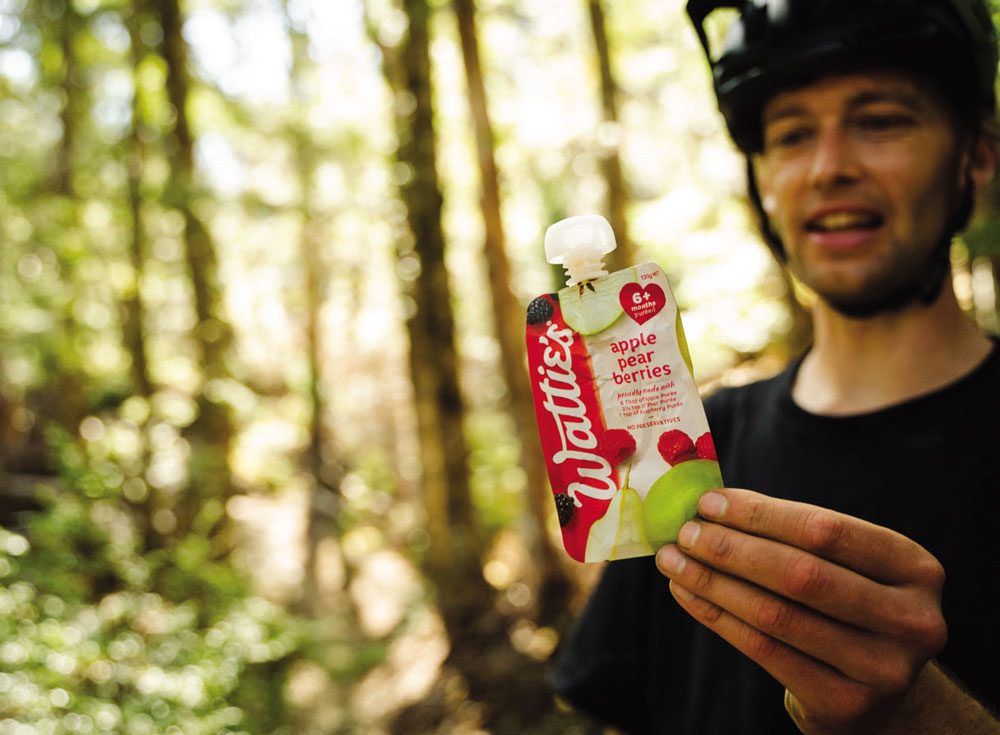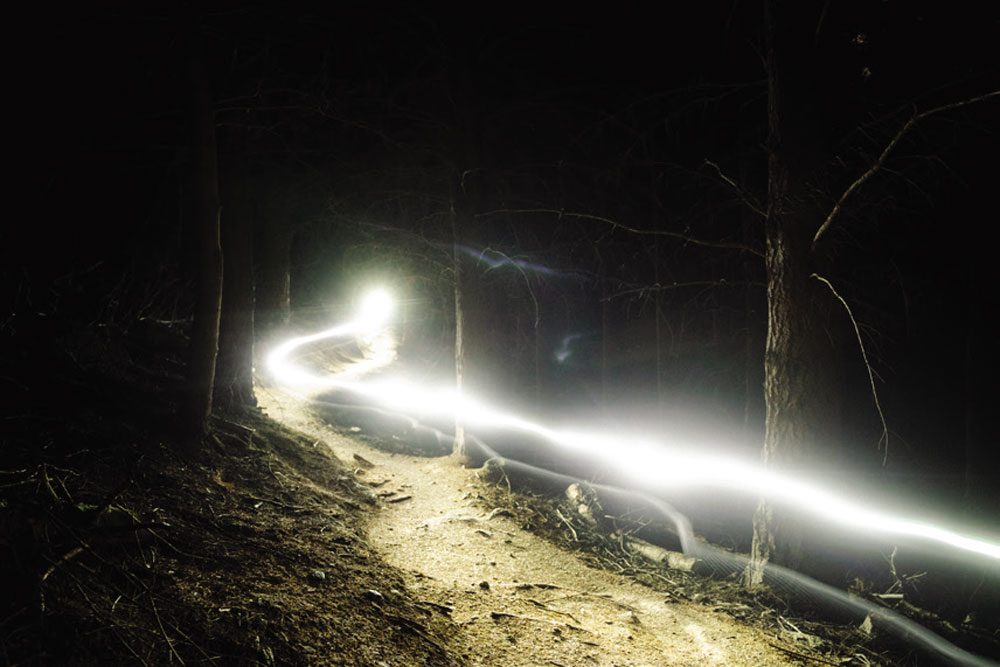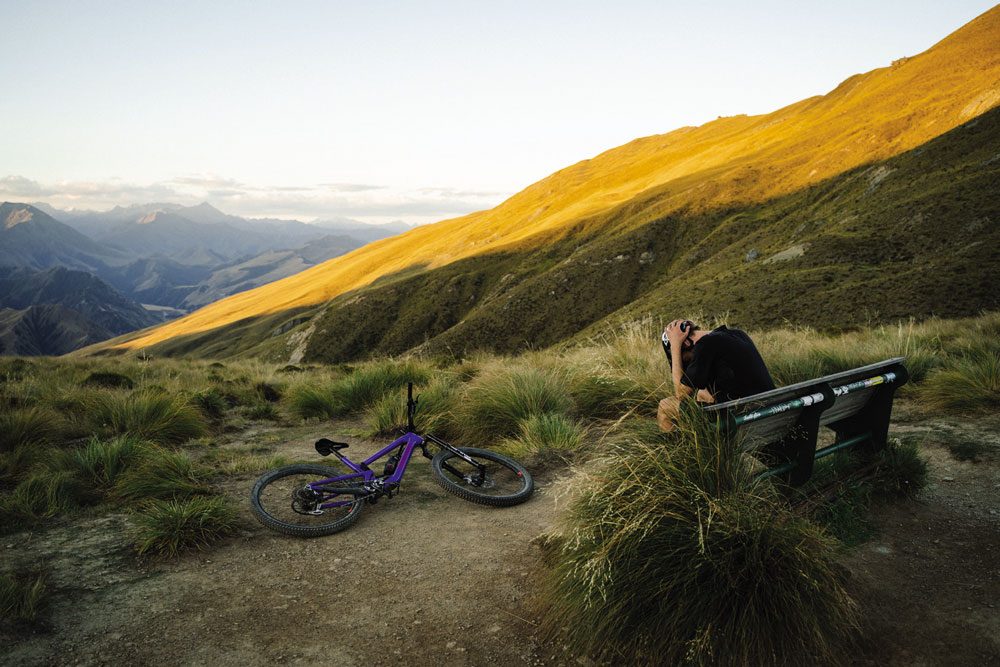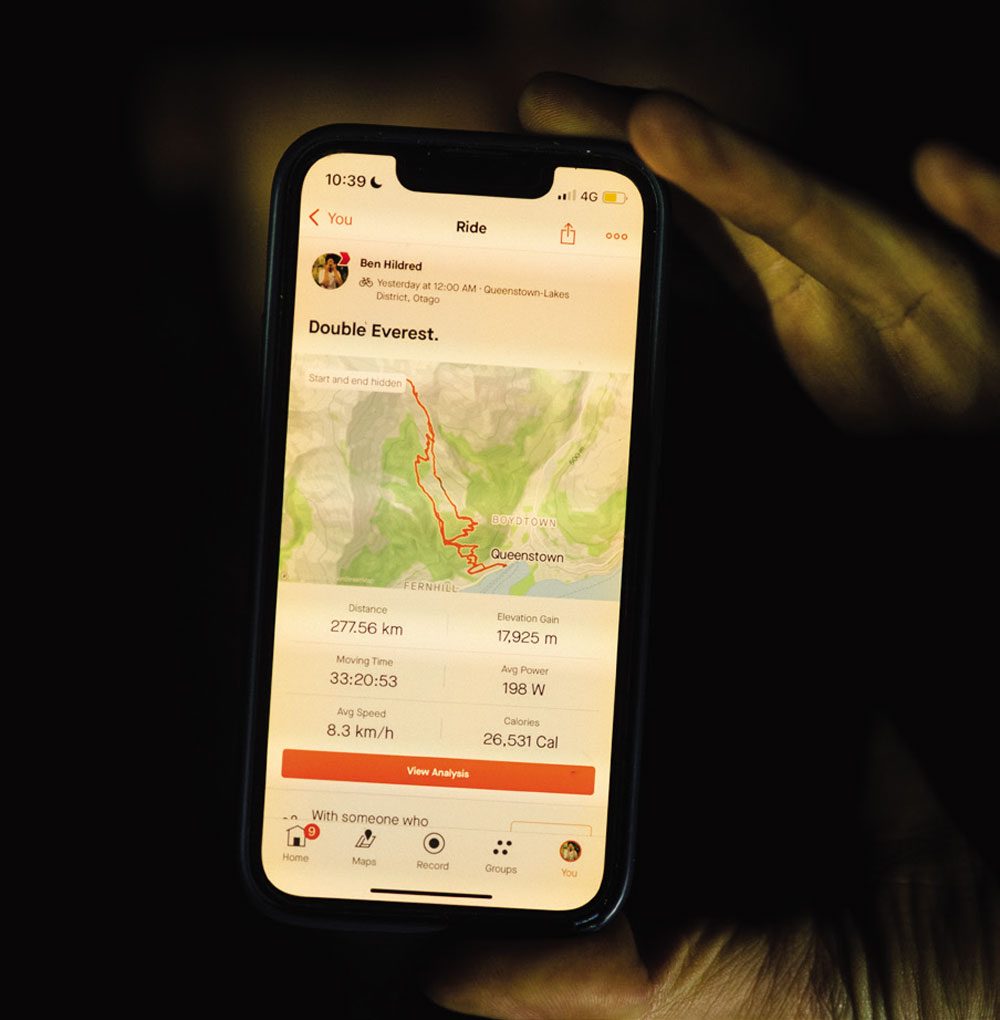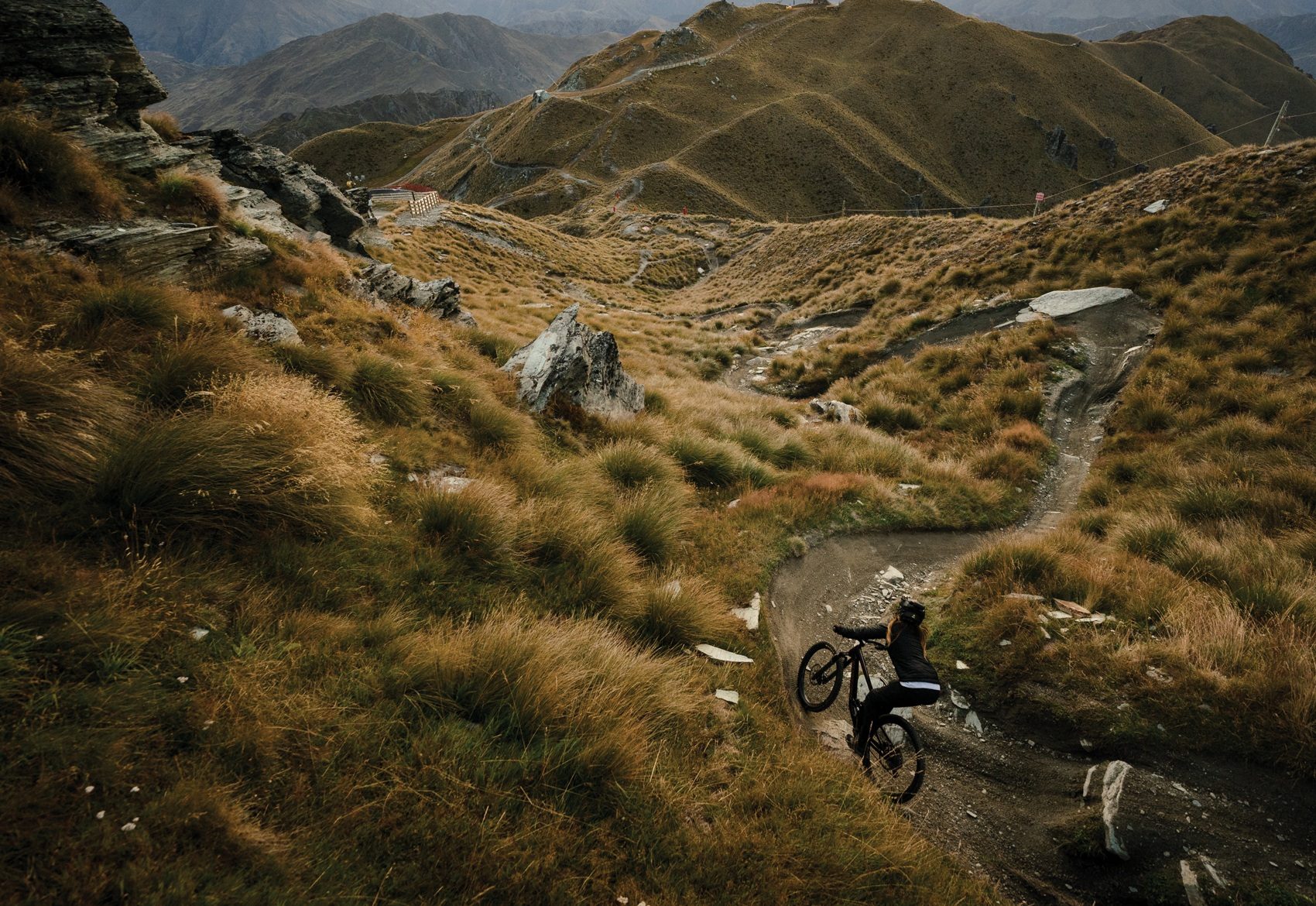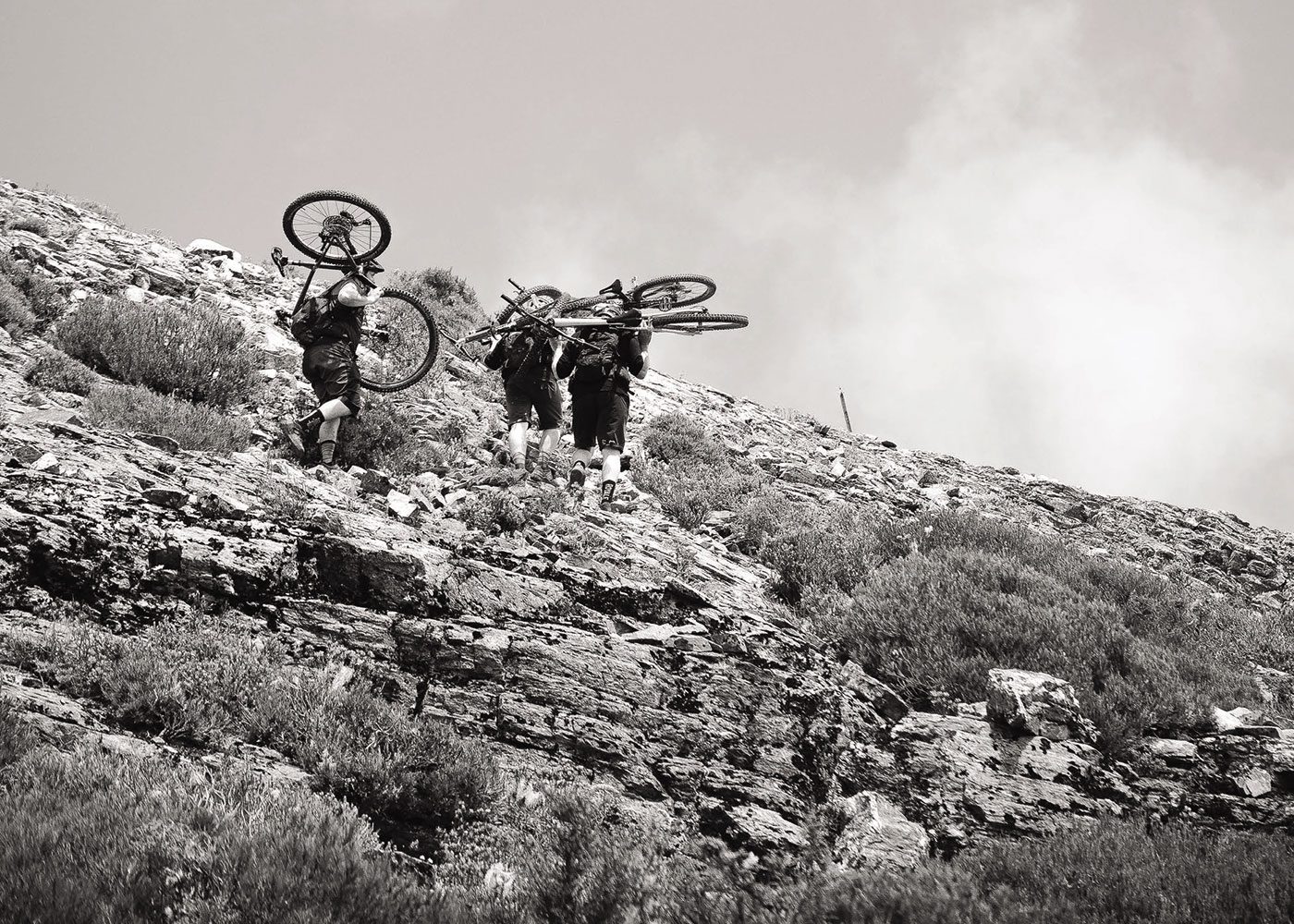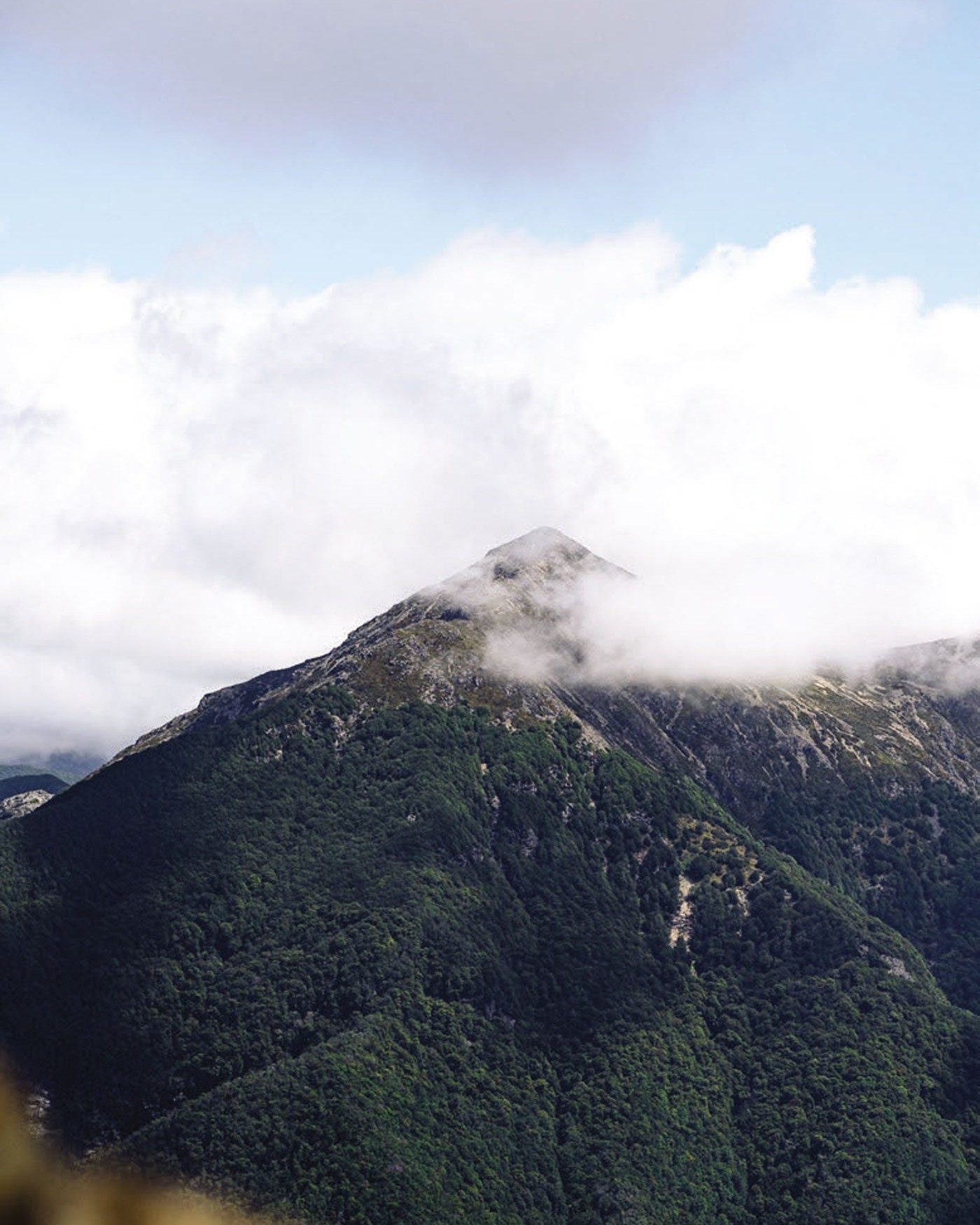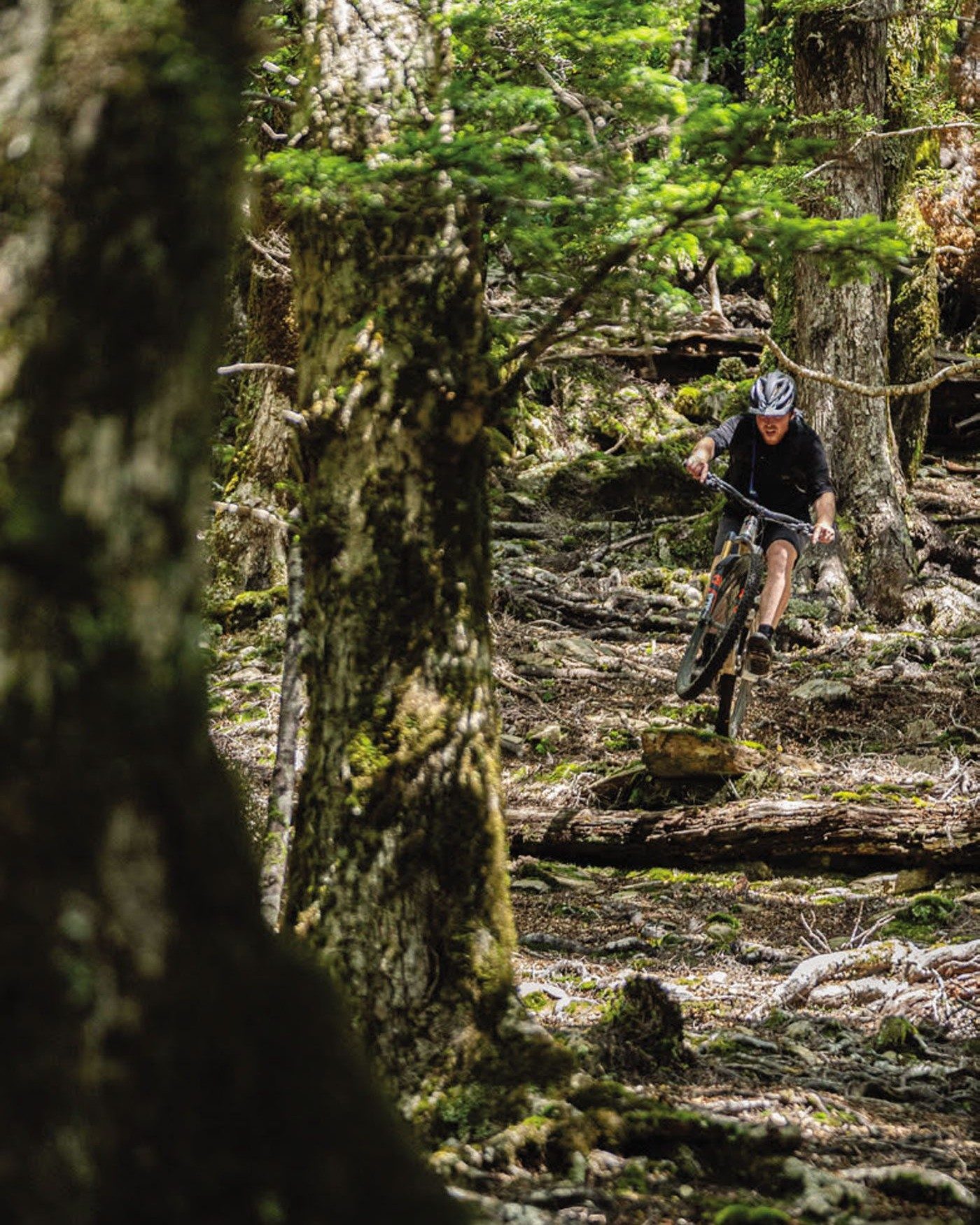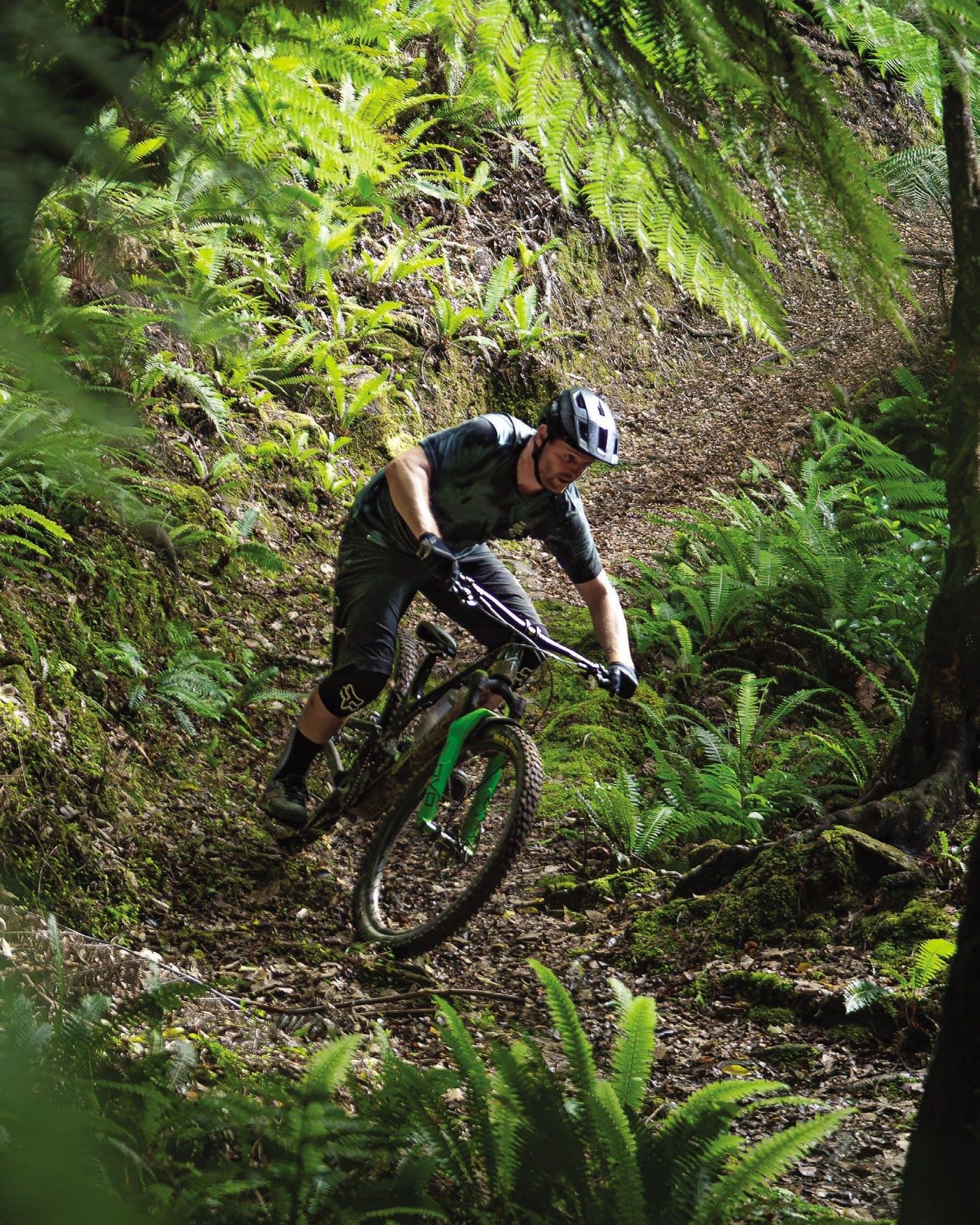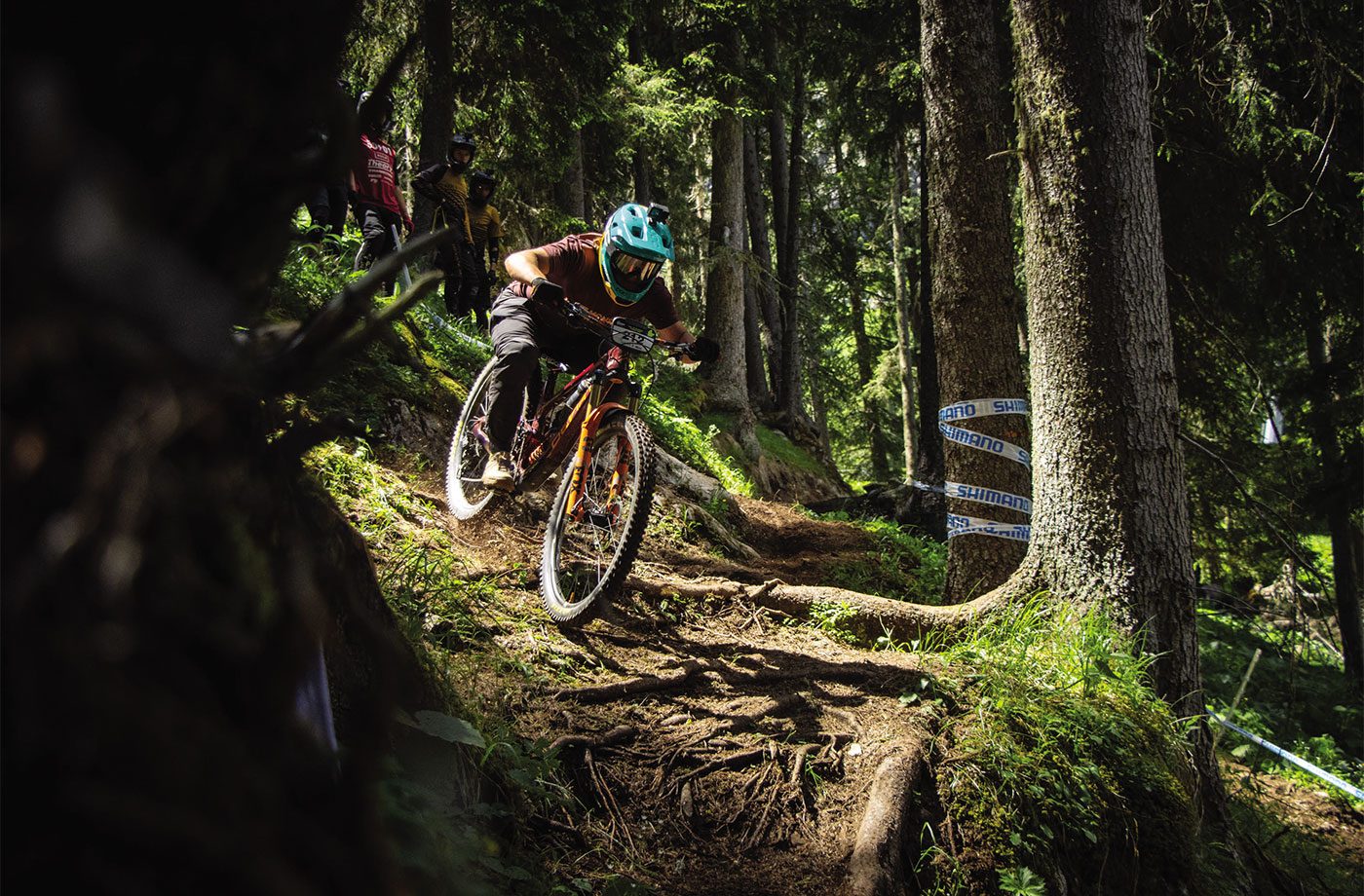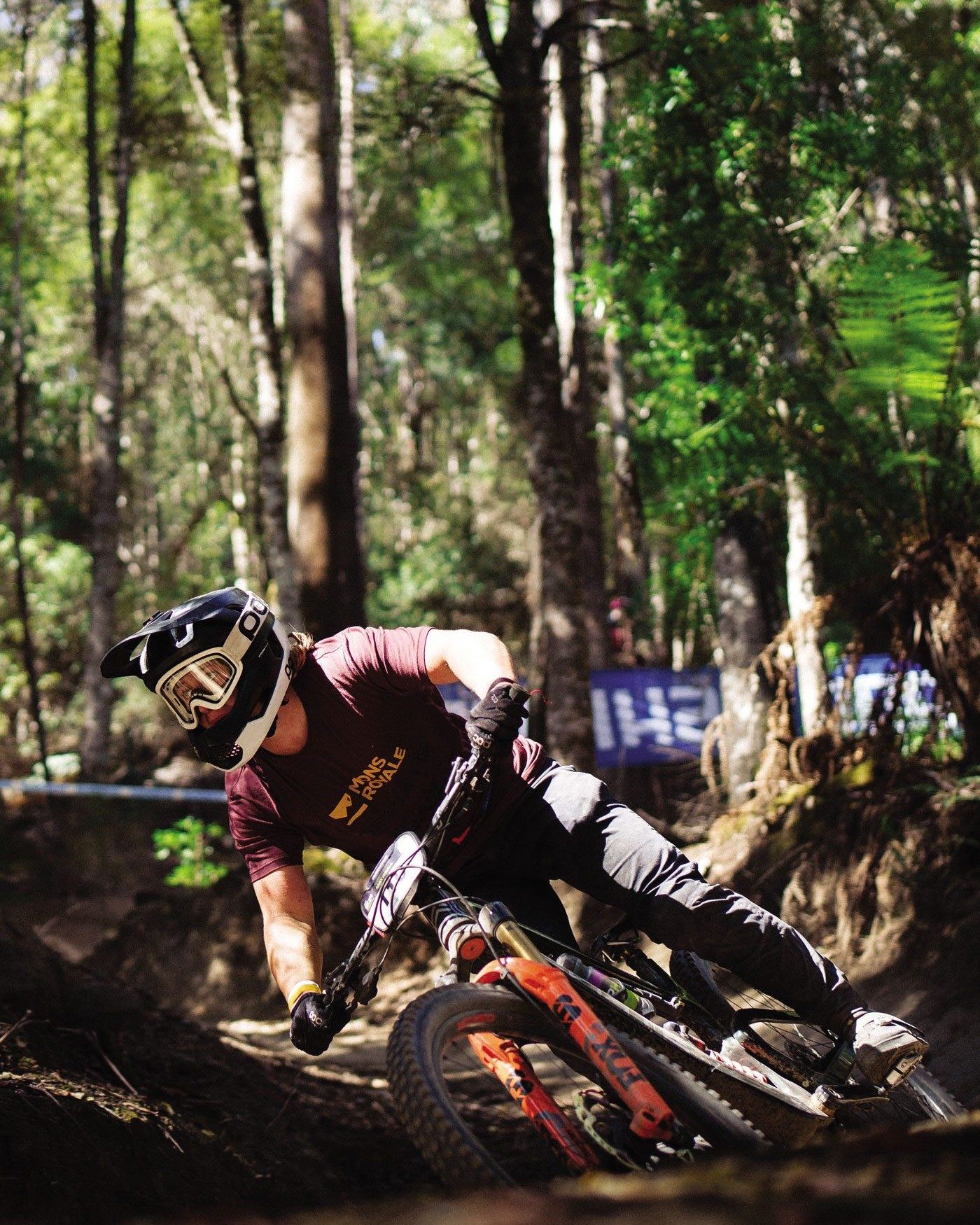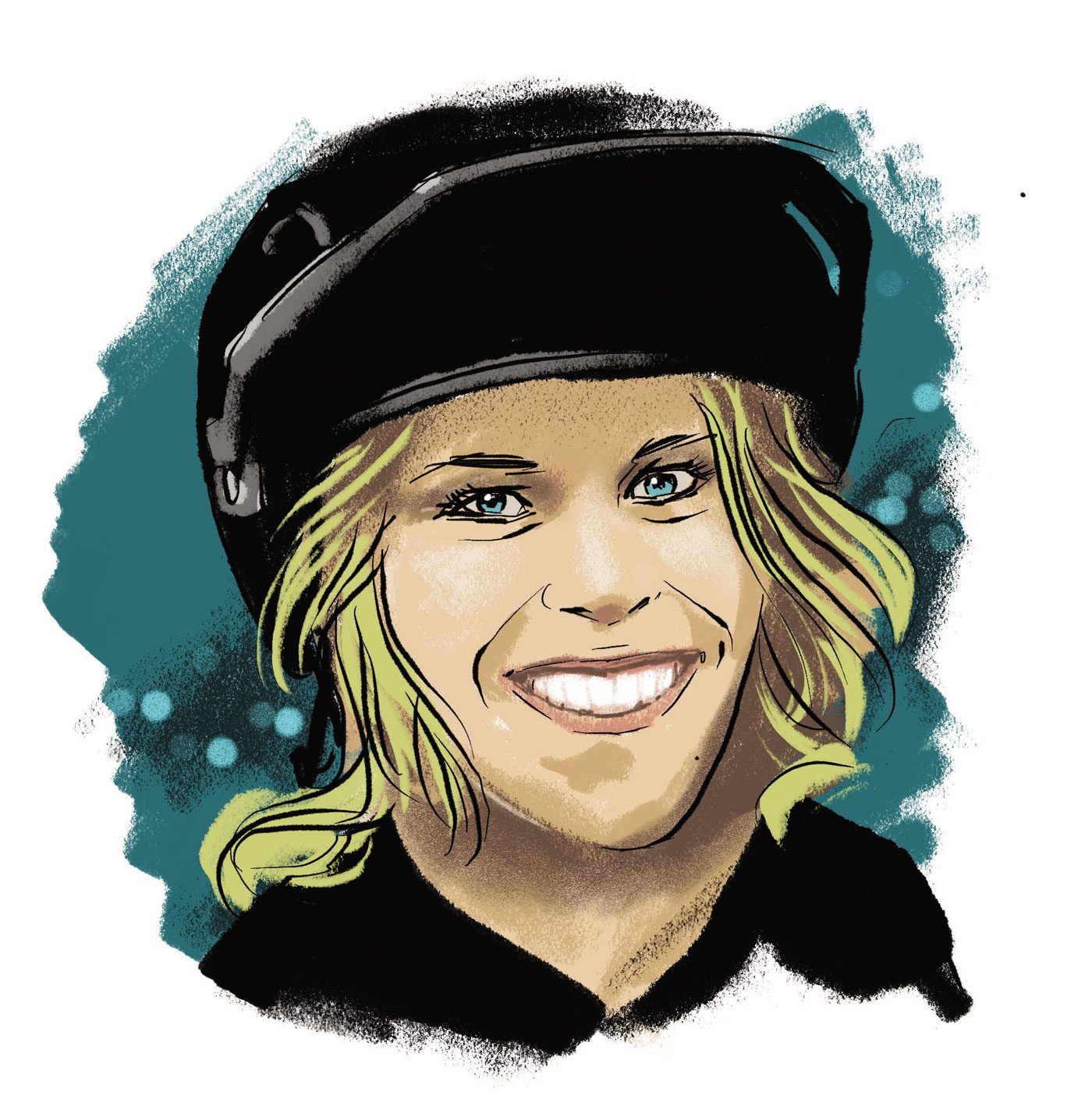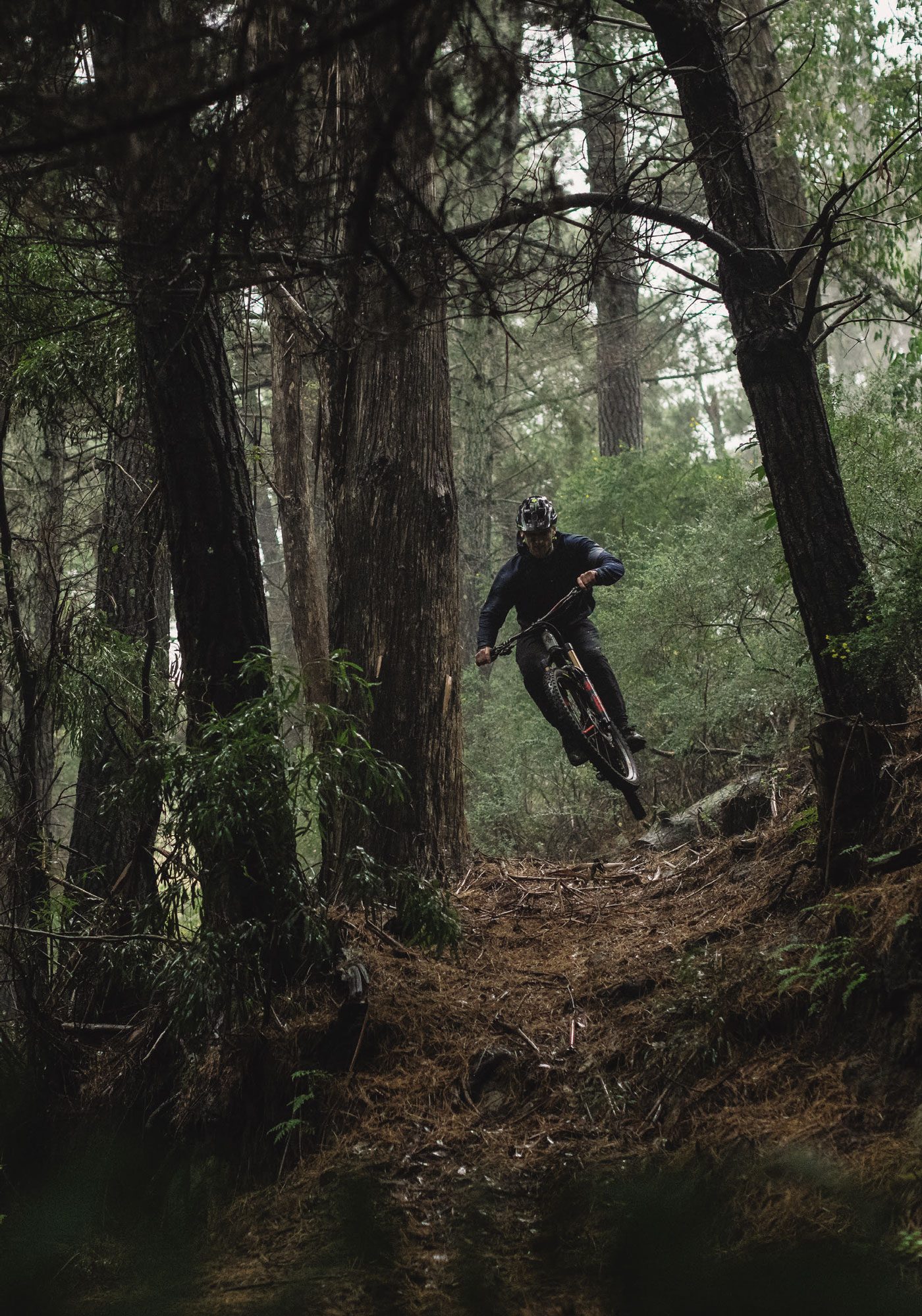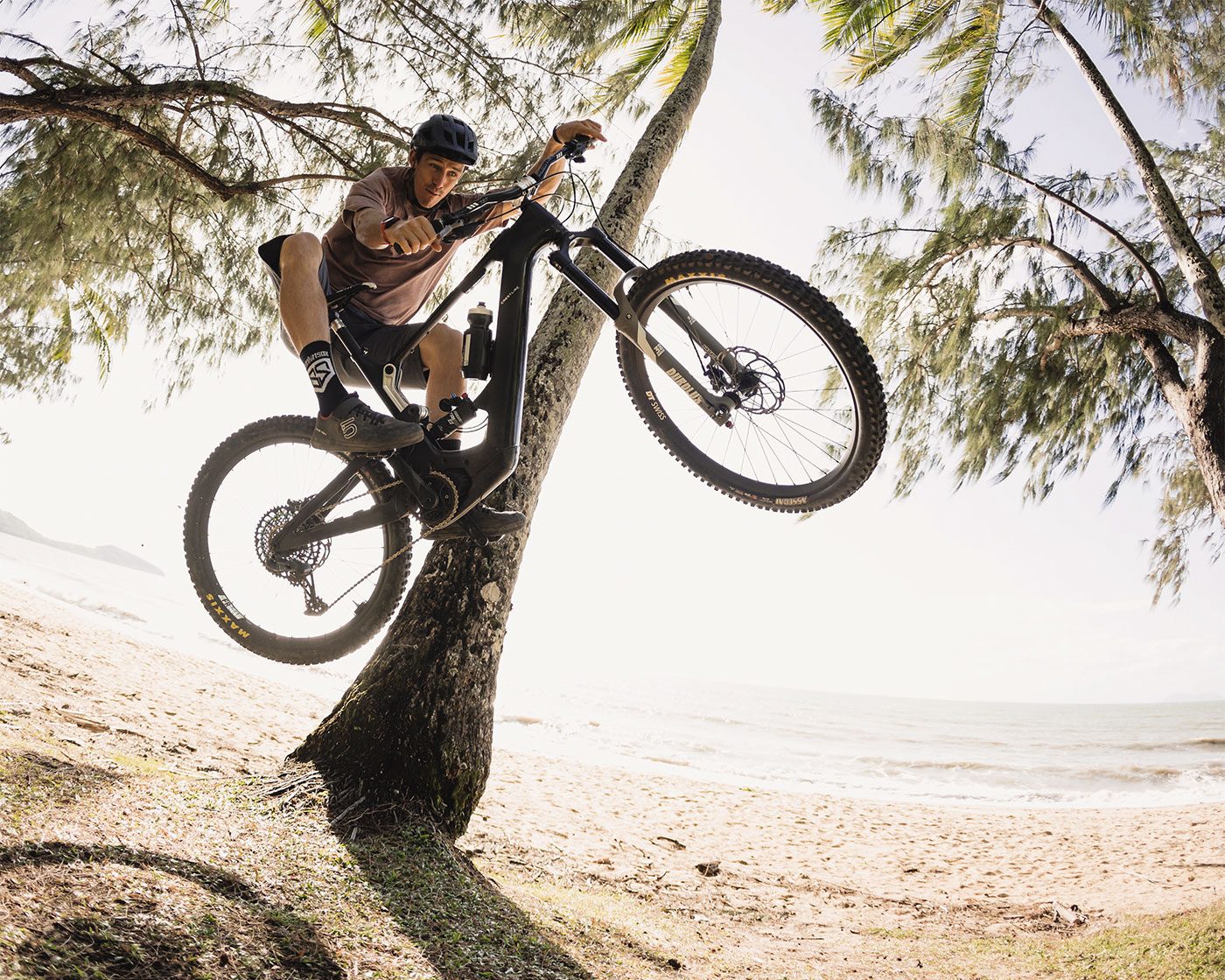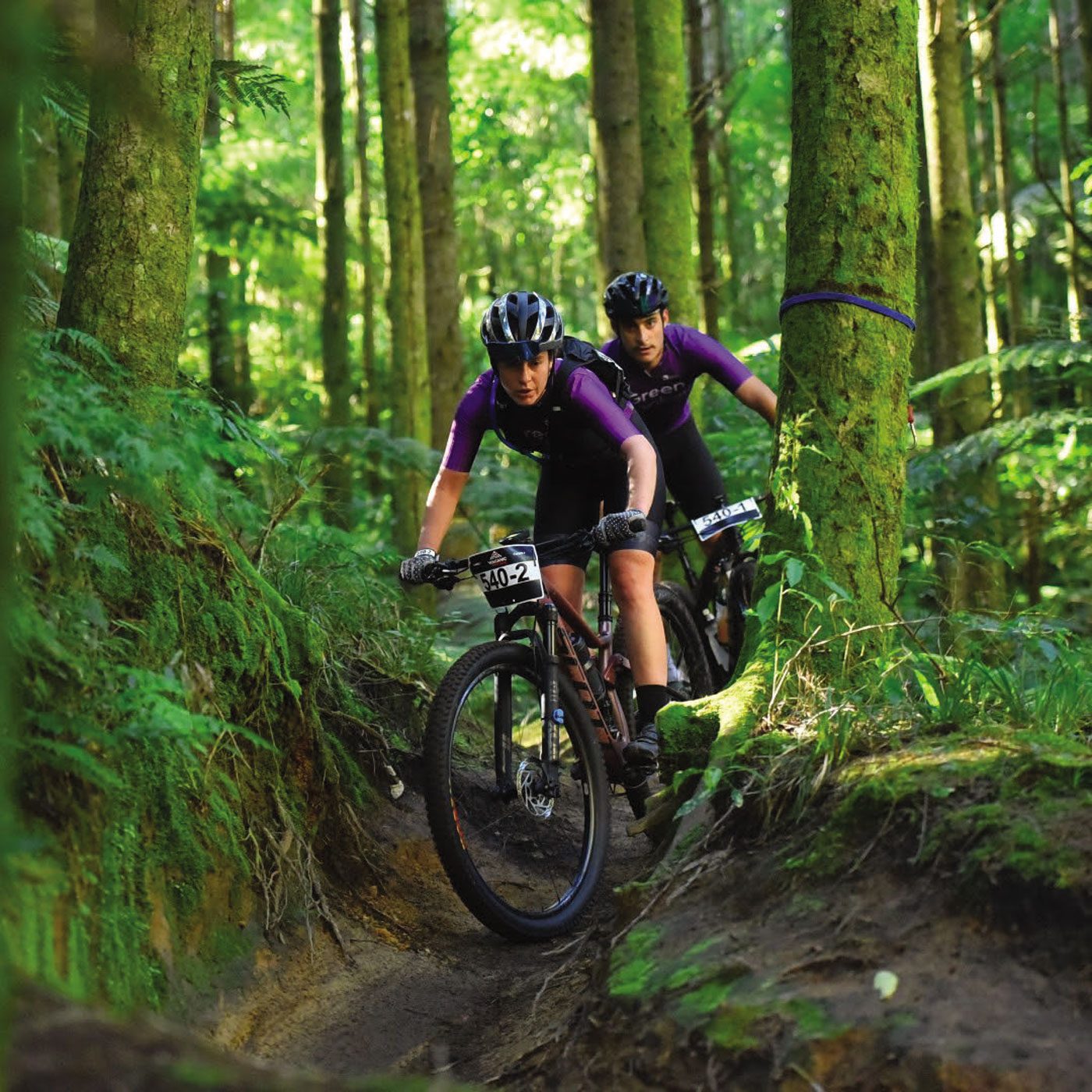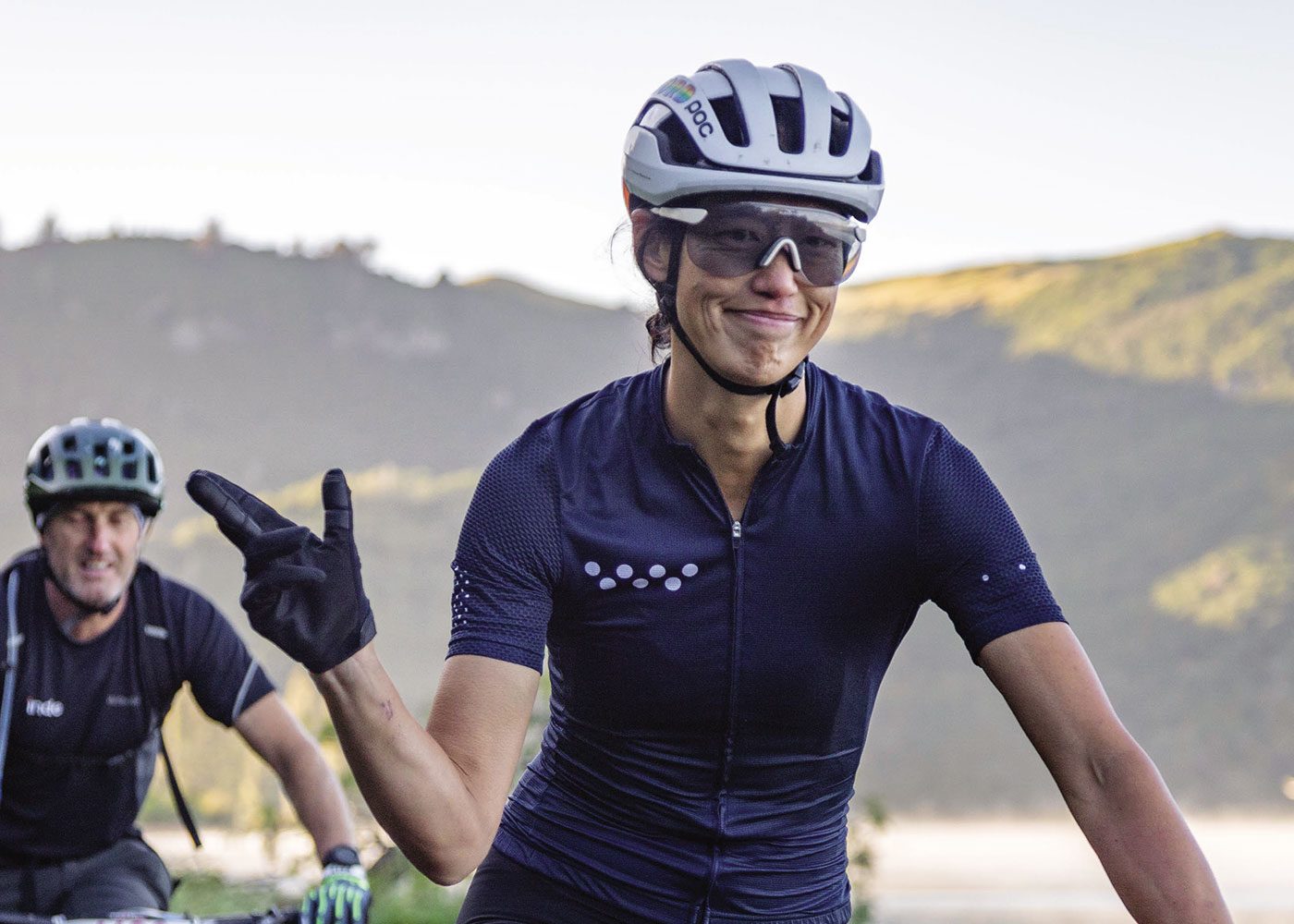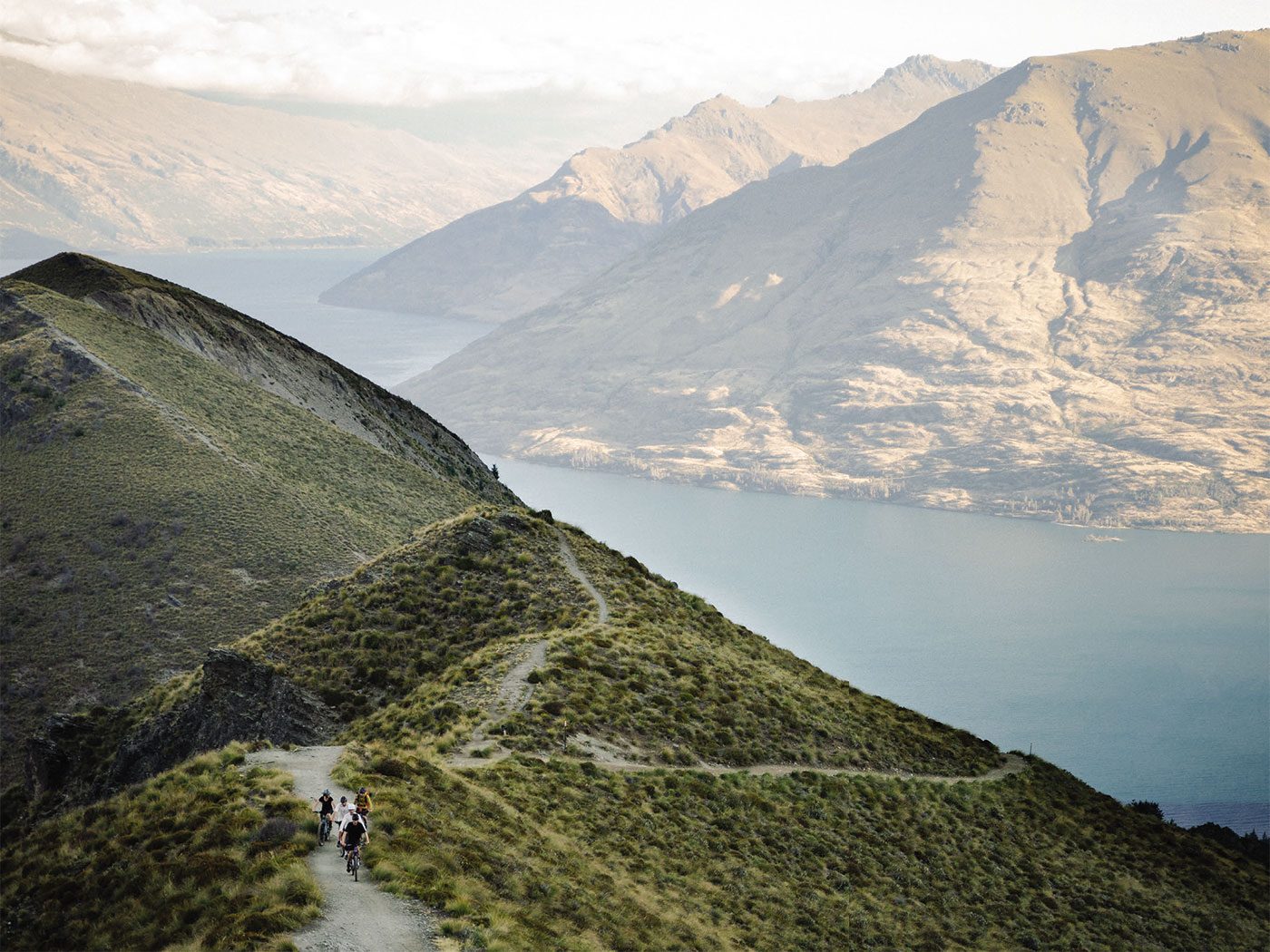Downhill World Record
Words: Annie Ford
Photography: Callum Wood
A World Record: the pursuit of something you’re not even sure is possible. An opportunity to push your ability and ambition to the outer limit.
It started with a ridiculously pedally summer. After riding the length of New Zealand, towing a surfboard, my newfound fitness led me to climb over 10k vert – accidentally becoming the first woman to do so on an enduro bike. It was a summer of deleting limiting beliefs and digging deep. But I’m a downhiller at heart, and there was one last thing I had my eye on before the end of the season: take the same trusty bike – my Santa Cruz Nomad – and attempt to break a Downhill World Record.
After a little research, I learnt there was no Women’s World Record for vertical descending in 24 hours, only a men’s record. The minimum requirement to set the women’s record was 30,000 metres, or eight Aoraki/ Mount Cook’s. The Men’s World Record, held by two Germans in Schladming, stood at a mammoth 40,840 metres, or 10 Aoraki/Mount Cook’s. I felt sorry for my enduro bike already.
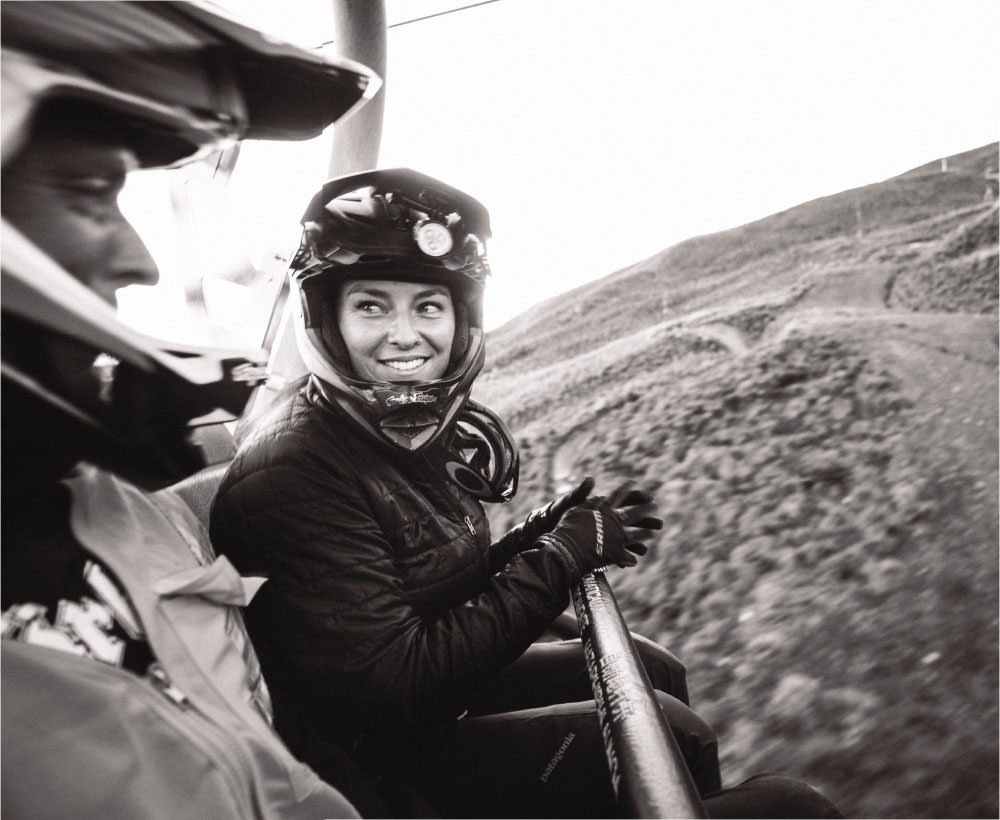
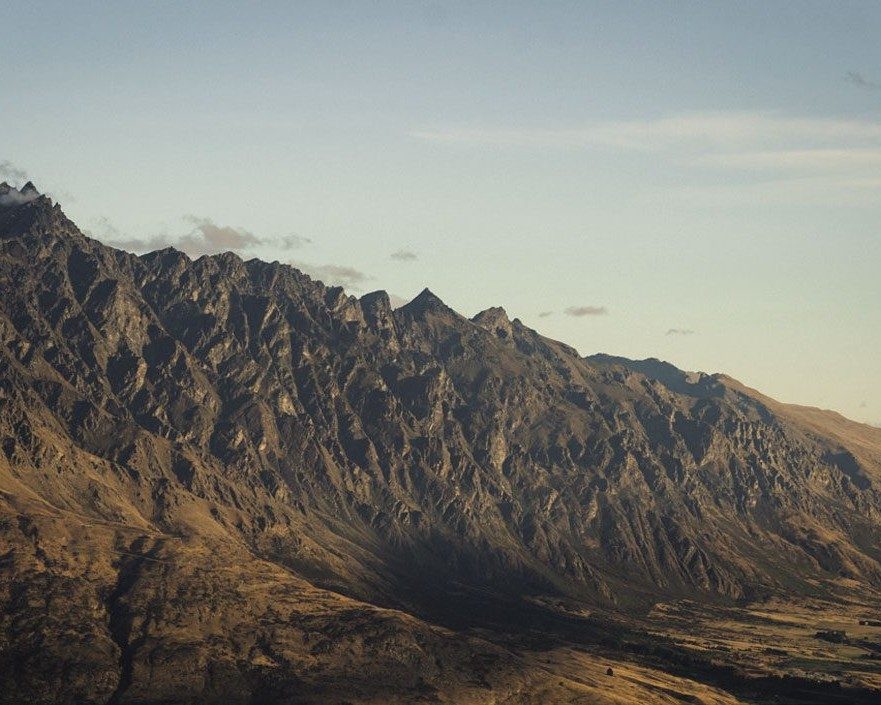
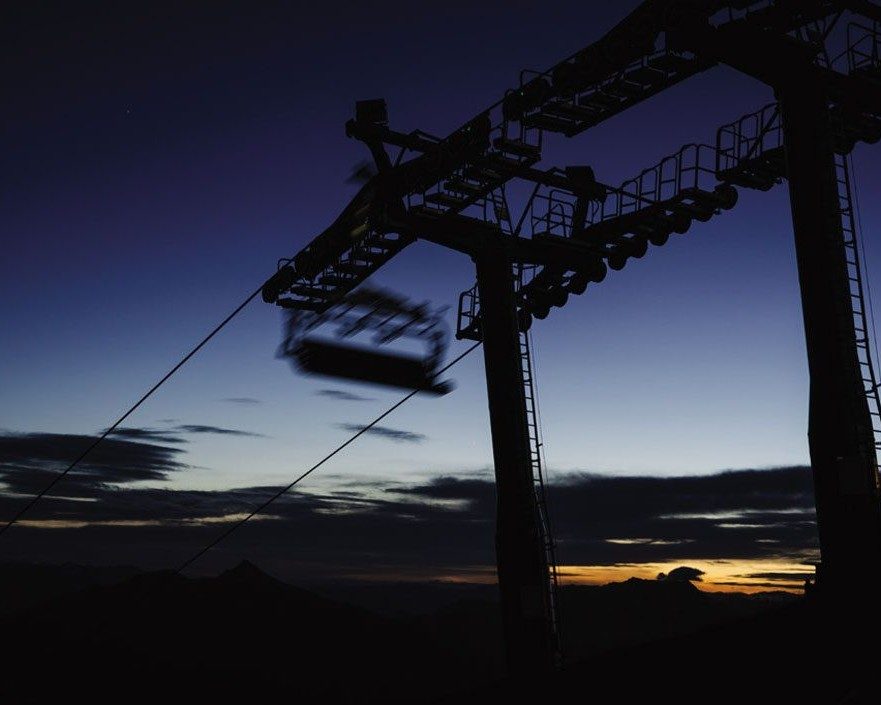
First hurdle: where? Nowhere in New Zealand – or Aussie – can you descend vertical metres as quickly (or as enjoyably) as you can at Coronet Peak. And it’s right in my backyard. Exposed, rough and – best of all – steep, the National Coronet DH Track was my lap of choice: four minutes up, four minutes down, with 419 metres vert gained each time. To set the women’s record, I’d need to do 72 laps.
I began mentally preparing for the sheer repetitiveness and volume of laps. What would it even feel like? No one knew. Ahh well, I guess that’s the whole concept behind a world record.
Second hurdle: the Nomad. I was about to do a season’s worth of riding in a single day. My poor, poor baby… Ben and KC from Vertigo Bikes came to the rescue. We replaced my handlebars with ultra-compliant carbon Title MTB bars, slid on RevGrips and installed Axxios vibration reduction. My SRAM/ RockShox setup was still mint and only needed a service. We rebuilt the wheels, threw on new tyres, and made everything super soft.
Third hurdle: sickness. How’s this for timing – two days before the attempt, I woke up unable to move. I was rolled by the only flu I’d ever had and couldn’t breathe without coughing. I organised the final days by texts rather than phone calls, so people couldn’t hear my voice – and couldn’t tell me not to do it. Sorry mum.
The day rolled in and I was sick as a dog. On the plus side, the weather looked clear for the first 12 hours, with rain forecast to increase. The plan was to kick off at 8pm on the 15th of March, knocking over the night laps while fresh. The Coronet chairlift was sped up to 100% and trucked along at five metres per second – almost too fast to remove our own bikes from the chair in front. The excitement was intense, I couldn’t wipe the smile off my face. I’d never seen a chairlift move so fast. It was bloody happening.
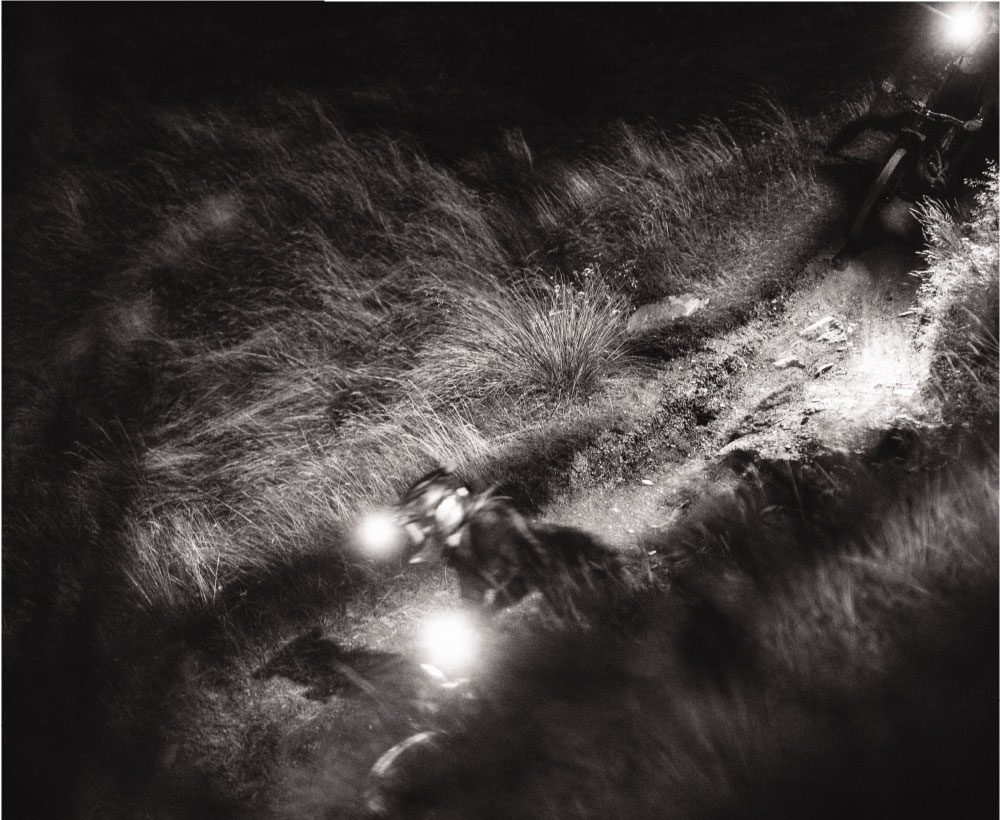
Lap 1 was the most dangerous in my mind, simply because my excitement and energy was borderline ridiculous. “Pace yourself”. Find your lines, settle in. One done. My cheeks already hurt from smiling.
And so, it began. It was some of the most fun riding I’ve ever done. It felt like my mates and I had a private bike park with the speediest chairlift ever – it was ruinously good. The dirt was perfect, a million stars overhead. It didn’t seem real, and we kept looking at each other and bursting out laughing. Time was flying. The cold air attacked my lungs on the chairlift, and my cough became our constant companion. Ascending was harder than descending in those early hours.
For the first 20 laps, I set the pace by leading other riders. I soon learnt that following someone else, however, meant I had to think less. I soon had favourite riders to follow, especially if they showed me smoother lines. It wasn’t long before we could ride that track blindfolded. We knew every rock, every line.
Forty laps in – halfway to the women’s record – fatigue began to wear in. I had my first Red Bull ever, with a coffee chaser. Damn, I could never have foreseen the effect: infinite energy at 3am, a million words a minute. It lasted about five laps before a thick, solid wall was hit. My appetite plummeted, and all food became repulsive. I was on the verge of vomiting each and every time I ate, with food getting shaken up the instant I dropped in. Conversely, I couldn’t afford not to eat, with mandarins and boiled potatoes all I could keep down. Rather than looking for fast lines, I began looking for smooth lines.
Fifty laps in, I began double finger braking and sitting down while descending. Combined, I swear there’s no better feeling in the world. There were no more smooth lines, given I had created my own braking bumps throughout the night. The beginning of arm pump was setting in, an uncomfortable sensation I had sought while training, but never felt. Temperatures dropped, my fingers began to freeze, and braking became more and more difficult. Digging had begun.
A faint red glow lit up the mountain range across the valley, the beginning of an incredible sunrise. I’d just lived the fastest night in history. Those sunrise laps are burnt into my memory forever – a red sky above, lapping with mates in one of the most epic places on the planet. We stopped and stared, but only for a moment.
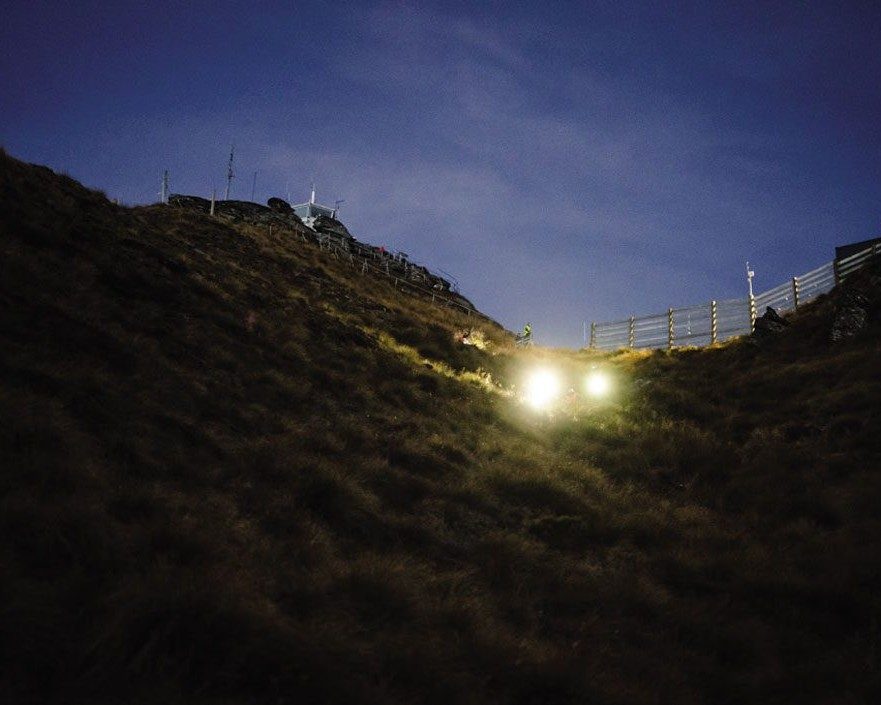
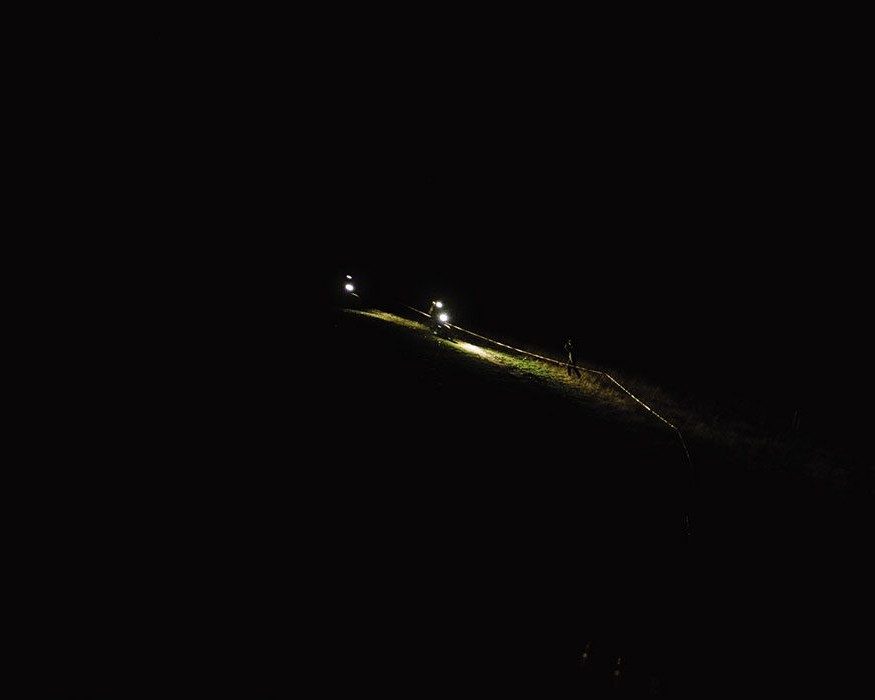
The Women’s World Record was hit at 9am, 13 hours into the ride, with a growing crowd to celebrate. Wow.
Day broke. The light changed everything; it felt like our laps now were on a different mountain, on a different day, on a different planet. Twelve of 24 hours down already, I started doing my fastest lap times, energised by being able to see, plus the women’s record – 72 laps, 30,000m – was getting close now. I got so excited I started doing features and pulling up for jumps again – a bad idea in hindsight, given every single impact cost me towards the end. The crew that had lapped all night with me needed to go to work, leaving me to continue lapping, alone now. This is how I usually ride, and I smiled to myself on the chairlift, absorbing the absurdity of it all. It gave me a chance to pause, feel. It’s then I realised I couldn’t feel my thumbs anymore. Nerve damage. Hopefully they come back someday.
I watched darkening clouds roll towards us from the south, it was no longer a race against time, but a race against rain. My support crew warned me I was a single lap away from the women’s record, that I was well ahead of time, that I should rest. The threatening rain decided for me – the perfect dirt wasn’t going to last much longer. The risk of injury would skyrocket if it got wet, so I’d only rest when I couldn’t continue riding non-stop.
The Women’s World Record was hit at 9am, 13 hours into the ride, with a growing crowd to celebrate. Wow. Eight Aoraki/Mount Cook’s. A new World Record holder. It wasn’t the plan, but, why not? Time to hunt down the men’s record. To celebrate, the support crew didn’t force me to eat that lap – a genuine and unexpected highlight. I began to realise eating was one of the hardest parts of the attempt.
Rain began to fall. Twenty more laps would break the Men’s World Record. Doable. Within reach. But, with fatigue and increasingly muddy conditions, 20 laps felt like 2000. I couldn’t afford mistakes, because my balance was rapidly deteriorating. I was double finger braking only now and sitting at every opportunity – which wasn’t often. My hands and forearms were noticeably swelling with each lap, their size clearly seen beneath my gloves and jumper. I slowed, could no longer jump, and began gritting my teeth with the pain of every braking bump or G-out. It was then that Brooke and Penny joined me – I harvested their high energy and stoke. More and more tourists joined the fray, filming and encouraging us from the sidelines, which meant even more energy for me to harvest.
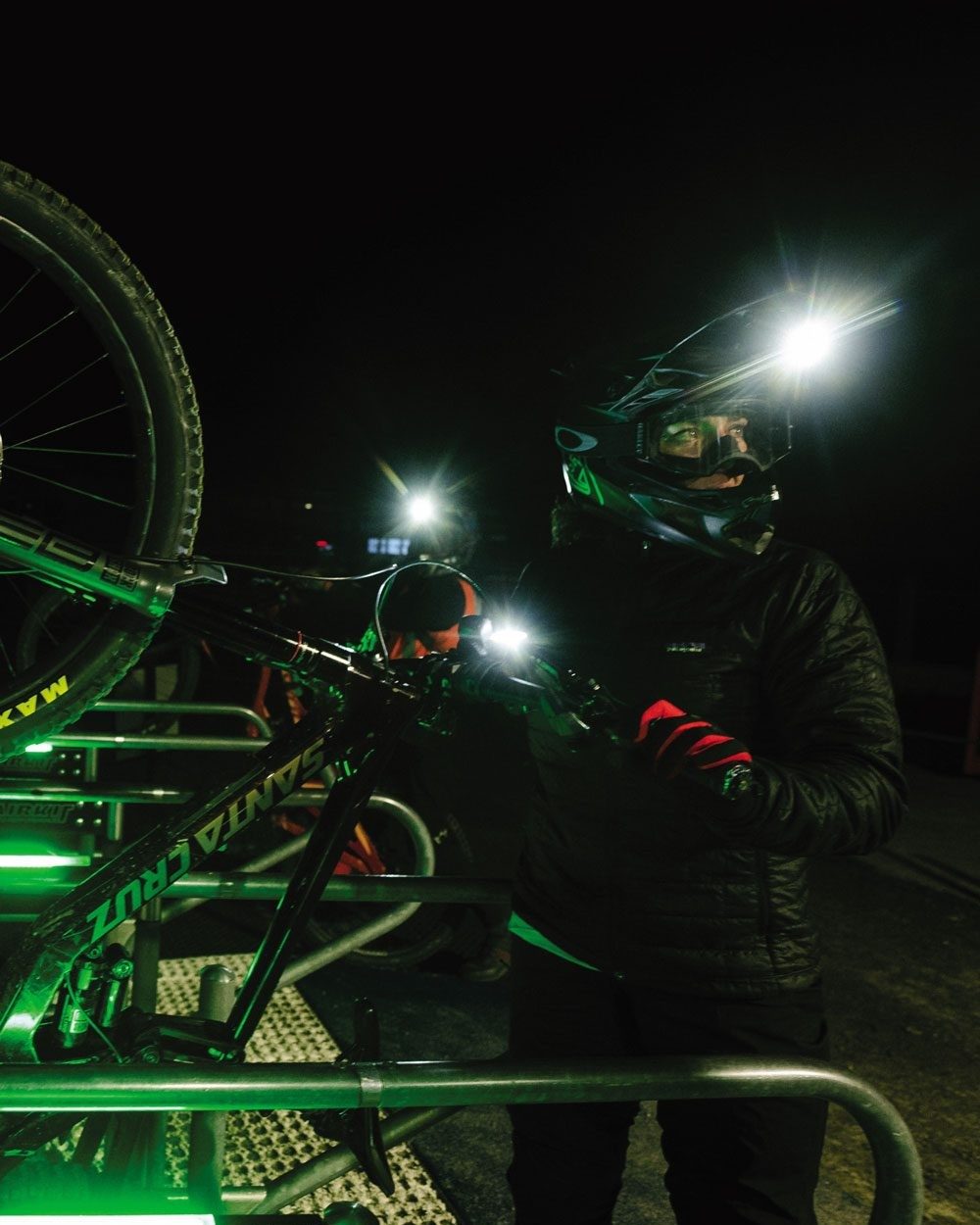
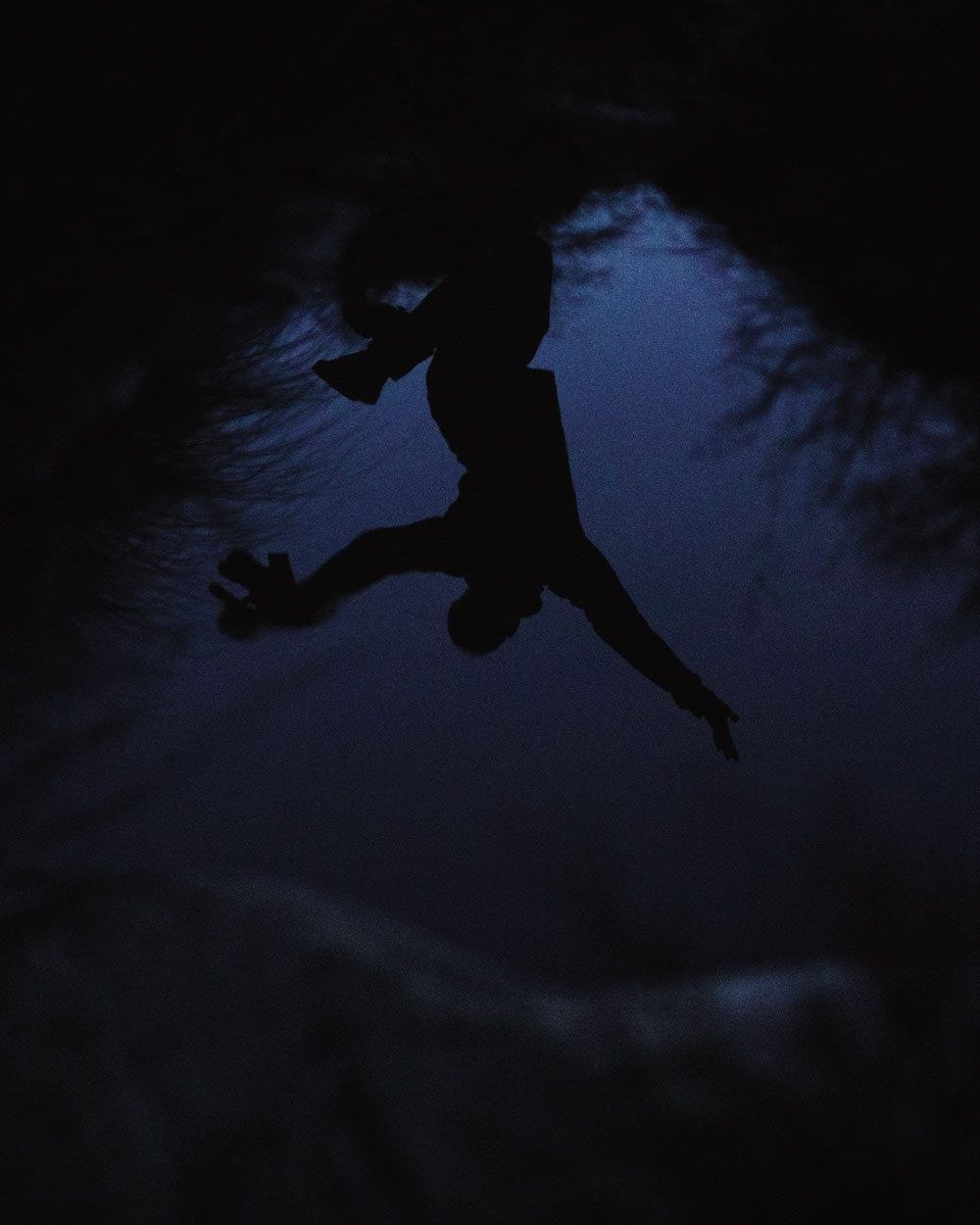
The heavens opened with just ten laps to go, and the last few laps were indeed horseshit. No one wins a shootout with wet Coronet. Thick mud coated both my tyres, making balancing through tight switchbacks near impossible. The closer to 100 laps we came, the slower time seemed to go. I had a little tumble on the 98th lap, covering my gloves in cold mud. I didn’t have the emotional bandwidth for a response to the layover, just picked the bike up, wiped my hands, and carried on. The words “be patient, stay upright” were now on repeat in my head.
At the bottom of the 98th lap, I was told I’d just broken the official World Record. I was exhausted, wet, but grinning; and met with clapping from hardy spectators braving the rain. I felt relief, and impatience. I was solely focused on 100 laps. Nothing else mattered. Arbitrarily and shallowly, ‘98 laps of Coronet’ just doesn’t sound quite as good as 100. Righto, two more then.
Those last two laps were easily the diciest riding I’ve ever done. Every part of me was fatigued, my arms were massively pumped, my goggles were covered in rain, and the trail had become peanut butter. I especially dreaded the rock slab, where poor balance went head-to-head with high consequence features. Despite this, speed increased on the final lap with all pain forgotten, completely trumped by the excitement of finishing. Crazily, it was one of the fastest laps I’d ridden. On the home straight of the 100th lap, I saw the support crew, standing and waiting in the rain, smiles from ear to ear. It was done.
I dropped my bike at their feet and was showered in rain and beer. I had no words. Arms were wrapped around me, with friends and strangers joining in the celebrations. I cannot explain the feeling I had in my chest, the comradery of the crew, the soreness in my body. It’s an experience I’m not sure I’ll ever be able to surpass, but I’ll sure try.
Final figures: 100 laps. 42,085 metres descended. 18 hours and 53 minutes.
I dropped my bike at their feet and was showered in rain and beer. I had no words.
I went out chasing a number, but that turned out to be the least important part. The people, the focus, the beauty, the mind, the body, and the INCREDIBLE support. That’s what’s real.
I honestly cannot articulate my gratitude to those who made it up the mountain with me. I could not have done it without them. They brought fuel to the fire, timely playfulness, and brilliance to this giant ticking clock we call life. I’ll never forget it.
A special shout out to the incredible Coronet Peak team, who supported me every step of the way. To SRAM, Patagonia and Title MTB for getting epic adventures like this off the ground. To Ben Hildred, for your perseverance in getting me to eat, and holding me up physically and mentally when the going got really tough. To the riders, Mateo Verdier, Brooke Thompson, Piyush Chavan, Jess Blewitt, Baxter Maiwald, Brett Rheeder, Penny Rowson, Jake Byrne, Sam Evans and Jamie McKay, who shared the wild ride. To the witnesses, Robert Lyons, Robin Bush, Lena Florey, Iona Bruce and Paul Westbrook, who put in long shifts at ridiculous hours. And to Jonny Ashworth and Callum Wood, whose incredible talents captured the day perfectly.
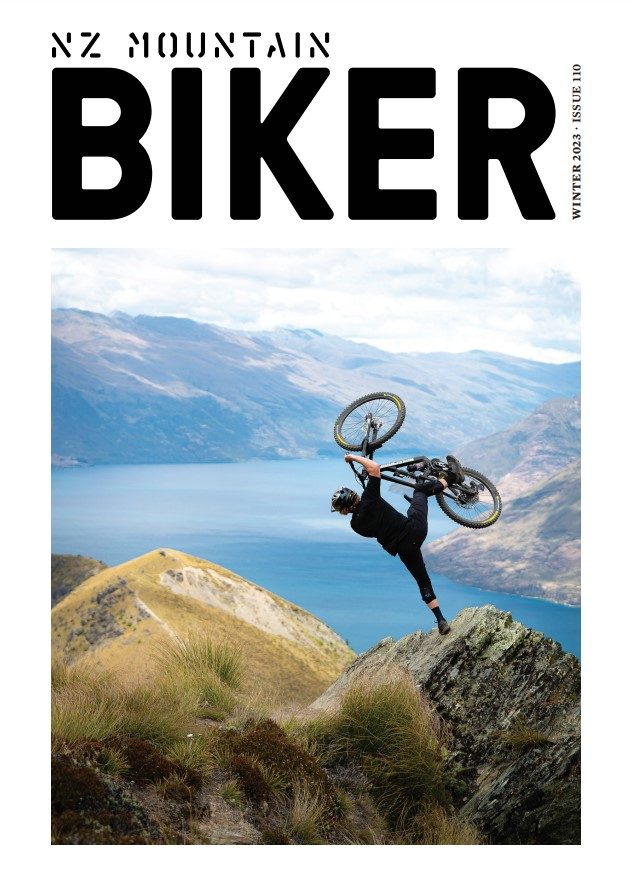
The Royale with Cheese
Words & Images: Jake Hood
PART ONE OF TWO
JUST GET YOUR HEAD DOWN AND GET ON WITH IT.
That was the quote from Quentin Tarantino’s Pulp Fiction that was bouncing through my head while we pedaled the last 20km back to Picton. THE ROYALE WITH CHEESE. It seemed like the perfect name for this adventure – a better name than what we’d had before. As we all know, everything’s better with cheese… and what an adventure it had been!
After the success of last year’s big mission in the Richmond Range – ‘Ferry to Fishy’ – we knew we had to do another one but, this time, it had to be bigger. We hadn’t even made it back to Wellington on the ferry before Scotty, Paul and Tom were throwing ideas around, still high on endorphins from the recent mission. The idea that seemed to stick was Mt. Royal; it sounded like the perfect mountain to conquer. Scotty, Paul, and Tom had ridden it before and told me the riding was insane. It had to be done! The name was set: The Royal Rumble – later changed to the Royale with Cheese.
Originally, the plan was to complete this mission within six months of ‘Ferry to Fishy’, but, well, as we all know, life sometimes gets in the way and adventures have to take a bit of a back seat. It wasn’t until December 2022 that the chat group got fired back up and things started to happen. Scotty and I were keen. Evan was also interested but wouldn’t be able to make it. Paul and Tom were very quiet on the chat, not committing. It got to the point where I just committed and booked my flight up to Wellington. This was the catalyst to get the ball rolling and make it happen.
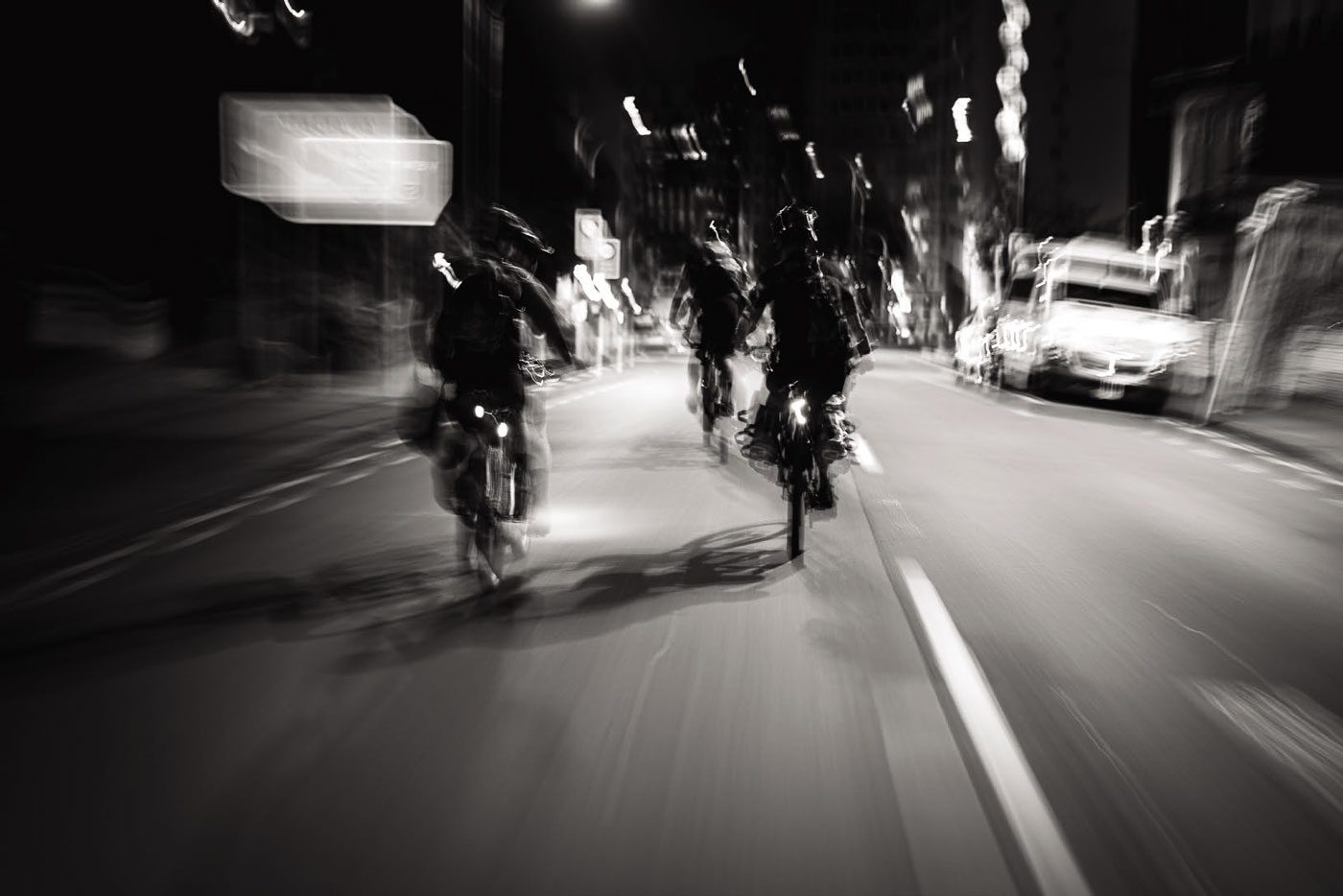
About a week before the flight up to Wellington, I looked at the long-range forecast and it was terrible. Nothing but heavy rain for the whole time we were going to be on the trip. I messaged the group: “Are you sure you want to do this mission still? You should check out the long-range. It doesn’t look good.” Now, I love a bit of suffering, a bit of a bad time, but the idea of riding 70km in the pouring rain to stay in a small DOC hut, ride Mt. Royal, then ride back into Picton in the pouring rain just seemed too much like a bad idea. It would just be a miserable, cold, gross old time. “I’m not against just coming up to Wellington for a tour de brunch this weekend,” I told the others.
There was chat in the group about sacking it off due to the weather, but we just kept an eye on it all week. We would decide closer to departure time what we were going to do. A couple of days before, we just decided that we were going to do it, come rain or shine. Heck, if it was wet, it was going to be wet. Just get your head down and get on with it.
I flew up to Wellington on Thursday (2nd Feb), landing early afternoon and giving me just enough time to get all my last-minute stuff sorted for the trip. A new jacket and dehydrated meals from Coffee Outdoors, a few bike things from the legends at Get Lost Cycling, and some frame bags from Caleb. Scotty picked me up from Get Lost and we headed back to his house to eat our weight in carbs for this mission, and get an early night for the 12.30am start.
Sleep is something I struggle with, and that evening was no exception. The excitement of what lay ahead kept me up; the not knowing of how it was going to go. I love this stuff.
The energy levels were high and the chat was pretty punishing (in a good way).
I LOVE THIS STUFF
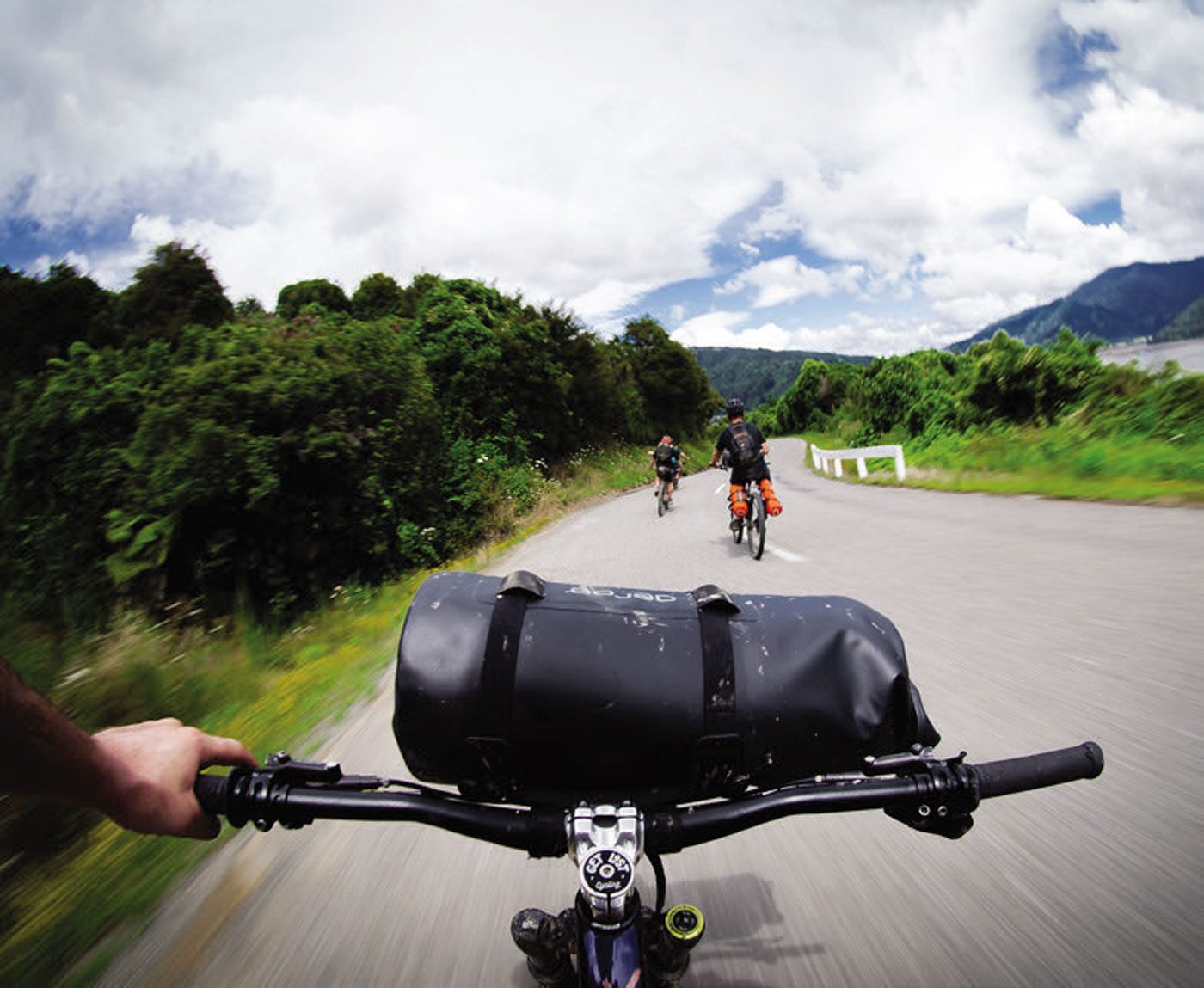
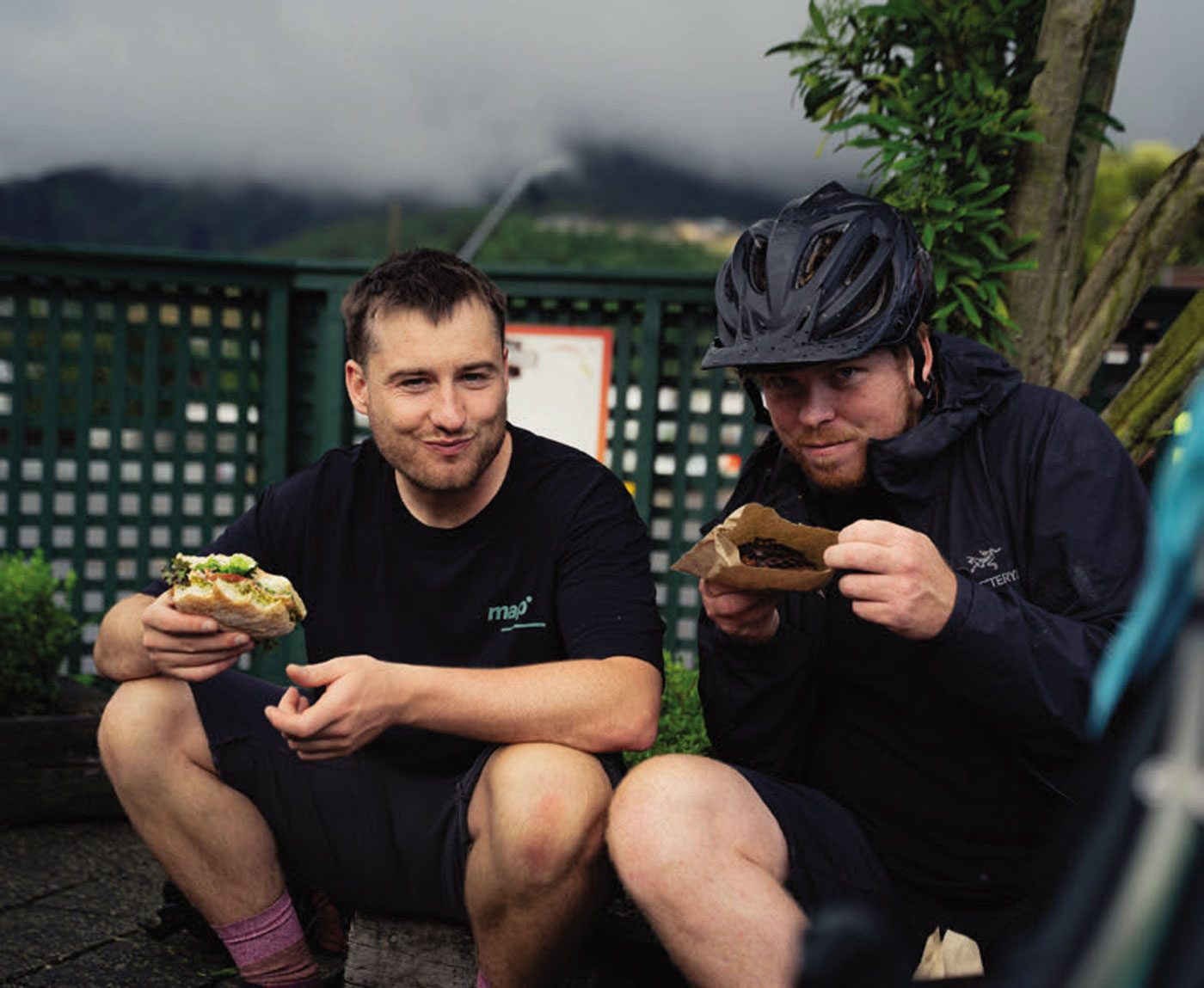
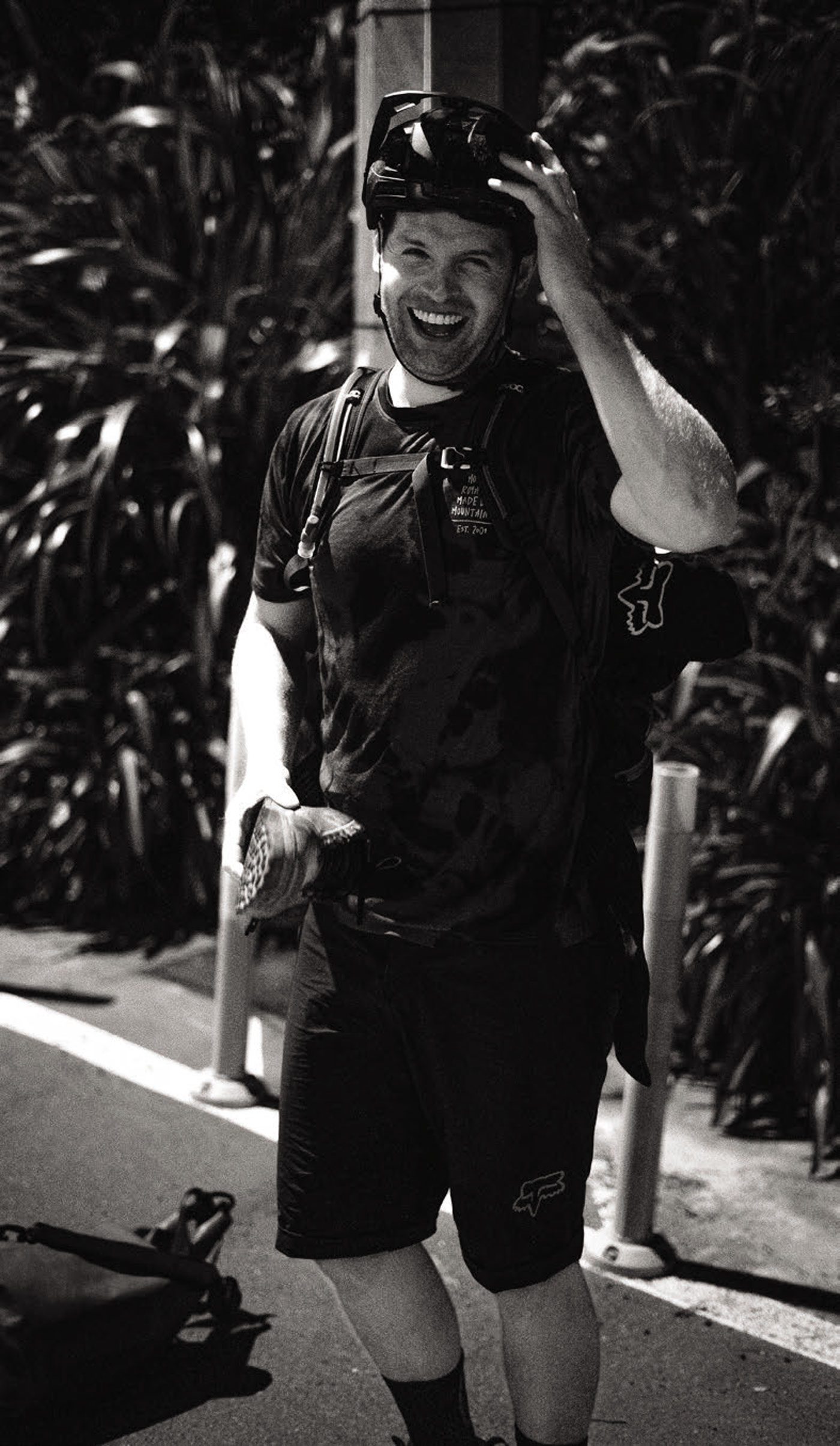
At 12.30am, Scotty and I hit the road to the ferry terminal. We met Paul at Penny’s and bombed the road down to Zealandia, where Tom Bradshaw joined us. The energy levels were high, and the chat was pretty punishing (in a good way). We bombed the roads on the way down to the ferry. The quiet streets let you get off the brakes and speed tuck, not worrying about cars. But soon this speed would catch Scotty out.
As we headed towards the university, Scotty was hugging the corner of the roundabout tightly. It’s quite a tight left turn and Scotty tripped on it. In a flash, his back wheel let go, and he hit the deck like a sack of potatoes, with such force that his shoe fell off. What the heck just happened? He got up and hobbled about. “Where is my shoe?” he said, half laughing, half in pain. Everyone was kind of laughing since we couldn’t believe what had happened. We hadn’t even made it 2km into the trip before the first crash. Scotty is a tough bugger. I think that crash was a lot sorer than he let on.
The shoe was recovered, and we got back on the road – this time at a bit of a slower pace – to the Bluebridge terminal. As we got to the terminal, the chat was, “Will Tom Cappleman show up? Will he be here? Is he actually going to bail?” This had been the running joke of the group chat for months. Tom hadn’t ridden his bike all summer. His new business, Coffee Outdoors, had been going gangbusters, which in turn had taken up a lot of his time. Even the day before, when I was buying my jacket, he was like, “Yeah, I’m not coming,” in a joking manner. Well, peer pressure got the better of him, and he rolled up to the terminal ten minutes after we arrived. It was great to see him back on his bike. The adventure was about to begin. The crew was assembled. Let’s go…
We all piled into the back room of the terminal, awaiting the ferry – the small room where they put all the bikes before boarding the ferry. The terminal was a lot busier than normal, full of people from the Ed Sheeran concert that night. We were in the room for about half an hour before finding out the ferry had been delayed. By how long? No one knew. We just had to sit there and hold tight. As time went on, tiredness and delusion started to kick in. We were just lying on the floor laughing about absolutely nothing, trying to even think of at least one Ed Sheeran song we knew. The carpet in the room was that super thick, hardwearing, bristly-like material, and it was so uncomfortable. When you laid down on it, it felt like getting stabbed by a thousand tiny needles. I tried to get some more shut eye, but it wasn’t happening.
What the heck just happened?
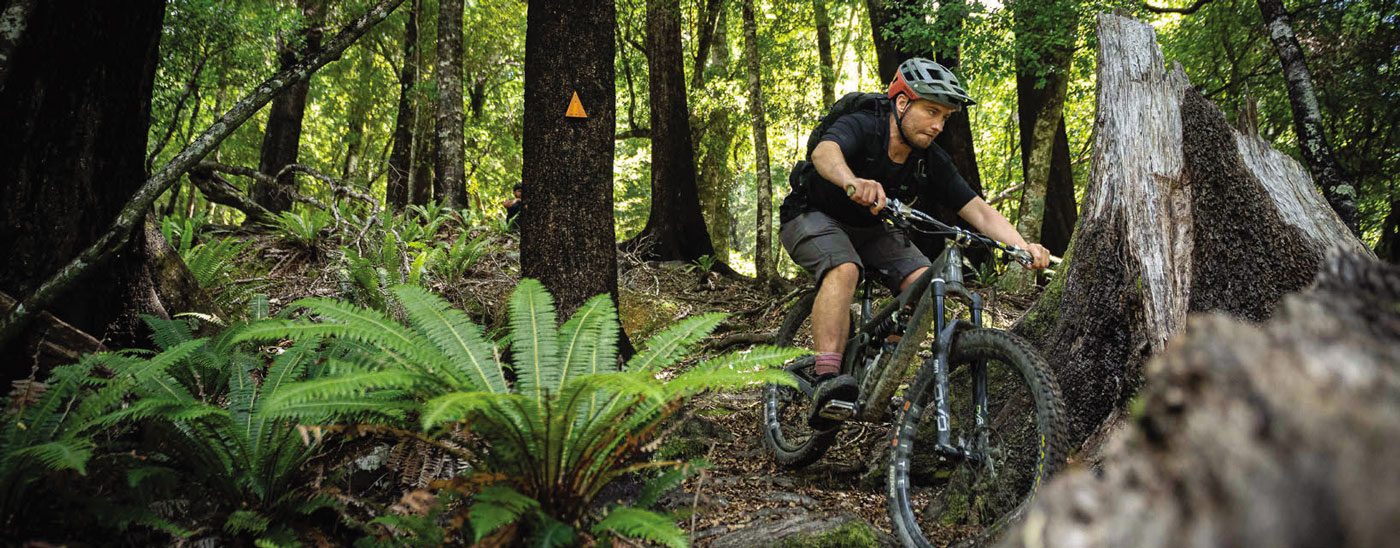
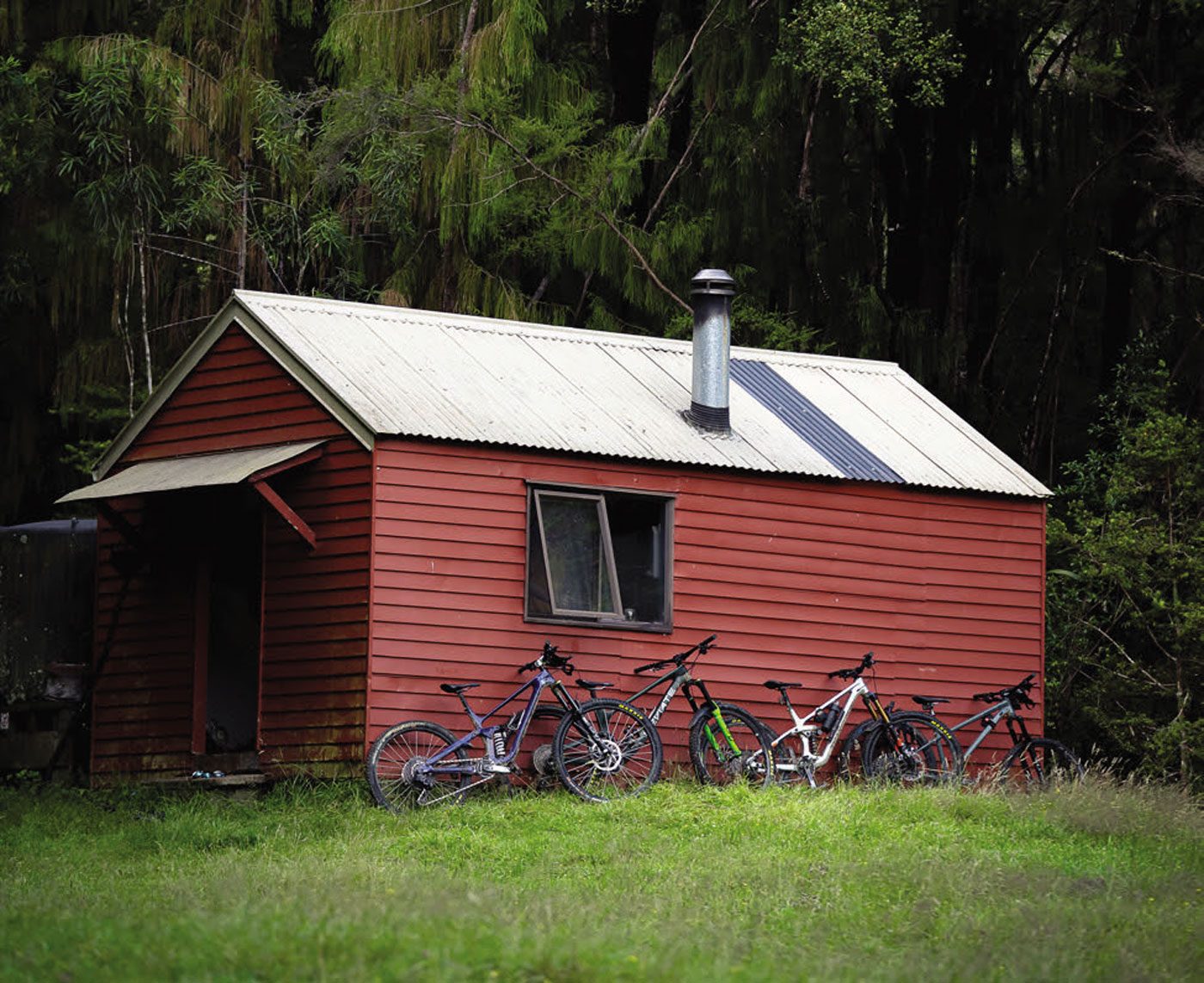
THE ADVENTURE WAS ABOUT TO BEGIN. THE CREW WAS ASSEMBLED. LET'S GO...
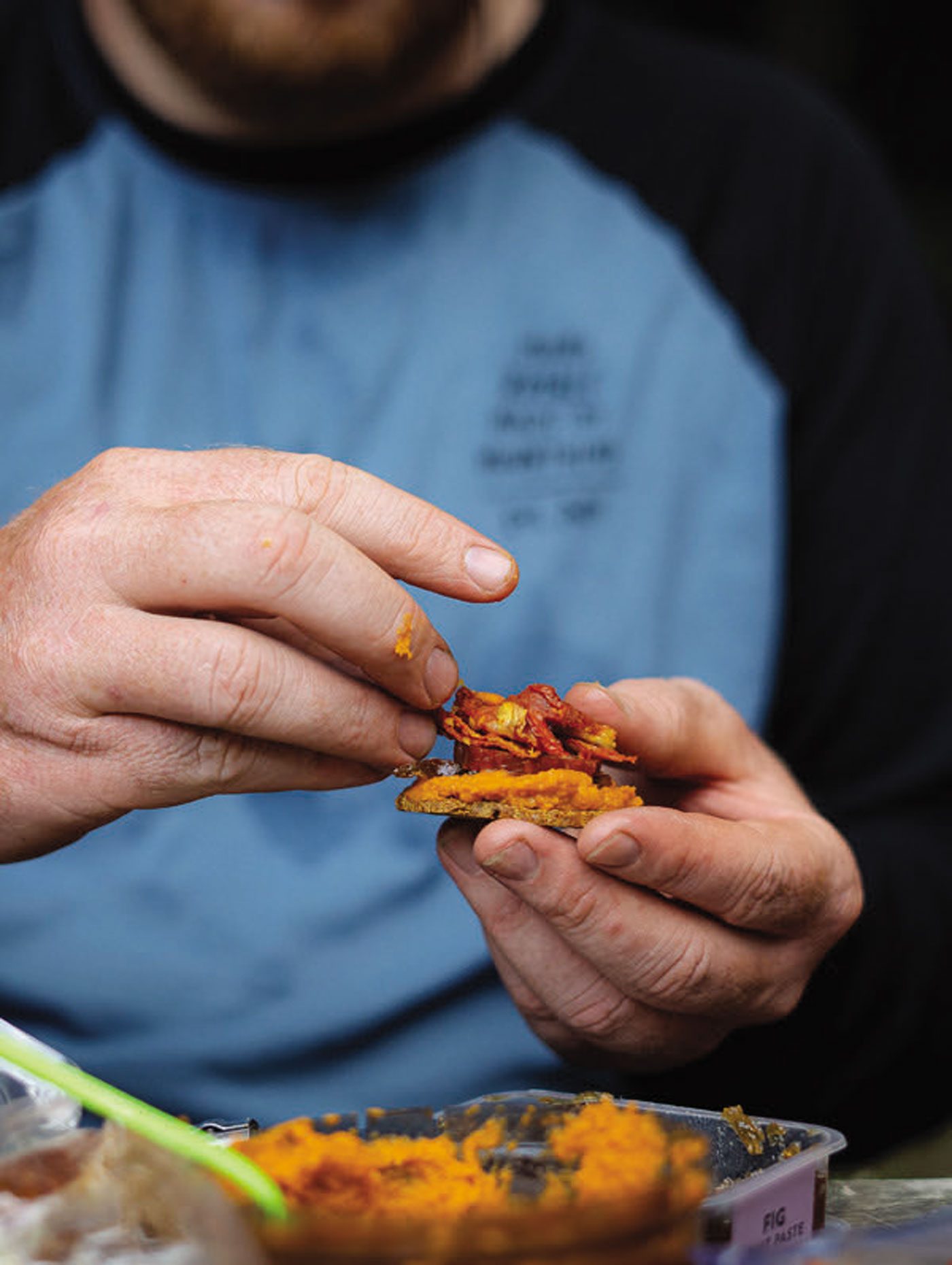
A full two and a half hours later, we finally got to board the ferry. Getting up from the floor, I felt like my body had aged 50 years. Every joint hurt. Half my body felt numb but sore at the same time. The walk to the ferry sorted that out. We had done this ferry ride enough to know the drill. Get in early and find a good place to get horizontal for sleep. After quickly getting our bikes loaded up, we sprinted upstairs to claim some big seats. Snooze you lose, people. I got horizontal immediately on a row of seats. I just wanted to try to get some shut eye. It had been a long day ‘til then without sleep. I managed maybe an hour or two, but it wasn’t much.
As the sun came up and illuminated the Sounds, I woke up and went out on the deck to see if there was a golden hour, but it wasn’t meant to be. Grey clouds hung around. In some of the bays of the Sounds, you could see rain, and towards Picton way it was raining heavily. Not a great omen for what lay ahead. As we docked in Picton, the rain lashed down outside the boat but, in Picton centre, there were blue skies. Maybe we would miss it? Just… Well, that wasn’t the case. As we got off the boat, we rode right into the middle of it. The rain pelted us as we disembarked the ferry, the residual water from the road spraying up and completely drenching us. First stop was the bakery in town for breakfast and to grab lunch for later.
As we arrived at the bakery, the rain stopped and the sun came out, which was pretty great timing to let us dry out as we shoveled all the carbs and caffeine into our bodies in preparation for the 70km of road ahead. Spirits were high despite us all looking a bit worse for wear due to the lack of sleep. It was only at this point that I found out Bradshaw wasn’t going to be joining us for the return leg of the trip. Instead, he was off to ride down the length of the South Island afterwards. How flipping cool, and what a start to the trip this was going to be for him.
After a lot of time faffing, eating and drying out, we finally got on our bikes and made a move on the Queen Charlotte Drive, out of Picton toward Havelock. We eased into the climb out of Picton, having learned our lesson from the last time we were in this position: don’t get overexcited and punch it. We didn’t need to treat this like a race. We had heaps of time to get to the hut that night. As we reached the top of the climb out of town, we got a full view of Picton below. The misty, rainy grey sky contrasted with the dark-but-vi- brant green of the trees. It was pretty magical.
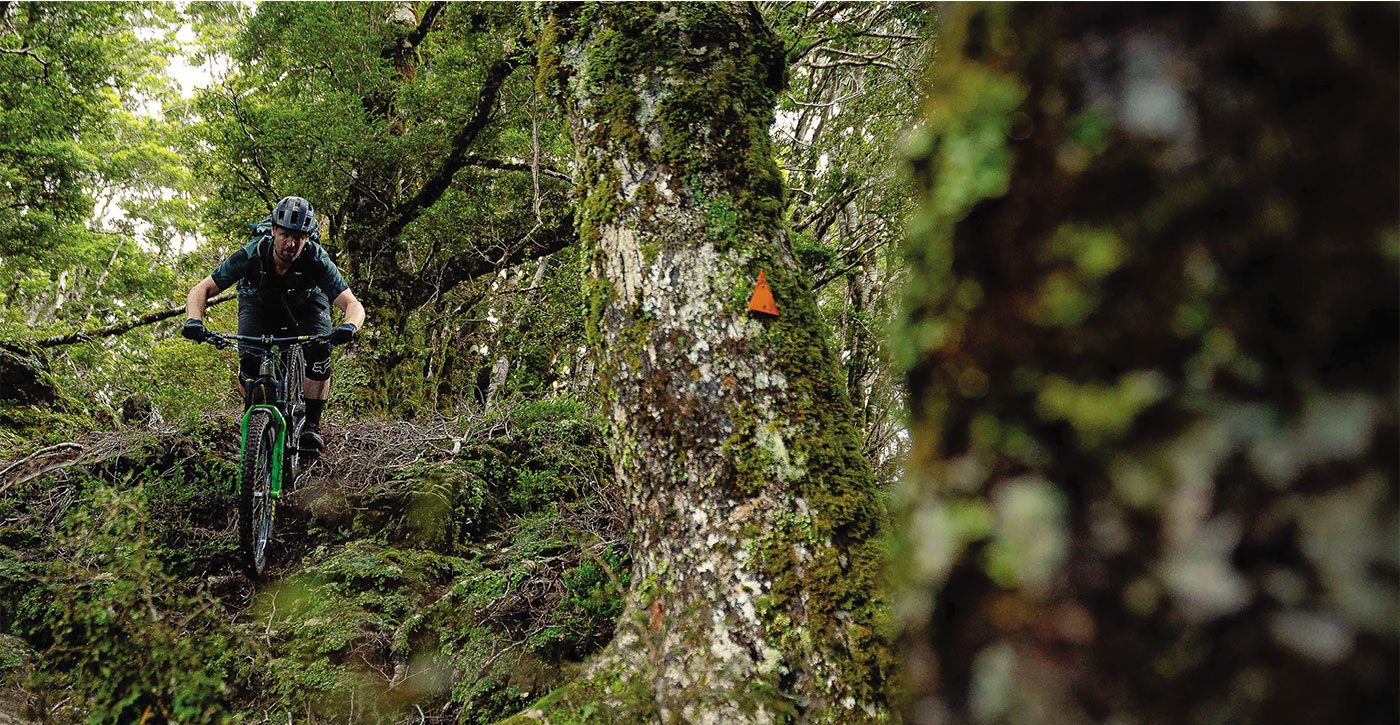
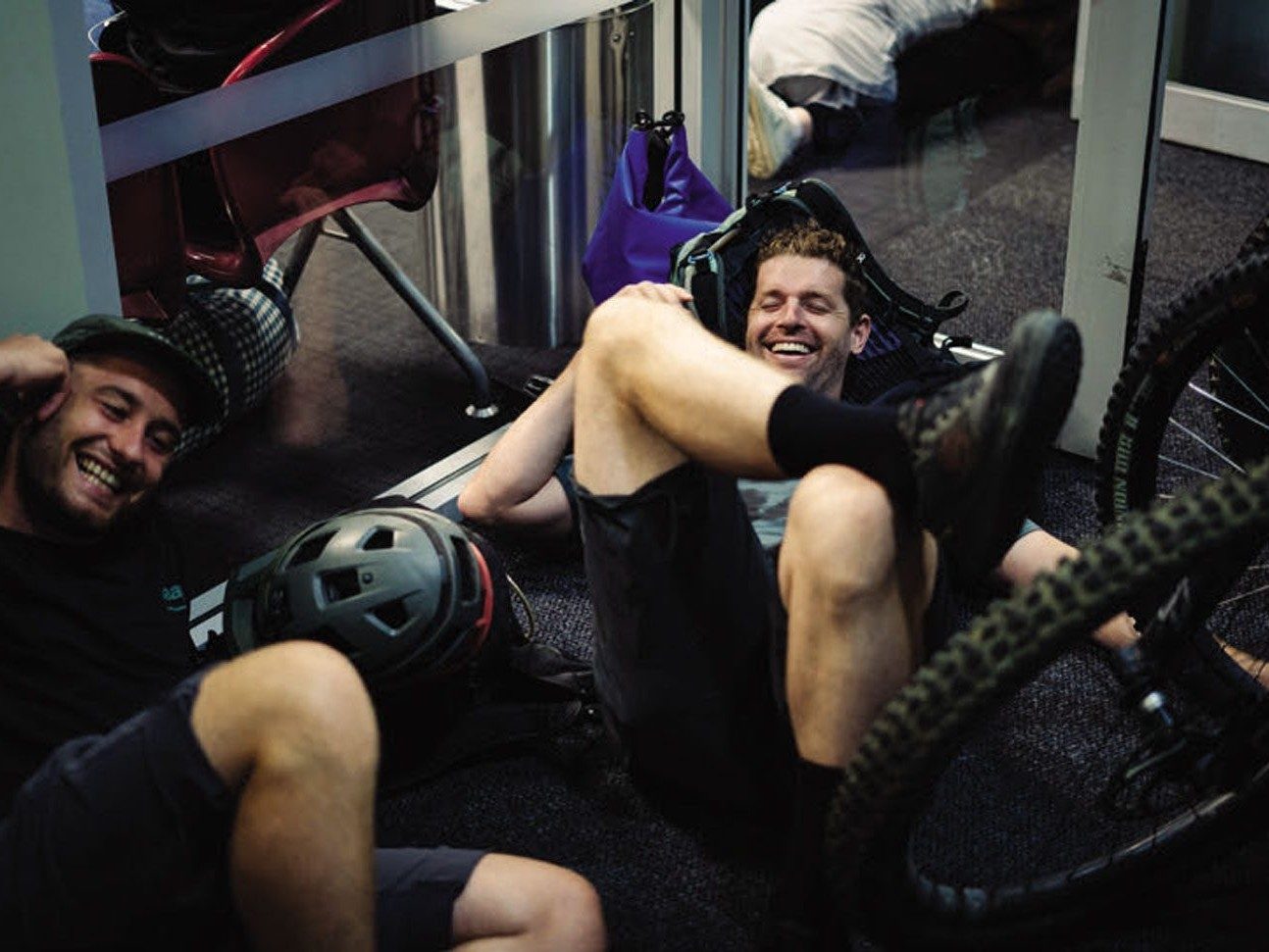
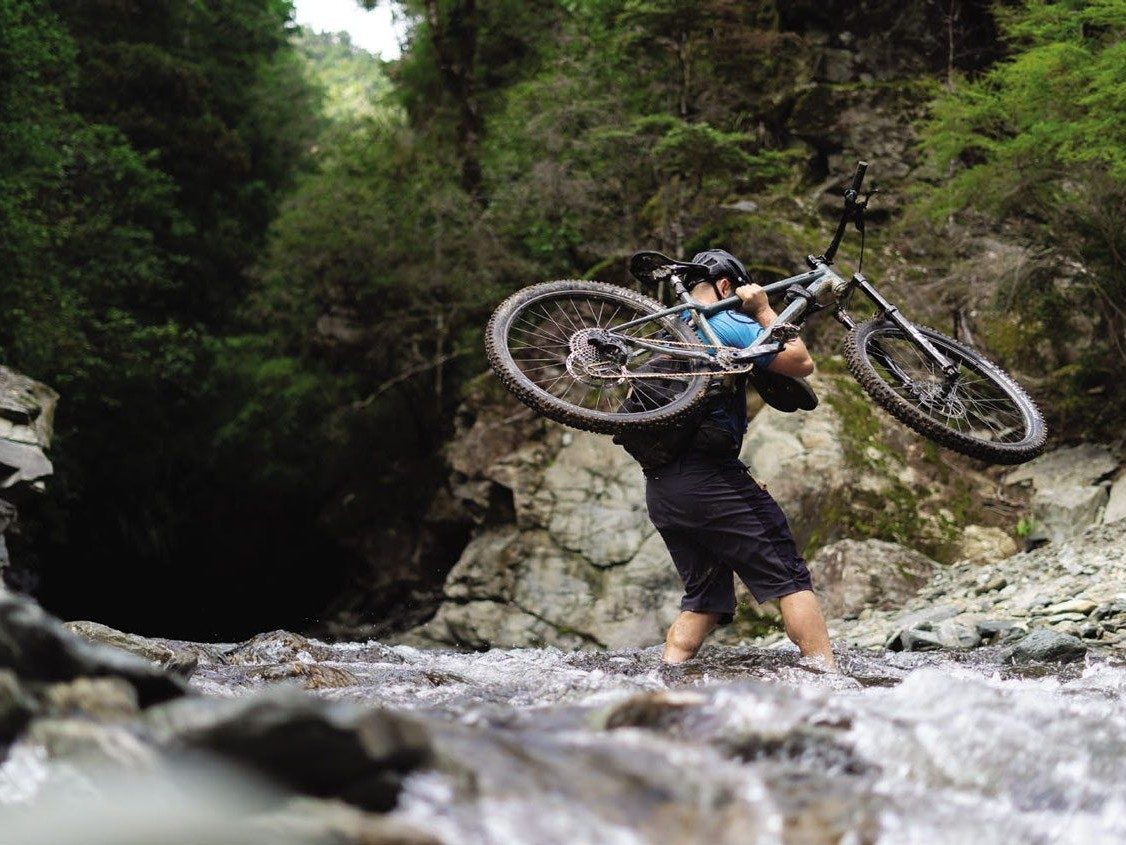
We were just lying on the floor laughing about absolutely nothing, trying to even thing of at least one Ed Sheeran song we knew.
Road or singletrack? That was the choice from the viewpoint. We chose the singletrack which… might not have been the best choice. It started off great, a flowing track back down to sea level, then onto a boardwalk around Shakespeare Bay. Moored up in the harbor was a gigantic cruise ship. After the boardwalk, the track started heading uphill. The saturated dirt was sticky to ride through, often causing wheel spins. It weaved its way through the dense trees back up near the road above. Eventually, we got to a point where there was a huge slip on the trail. Work had been done to reroute the path, but the soil was like clay, sticking to the wheels and tires. We had to push our bikes on this slip section as it was so sticky. We took the next turn off back onto the road. “Well, let’s not do that again,” said Scotty.
The road from Picton to Havelock follows the contours of the Sounds before a long, straight section inland, then back to following the edge of the Sounds to Havelock. The windy road sections were stunning. They weaved up and down, with some fast descents followed by pretty mel- low climbs. You could see the extent of the damage caused by the rains in the slips that had happened – huge bits of the hillside had just fallen away. But that didn’t tarnish how beautiful the landscape was. The misty, grey low clouds really added to it, leaving a sort of lazy, moody feel. There were still pockets of rain in some of the bays, from their own little microclimates. We were making good pace, just plodding along. Everyone seemed in good fettle. Knowing that we were going to be in for a big day, we kept the pace chill.
As we hit the big, long straight, the clouds burned off and bright sunshine appeared. It seemed to happen in an instant. Gone were the grey skies, replaced with what was almost a bluebird day. The temperature shifted massively. It became hot and sticky, with humidity at an all-time high. We got into a chain gang, got our heads down to get this straight out of the way. It was a good long slog, just turning the legs and trying to enjoy the surroundings over the humming sound of Maxxis Max Grip tires sticking to the tarmac. In the distance, you could see the heat waves coming off the tarmac. Sweat was dripping off me like water, and a mixture of sun cream and sweat beaded off my head into my eyes, leaving that familiar uncomfortable stinging feeling. “Couple of hours, boys.” With our heads down, we pressed on and eventually hit the windy roads to Havelock again.
It was a welcome sight to see Havelock. In my head, I knew that was a big chunk ticked off today. We stopped for a bite to eat, a water refill, and a bit of chill time. The temperature might have been unpleasant when riding, but boy oh boy, it was great during lunch. After a good feed and some chit-chat, we were ready to get back on the road again. We got back into the chain gang and punched it to Canvas Town. The 9.6km bit of State Highway 6 was busy with trucks and cars. It wasn’t pleasant to be on. Cars fly by you at high speed. We just wanted to get it done and get off it for our own safety.
Road or singletrack?
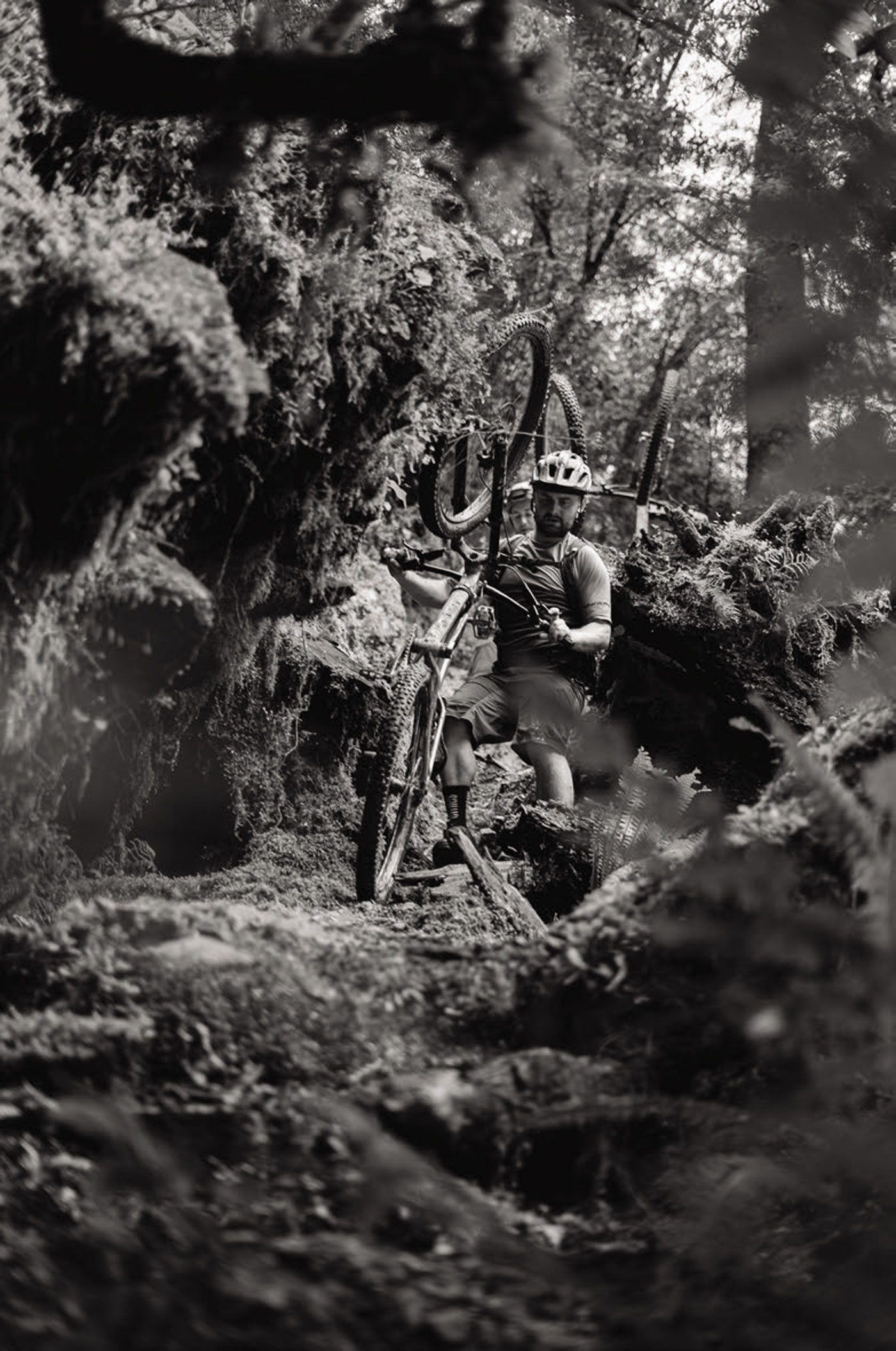
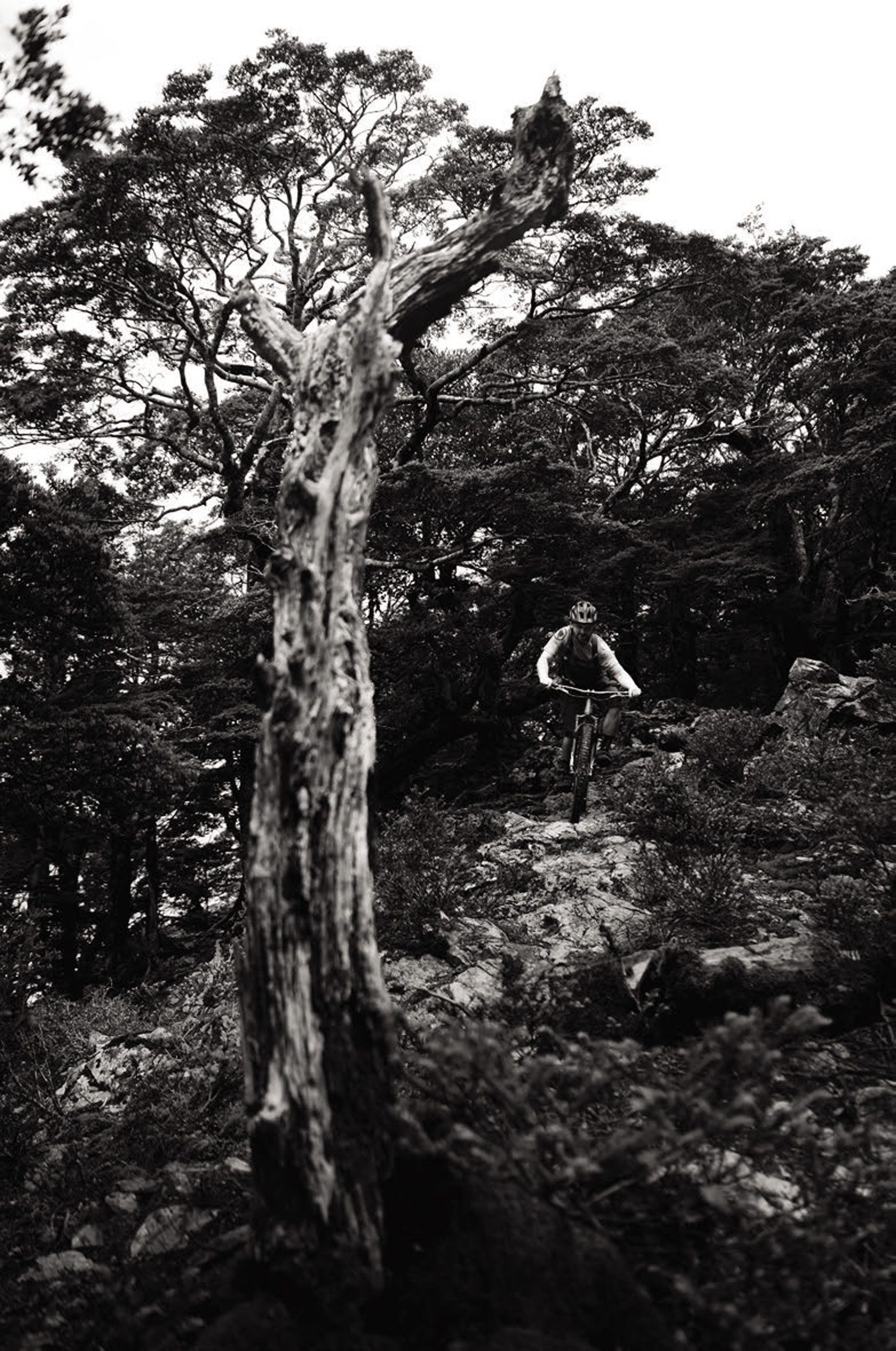
"COUPLE OF HOURS, BOYS."
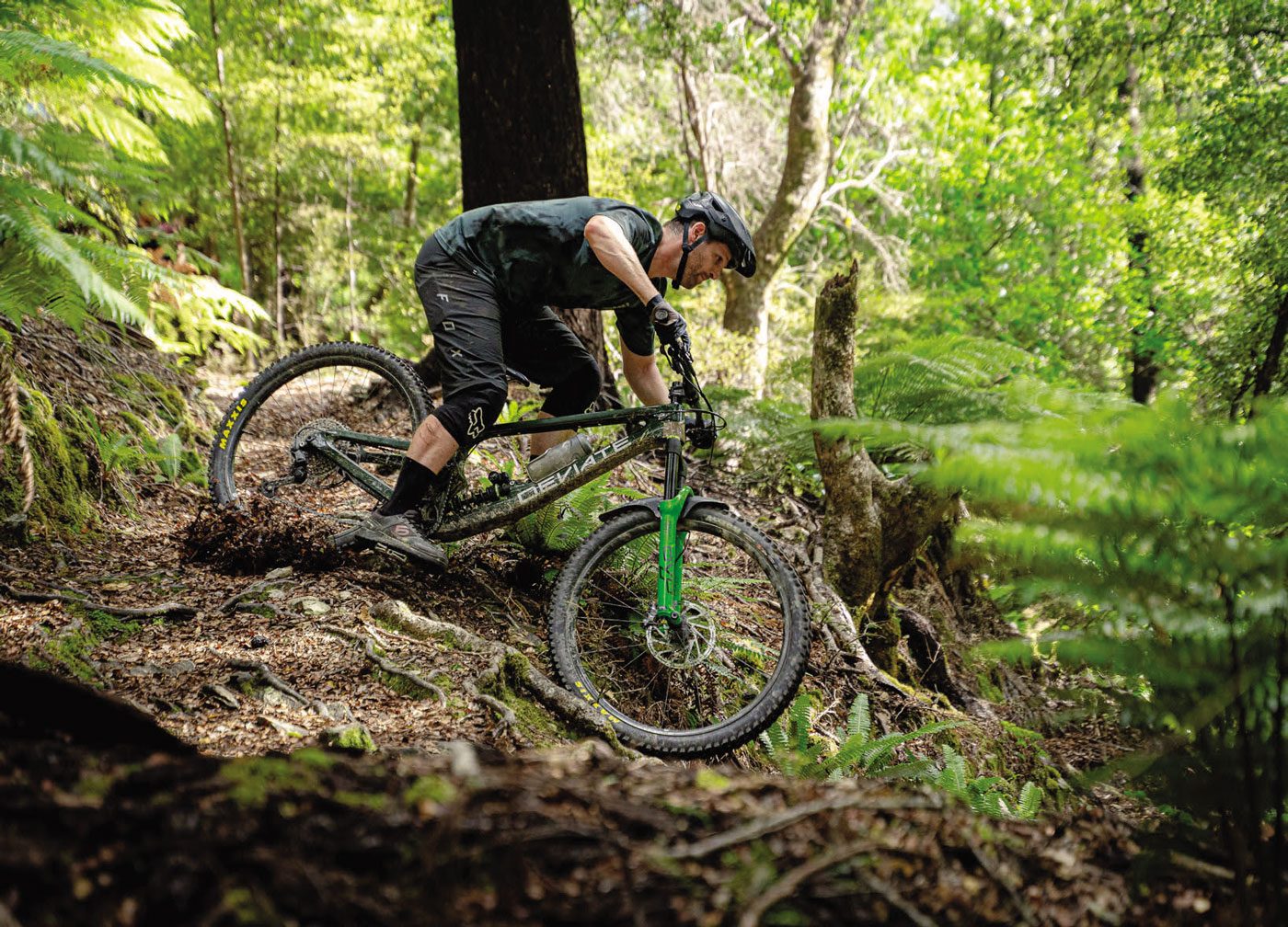
At Canvas Town, we took the left turn off just after the pub and followed that road down the valley. About 2km down, we stopped to check out Bradshaw’s grandparents’ barn/holiday house, that they had built way back in the day. Bradshaw had described it as a barn, so we were pleasantly surprised to find it was more like a small holiday home/batch. It had plenty of beds for us and power. Our plan was to stay there the second night. What a result. “I was not expecting this,” said Scotty. “Yeah, it’s pretty great,” said Bradshaw.
The next 15 kilometres… well, they sucked. We followed the Wakamarina road into the mountains. Paul and Scotty had warned us about this bit, telling us it was just boring and, well, it was. You just grind your way along this road until the surrounding hills gradually get bigger and bigger and turn into mountains. The farmland narrows and becomes native bush while the road changes from tarmac to gravel. You could hear the native birds and flowing river over the rumbling of the tires on dirt.
Finally, we made it to the DOC sign for Devils Creek hut. What a relief. By that point, we were all pretty over riding on the road. Everyone was starting to look worse for wear. I think the heat and the 60km of riding we’d done so far had taken a lot out of us. My saddle sores were starting to hurt, legs were feeling heavy. The sign said seven kilometres to the hut – it was all off-road from here. We dropped 50psi out of the tires, making them a more reasonable pressure. From here, my memory gets a bit foggy about the trail… I remember it being a slog. Pitchy climbs with very wet, slippery soil below the layer of leaves that had fallen on the trail. We had to hike a few sections of it. It was technical, narrow, and pretty steep. At one point, there was a downhill before the bridge crossing. It was fast, rocky, and loose. The rocks were slick, with big compression into rock gardens. But, it was great. We stopped at the bridge to regroup. Chappleman had fallen behind. “I’m in the box, guys,” he laughed. “Not far to go, though.” He’d done amazingly well to get this far considering he hadn’t ridden his bike for about five months. We pushed on and finally made it to the hut – and boy oh boy, what a hut it was.
Before us, the clearing lay ahead. Off to the left was this beautiful red hut, like something you would see in a picture book of Iceland. Just a perfect little red hut. What a sight. We had made it. We parked our bikes up, took the bags off, and moved our stuff into the hut. There were six bunks to sleep on, and a nice kitchen area; the smell of the old wood and musk permeated the building. This was a well-used hut.
You could hear the native birds and flowing river over the rumbling of the tires on dirt.
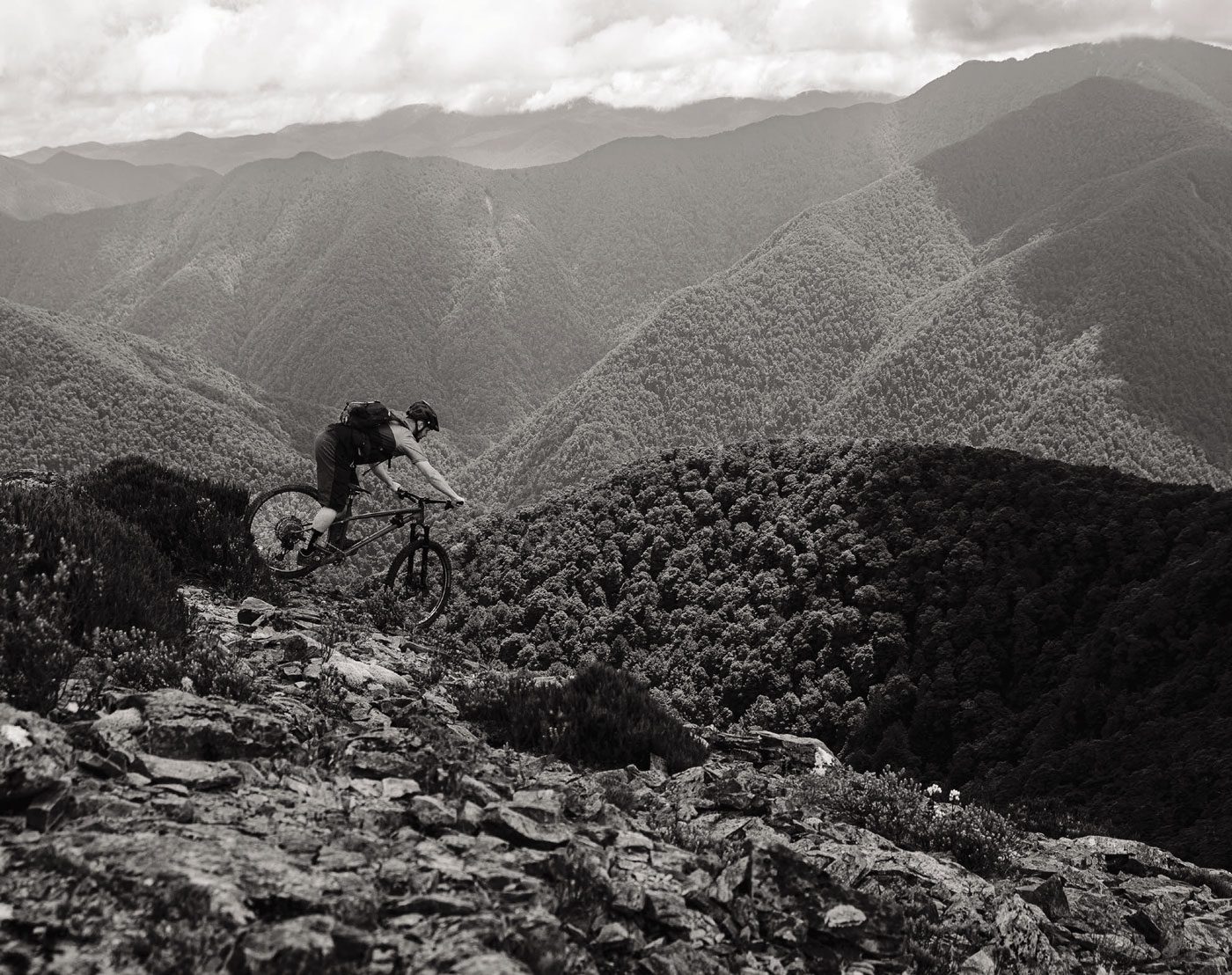
Cappleman was bonked, he had no energy left – so he stayed back at the hut while Scotty, Paul, Bradshaw and I started hiking up the Wakama-Rina. Our original plan was to get to the top and ride back down to the hut, but we were all pretty tired and kind of teetering on the edge of bonking, so we figured we would just push up as far as we could before bonking completely. From the get-go, the push was pretty hard. Early on, the trail was slick, making finding traction for walking even harder. It was going to be a fun, slippery ride down. As we pushed up, we kept checking out sections, wondering if certain gaps would be possible. Well, the gaps would have been possible, but it was more a question of whether we would be able to slow down afterwards in these conditions. We all pushed up picturing in our heads what we might do. “I’m just going to carve off this/float off that/drift round here.” It’s great thinking that way, and in reality you may be able to make just one of those things happen, but it makes the pushing up easier.
The trail looked fantastic, with some long sweeping turns, a couple of tech sections, fast straights, and some tight, technical switchbacks – nothing too technical, just a nice little warm-up for tomorrow, giving us an idea of what the dirt would be like. After about an hour and a half, we made it to a flatter section and decided to call it a day on pushing up. Everyone was looking pretty tired, and our legs were feeling heavy. We had a big day planned for the next day, so felt it was best to save ourselves for that. We turned around and dropped in.
Straight out of the gate, we hit this awesome tight switchback that you could really lean into and rail. Paul was out front leading, and he skidded around, throwing leaves up everywhere. Scotty did the same. Bradshaw was behind, shouting and yelling. Our back wheels were fishtailing left and right on the straights. As we tipped into steeper bits, a little bit of caution was applied, and we were right to. Braking traction wasn’t great, and when it started getting away on you, it really started to get away. In saying that, though, it wasn’t slowing Paul or Scotty down. They were flying. There were a few slick roots hidden under the leaves, and our bikes danced left and right as we held out through the line. I could hear Bradshaw having some wild moments behind me, on his hardtail, with the occasional “woooow!” or “oh shit!” moment. The forest we were riding through was amazing – and dense.
As predicted, I only managed about one of the twelve things I thought I was going to do on this trail. Everything just came up faster than I’d predicted it would – and you have to ride on instinct versus what you had imagined. We got back to the hut with huge smiles on our faces. It was a great little bit of trail we had just ridden, making the 60km worth it to get there. But, the following day was going to be something different again. Less of a ‘trail’; steeper, techier, longer, gnarlier. We were fired up. Everyone was grinning ear to ear.
As we pushed up, we kept checking out sections, wondering if vertain gaps would be possible.
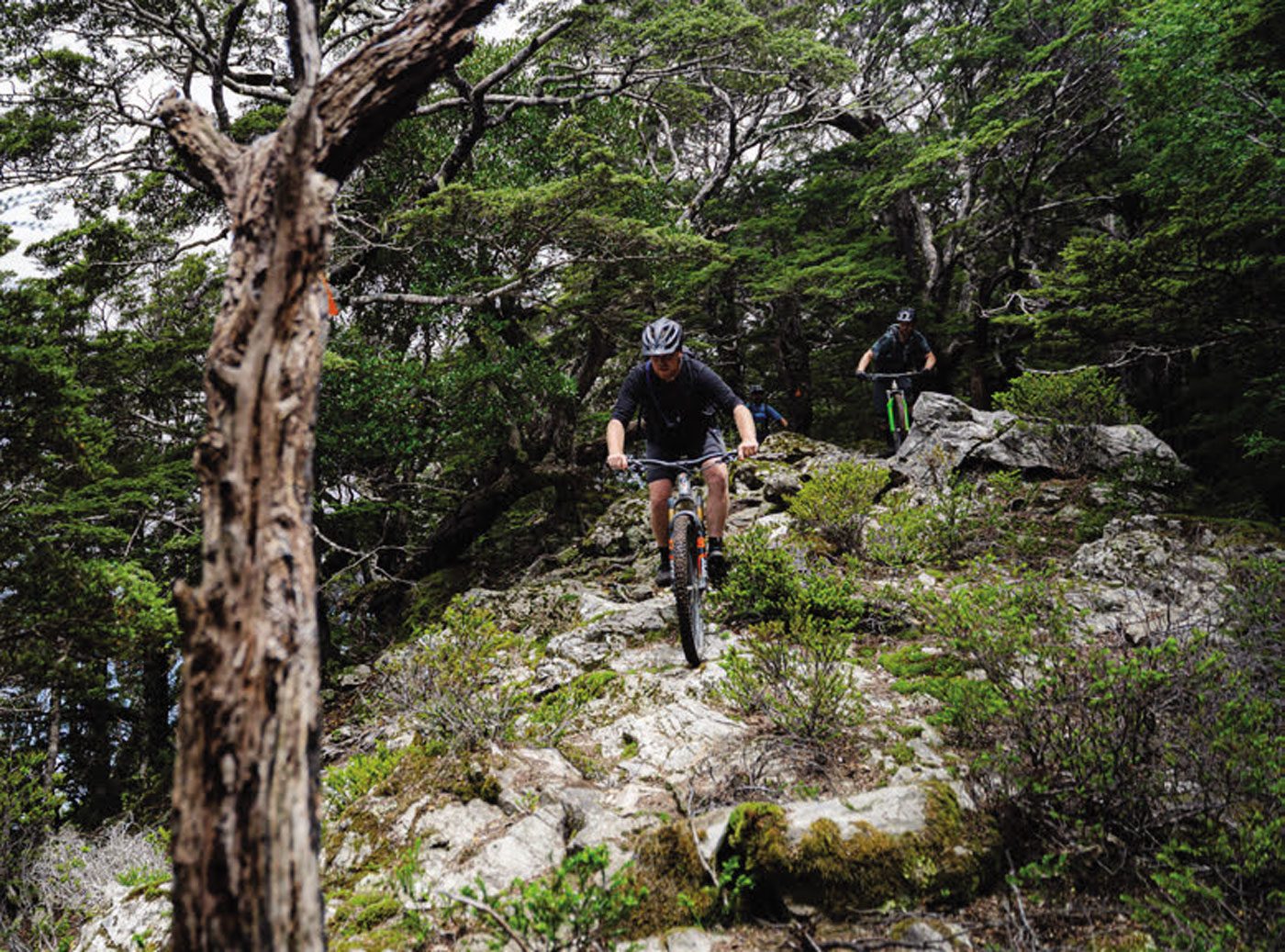
THE TRAIL LOOKED FANTASTIC...
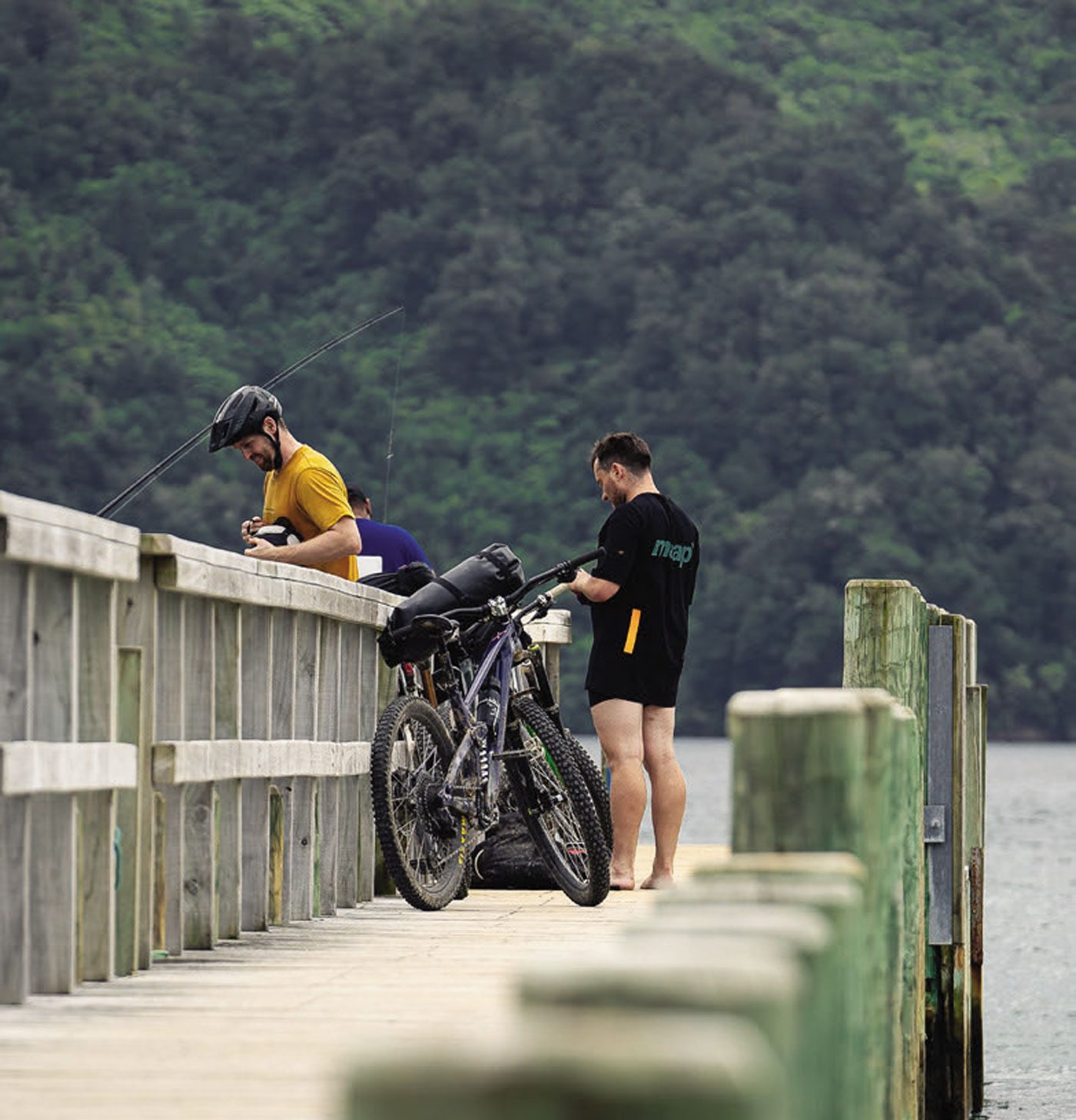
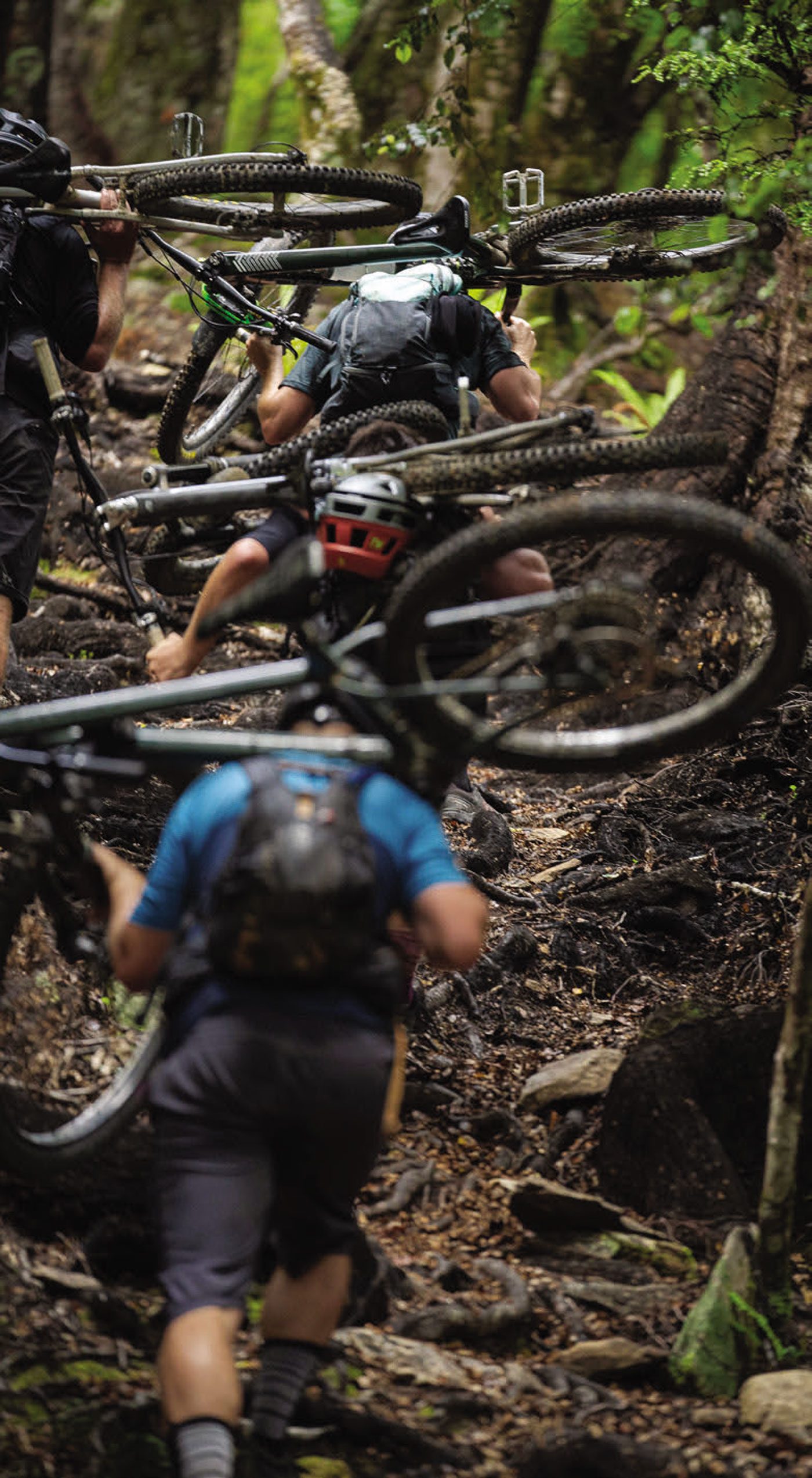
Back at the hut, Cappleman had perked up again. The downtime and some food had pushed him past the bonk and he looked full of life again. At this point, Bradshaw decided to drop it on us that he wasn’t coming up Mt. Royal with us but, instead, was going to hit the road to Nelson and start clocking off kilometres on his South Island trip. “Woah, woah, woah! Hang on, you can’t do that,” Scotty said, shocked. “Yeah, man, you can’t dog the boys,” from Paul. Cappleman just went straight for the heavy blow: “Didn’t realise you were a coward.” “You’re coming up that hill tomorrow whether you like it or not,” – Scotty. Bradshaw came back with some bullshit about how he had to be at some dinner or something. It was a weak excuse. Over dinner, and a dip in the river, we bullied, peer-pressured, and guilt-tripped Bradshaw to come up Royal with us. We couldn’t tell if he was joking or not. I mean, why would you just bail on this? Eventually, Capple-man said he would give Bradshaw his Crocs if he came up, and that was what sealed the deal. Honestly, some bullshit that was – but hilarious at the same time.
And so, night one came to a close – the perfect preface to what laid ahead of us.
They were flying. There were a few slick roots hidden under the leaves, and our bikes danced left and right as we held out through the line.”
THE FOREST WE WERE RIDING THROUGH WAS AMAZING - AND DENSE.
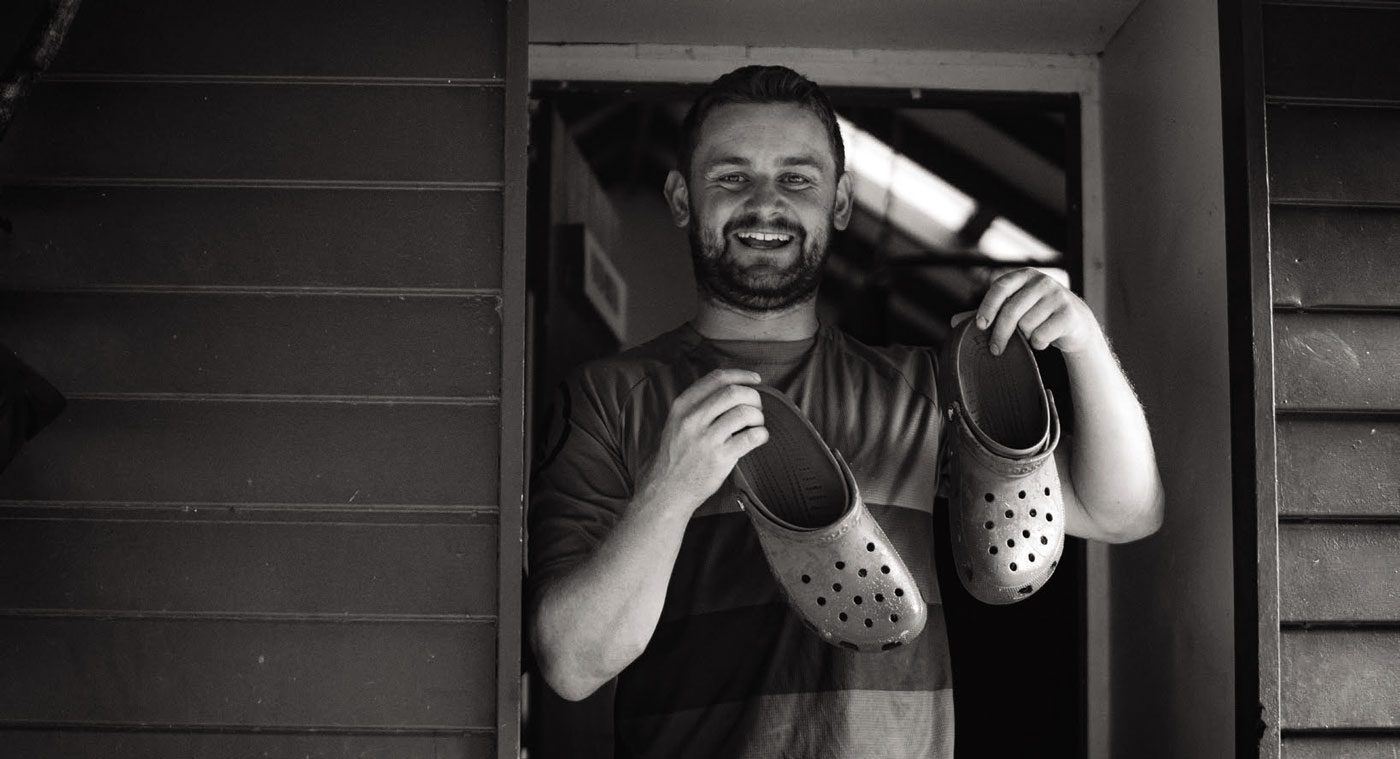
Honestly, some bullshit that was - but hilarious at the same time.
Over dinner, and a dip in the river, we bullied, peer-pressured, and guilt-tripped Bradshaw to come up Royal with us.
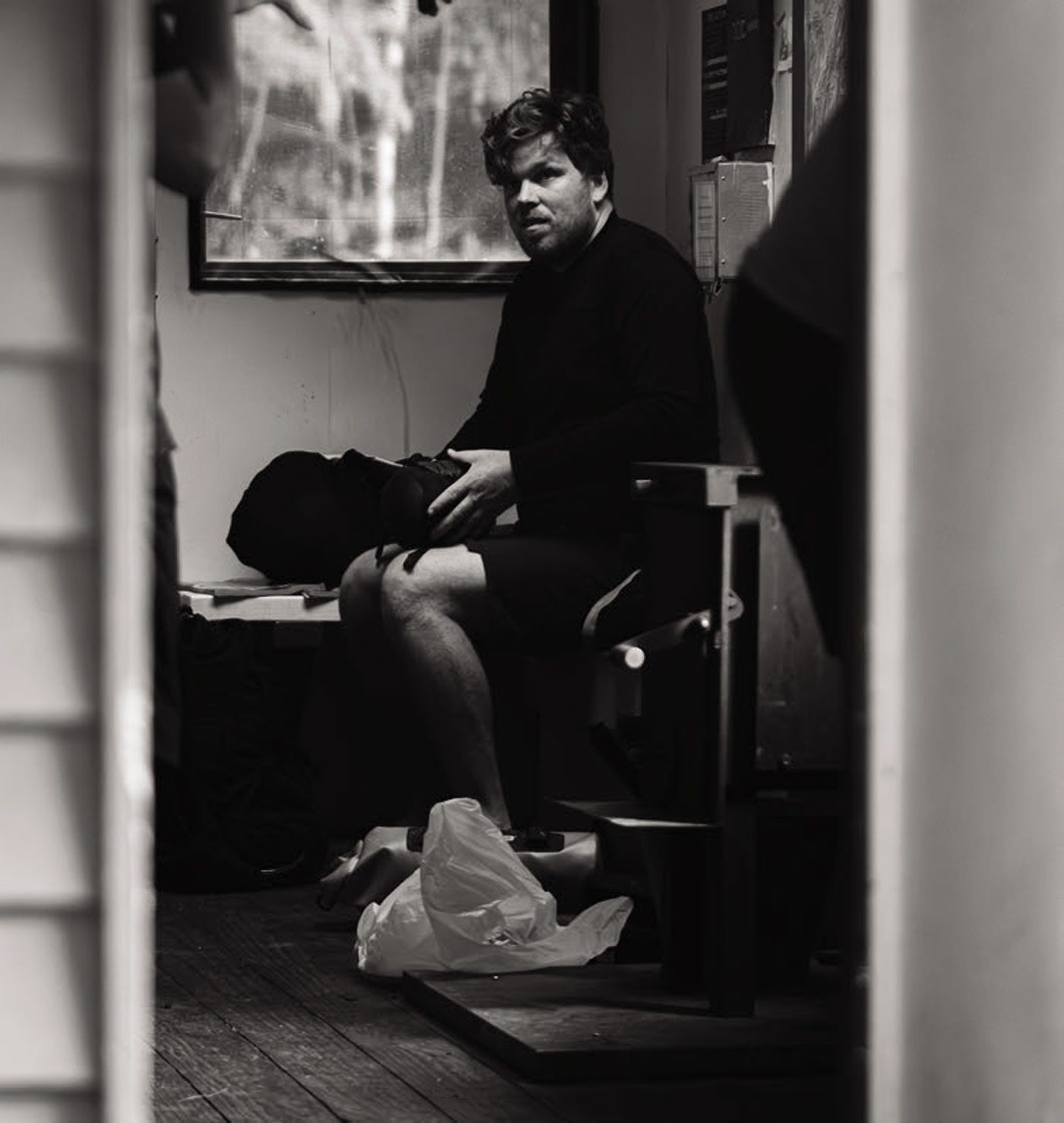
Stay tuned for Part Two of Jake Hood’s ̒The Royale With Cheese’ in the next issue of NZ Mountain Biker ...
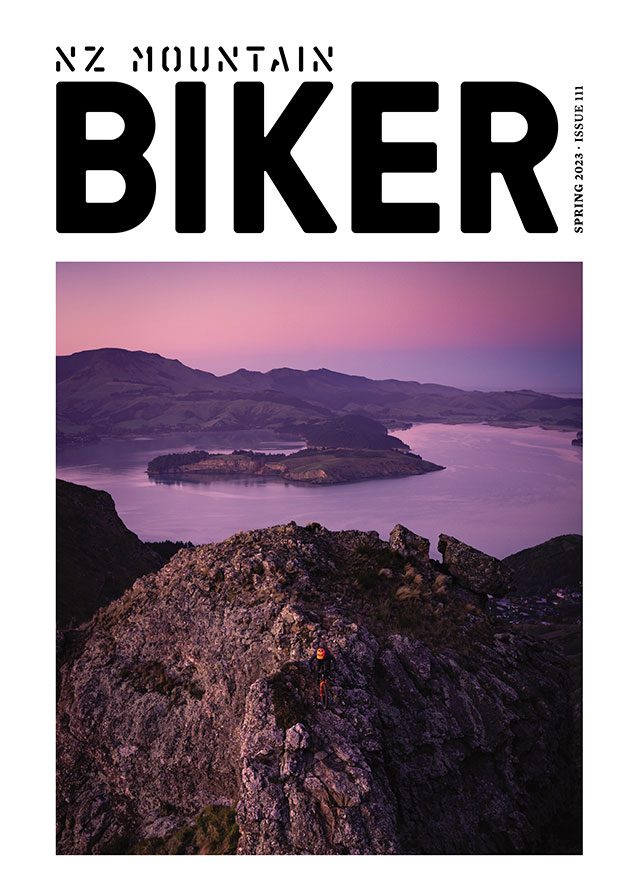
Matthew Fairbrother's race commutes
Words: Lance Plibrow
Photography: Nick Waygood, Piper Albrecht and Clancy Kelly
It’s every keen young mountain biker’s fantasy: to be at the pinnacle of their sport, spending their days racing around the world; riding in exotic locations on tracks they’ve only experienced via YouTube; to have sponsors showering them with free equipment; and to be rubbing shoulders with the world’s best each weekend as they race between the tape and then celebrate their highs or lows at a local pub, drinking strange foreign beer.
But, for every kid with a dream, there are few that have the tenacity required to push through the challenges it takes to achieve this goal. Hard work beats talent, as they say, but it takes both to break into the professional ranks.
But if there is an example to look to for how hard work can indeed turn this dream into a reality, Matthew Fairbrother must be the example. With a dream to be riding in the Enduro World Series, Matthew stumbled, somewhat inadvertently, on a way to make this happen.
“I BOUGHT PLANE TICKETS, I WAS JUST HEADING OVER BY MYSELF.”
At just 17, Matthew decided he wanted to race in the EWS. A common enough dream. Already an outstanding rider by local standards, Matthew took the typical route: worked hard, saved money, and tried to get onto the circuit. Securing the necessary qualification to be able to ride at an EWS event through local qualification rounds, the first hurdle was complete. From then, it was a question of how to get to the first race in Tweed Valley, Scotland. He knew he would need a pile of money for flights and daily expenses so, as soon as he finished Year 12, it was straight to work. “I was 17, I just worked as much as I could over summer, seven days a week,” explains Matt. “But I still didn’t have enough money.”
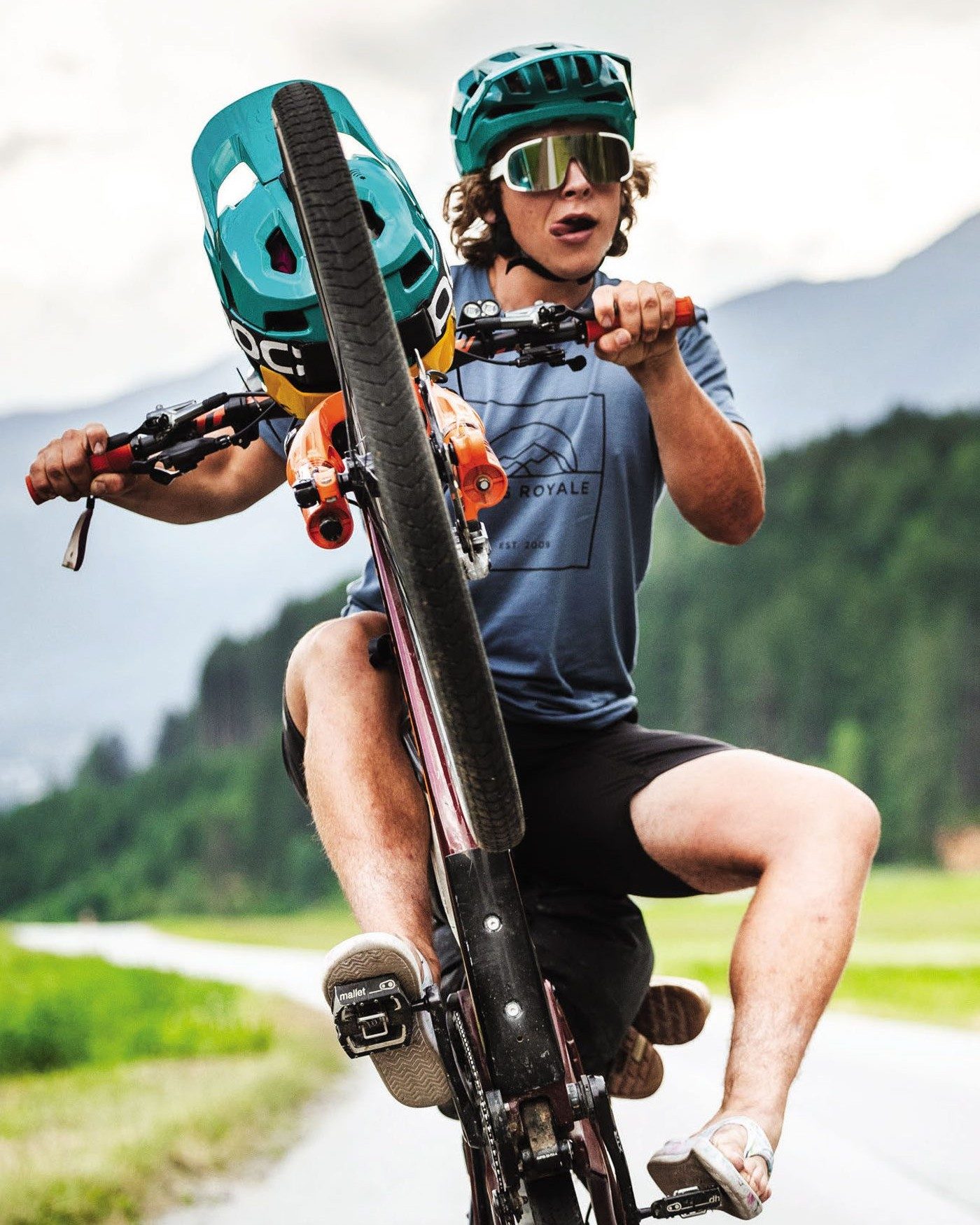
Now, the next big decision had to be made. What about the school year that was starting? It wasn’t a hard decision in Matt’s mind: “When it came time to go back to school… I just kept working. Still working six or seven days a week, sixty hours a week, trying to squeeze in biking and going to the gym around that. I was fully committed, I bought plane tickets, I was just heading over by myself. I didn’t know anyone at that point.”
Matt had been raised in a family that accepted this level of independence, and his parents didn’t stand in the way of his plans. “To be honest, I didn’t tell them much about what my plan was, because I didn’t really know myself what was going to happen. I just had a plan to get to the first race and see what happened. But I was confident in myself, and I’m naturally a pretty independent, self-reliant person, and I think they know that about me.”
The first EWS event in Scotland proved to be a fortuitous starting point. Already having some grass-roots level sponsorship through Scottish company, Deviate Bikes, he was able to foster his small connection to the company and lean on them as he landed at his first race. So, what was the plan in his head for the rest of the six month season across Europe and North America at this point? Loose. “Honestly, I just did not have a plan at all, I guess I was probably thinking there would be so many people there at Tweed Valley that would be going to the next race in Slovenia, so I was bound to be able to hook in with someone.”
But, that plan didn’t work out – for relatively human reasons. He landed in Scotland and struggled to make connections; the reality of what he was doing started to sink in. “I got to Scotland and, other than going to Australia, this was really my first time overseas on my own, and I just felt like a really small fish in a really big pond,” explains Matt. “I was actually just really overwhelmed and scared, and I didn’t seem to be able to pluck up the courage to just go up to other people around the race and talk to them.”
His plan for six months of racing was facing a reality check. But, fortune favours the brave and that’s when he had a fortunate encounter – meeting long time EWS veteran and New Zealand racer, Wyn Masters. “I bumped into Wyn Masters a few days before the race in Scotland, and he’d never heard of me but we yarned and I said, ‘I don’t know how I’m going to get to the next EWS’ and he said, ‘Why don’t you just bike there?’ He was actually joking but I was like, ‘actually yeah, that’s it, I’ll just bike there’ – totally serious. And after that I was committed, I guess.”
At this point, Matt had no idea how long the distance was between each race and how many kilo-metres he would end up riding (about 5000 by the end of the season). He didn’t even know how far it was to the next race in Slovenia, or have any idea how to get there. “I didn’t think it would be that far… but as it turns out it is, in fact, quite far. But I was committed to it and it solved my issue of transportation. For some reason it just seemed to make sense. I’m not sure how it made sense, but it just did.”
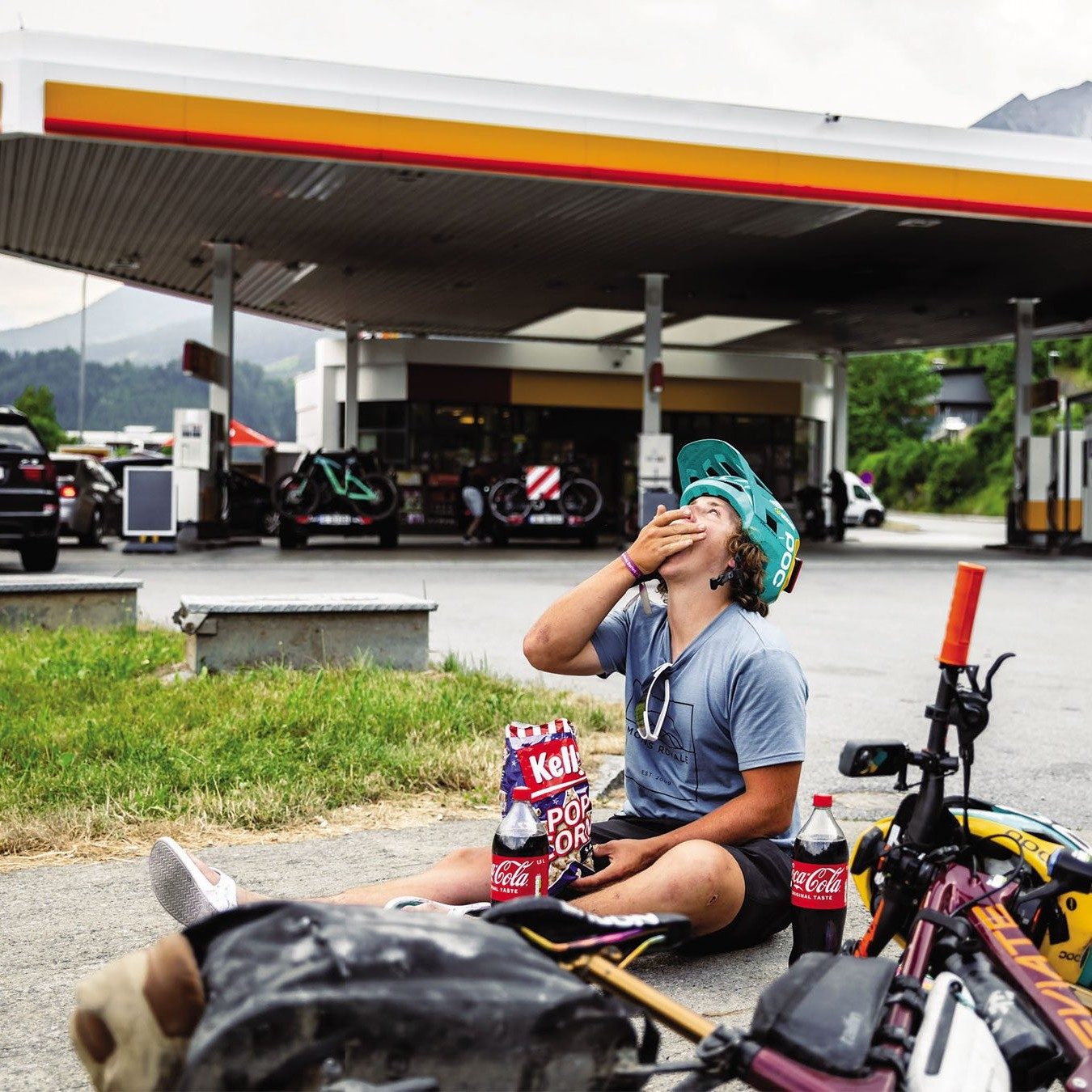
There was of course the slight problem of not being at all set up for riding across Europe. Only deciding to do this five days before he would need to begin riding, he had no bikepacking bags, so quickly jumped online to order some that would theoretically arrive in time for him to make the ride to Slovenia. However, a Queen’s Birthday long weekend meant that when they hadn’t arrived by the Friday his schedule was already in trouble. He had the Tweed Valley race that weekend to focus on as well. Fortunately, the owner of Deviate came to the rescue, driving down to Glasgow, buying some bags for him and bringing them back up. Fortunately, when he left New Zealand he had packed light. “I didn’t leave with much of a plan, but I knew that it would be harder if I had a lot of stuff. So I just brought as little gear as possible with me. I didn’t even have any non-biking shoes.” He finished the race in Tweed Valley; the owner of Deviate met him at the finish line with his bags; Wyn managed to scavenge some slick tyres off another team’s warm up bike; a quick tyre change and less than an hour after finishing his first EWS race he was pedalling to the ferryto get to the Netherlands.
Eventually arriving at the ferry, he encountered his next problem: children under 18 had to be accompanied by a parent or guardian, and they wouldn’t allow him to board the boat. “It was two in the morning in New Zealand, and the people from the boat said I needed a photo of my par- ent’s passport and to sign something saying I had permission to board the vessel. So I was calling my mum at 2:00am and I was just lucky she actually woke up.” Eventually, he was on the boat and looking forward to two things: refuelling, and relaxing in the sleeping cabin he had paid for. The boat had a buffet, so it was time to get his mon- ey’s worth and load up on calories for the ride to Slovenia. “I went to the buffet for dinner, and I just ate so, so much, as I was basically pedalling for a week after that.” But, he didn’t count on one thing – sea sickness. “After I had literally eaten as much as I could, I went up to my cabin and I was just so sea sick, I puked up all the food I had eaten. Eventually I got off the boat, feeling terrible, but I had to keep moving. So, I just started pedalling until I made it to Slovenia.”
It took six days of riding to get to Slovenia and he enjoyed two days off watching the World Cup in Leogang, but all the riding was beginning to take its toll. “At the Slovenia race…I just got demolished. I was so tired. But I was also just so stoked to be competing,” says Matt.
But the tiredness took its toll; fatigue on his body meant he was crashing more than he should have been: “I actually ended up dislocating my pinky finger in one crash – I looked down and it was just dangling out to the side. I got to a medic, and they wanted me to pull out, but I wanted to carry on, so they decided the only thing they could do was zip tie it to my other finger.” From Slovenia it was on to Italy and the round at Val Di Fassa and, if sea sickness, fatigue, and dislocating a finger were bad, here things got worse. Rain riding to the event took its toll. What might be an otherwise difficult physical task to get to the next round became mentally challenging. Too little funds to stay at camp- grounds meant that he was sleeping rough each night, using whatever he could find for shelter, to make his meagre pot of funds stretch that little bit further. He eventually arrived in Val Di Fassa and was not in a good state. He also hadn’t factored in the challenge of riding at higher altitude. “I was just shattered. And as it turns out I had COVID at the same time. I thought I was just tired from riding, but I actually had COVID. I wasn’t having much fun at the race, and I think I came 36th or something.
But, eventually, he found his groove and things got easier. Building a bit of a reputation around the pits meant people were engaging with him more. Teams would offer him food and other support. “If I ever had any issues with my bike, I would be able to go to a team and there was always someone who would help me out. I was alone, but I actually felt like I had quite a bit of support.”
And then, he bumped into Wyn again and everything changed… again. “Wyn included me in his WynTV episode, and I started getting some followers from that,” explains Matt. “Then Pinkbike picked up on me and ran a story.” Pinkbike – easily the world’s biggest mountain bike media website approached him for a story, and he was cautiously optimistic that this might help his profile. “I thought I might gain a few followers on Instagram, but didn’t think too much more about it… but then when their story came out, I gained like 10,000 followers almost literally overnight.
It just blew up. Within an hour I had 5000 followers. I had to turn off my phone for two days because it wouldn’t stop dinging.” But, amidst all this, he still had to just get on with his daily grind: getting to the next race. Fortunately, the Pinkbike exposure had boosted his marketability substantially. Deviate couldn’t have been happier, and they paid for his flights to the U.S so he could race those rounds – rounds he had previously thought would be beyond his ability to fund himself to get to.
Landing in Vancouver, he rode up the Sea to Sky highway – a reality check from the riding in Europe. “It wasn’t that far, but it was just gnarly. You’re literally fenced in, with lots of really fast highway traffic and trucks.” By this point, he was getting plenty of offers for rides from other teams – and of course there is public transport that he could have been utilising – but, by now, he had realised he’d stumbled onto his point of difference “Even with these other offers of rides, it had kind of turned into ‘I’m just biking the whole thing.’”
Arriving in Whistler, Deviate had been working in the background with SRAM to give him an unexpected surprise: Deviate were launching their new bike, the Claymore, and they had a brand new bike – decked out with all the top-end AXS and Rockshox equipment – to give to Matt, as well as a cash top-up for his riding fund. “I was absolutely blown away. Deviate had paid for my flights to Canada, and then I got given a new bike. It actually felt kinda fake. I still don’t know what to say. I couldn’t believe this was actually happening to me. It just didn’t seem real. I felt like I totally didn’t deserve it, but I was also so stoked.”
Here, he reluctantly had to jump on a plane. The 5000km from the west coast of Canada to the east coast of America was just too far. Landing in Quebec and crossing into the U.S.A proved problematic too. “They didn’t understand why I was bikepacking and why I was away for so long. They wanted to see bank statements to prove what I was doing, but I didn’t have any and I didn’t have any internet on my phone at that point and they wouldn’t let me use their internet. They were certain I was working illegally. They held me for ages, and I was a bit scared I was going to end up in jail but, after a while, they just seemed to get bored with me and let me go.”
Eventually the season came to an end. Did he enjoy himself? Absolutely. But he is also realistic about the difficulties of the experience too. “There were just massive waves of up and down. The lows are low, they really suck, and you question why you are even doing this. But the highs are so high.” At the end of the season, he had to make a decision – was he going to go do it all again? If he was, now was the time to be trying to engage more sponsors and hopefully make life that little bit easier. “I think I got on to the idea that this could actually be something. I started talking to a few companies and tried to get some sponsorship, and lots of them seemed stoked on the idea,” says Matt. “They wanted to see me do it again. I managed to get some actual funding which means I guess I’ve actually turned it into my job now, which is amazing – that was my big childhood goal.”
This season, he’s a bit smarter about the whole idea too. He’s discovered the mapping power of Komoot which takes him on much better routes than he rode the first time. “Komoot is amazing over here. It’s like Google Maps but focused on bikepacking. It takes you off the highways and takes you the scenic way. I’m off the highway as much as possible and usually in the middle of nowhere.” Which is really good because at least when he’s fatigued he’s not riding next to a highway. “Being in the middle of nowhere and tired is fine. Being fatigued and next to a highway is terrifying. I worry I’m going to lose concentration and swerve into a truck or something. Now I’m actually enjoying the riding way more. When I wake up on the morning after a race I’m looking forward to it now, when I wasn’t really before.”
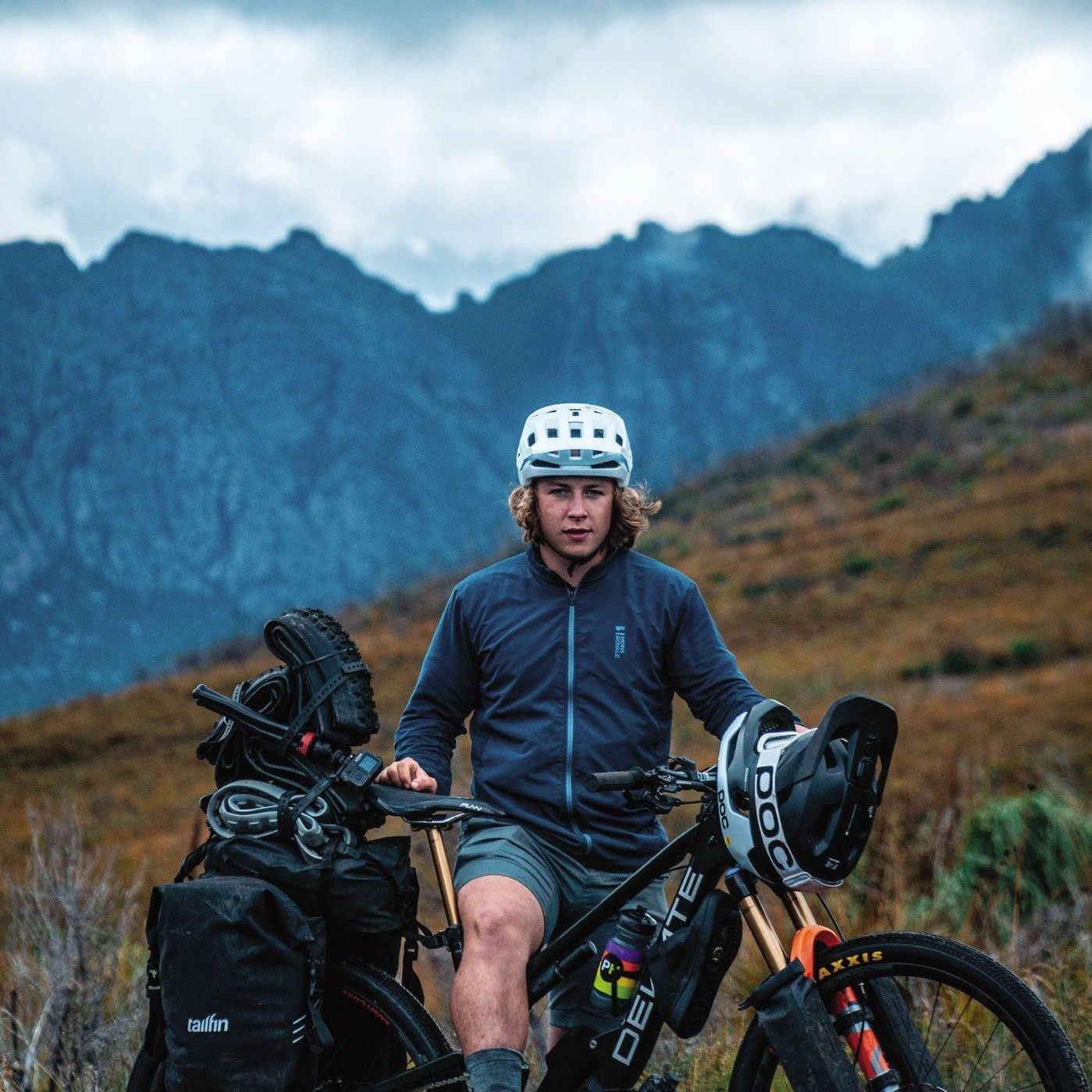
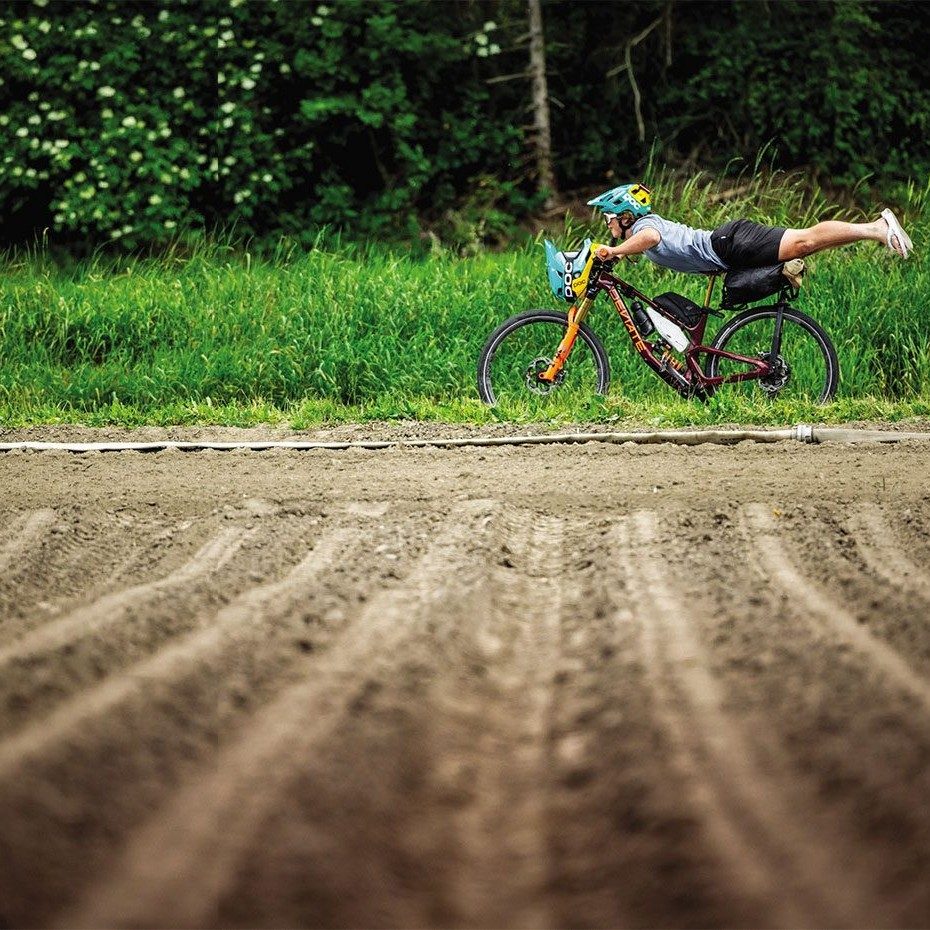
He’s tweaked his system as well, securing obvious sponsorship from Tailfin backpacking equipment. “The biggest change I’ve made is going to the Tailfin bikepacking setup. Honestly I’m so stoked on it. I was so sick of the bikepacking bags sagging and wagging around. The Tailfin has this cool pannier system so I can take so much, and it is so much more secure. I’m sponsored by them, but it is genuinely awesome stuff. I’d buy it even if I wasn’t sponsored by them.”
However, despite knowing what he was in for, securing some sponsorship and feeling more pre- pared his second year hasn’t been totally problem free. In Tasmania, he suffered the results of maybe packing too light – a few extra quick links would have solved an unfortunate broken chain affair. “At the Maydena race I snapped my chain. I had used my spare quicklink in the race, but the chain must have got a bit bent. It was 10pm and I was riding to the next event in Derby, and I stood up on the pedals and the chain snapped again – and I only had that one quicklink that I’d used earlier. I had to be at Derby the next day to sign in by 4pm, and I still had seven hours of pedalling to go. The nearest bike shop was 45km away, so I had to jog my 45kg bike 45km through the night to the bike shop – in bike shoes, of course.” A marathon in bike shoes, pushing a fully laden enduro bike? Of course.
“I GOT TO THE BIKE SHOP AND COLLAPSED AND SLEPT ON THE FRONT DOOR UNTIL THEY OPENED...”
He also entered the Highland 550 bikepacking event in Scotland, just to mix things up from the enduros he had been riding. Here, he encountered freezing weather that took its toll. “I got caught between two passes in a storm. I couldn’t set up a shelter, so I had to get to a bothy (a basic Scottish highland hut) otherwise that would be it. I was just pushing so hard against the wind to get to this hut, I ended up getting mild hypothermia and I was hallucinating. It was really quite bad.” In the end, he was on the bike for 50 hours non-stop, and with cold wet feet for a lot of it. “At that event I did some damage to my body, some days I still can’t feel my feet and my hands get pins and needles. Even now when I’m riding in the EWS, I can’t work out how hard I’m holding on to the bars, so I hold on too tight, which means I then get arm pump, then my hands blow off the bars and it all happens before I know it. So, yeah, this year I’ve been falling off a lot.” Between races he has been trying to manage the nerve damage in his hands by riding with his arms spread across the bars, so he is steering more by leaning on his forearms rather than holding with his hands. Even with Deviate offering him rides in their team van now, he is still intent on riding between each race. “I guess I just like to have a point of difference, so I’ll just keep riding this wave and see where it takes me.
I ask him if maybe he should take some time off and sort out his nerve damage which can have long lasting effects, but he doesn’t seem too bothered by it yet. And, for now, he’s still enjoying himself. There’s too much going on to worry about the challenges.
“I’m just always in the moment. There is always so much going on. It is tough, but the highs definitely outweigh the lows and there isn’t anything else I’d rather be doing right now.”

Erice van Leuven: From Wellington to the world
WORDS: LESTER PERRY
ILLUSTRATIONS: GAZ SULLIVAN
PHOTOGRAPHY: CALEB SMITH
Standing atop the podium at the Lenzerheide World Cup 2023 opener, I wonder if Erice looks out over the crowd and thinks to herself: “This is just the beginning”. Is she viewing the win as just a stepping stone towards the future, or maybe wondering; “What the heck just happened, and how did I get here?”
What began as a simple obsession on a balance bike, following her brothers around, grew into a viral video of 10-year-old Erice proving the best mountain bike is whatever bike is beneath you. She tore up Rotorua’s trails aboard her coaster-brake-equipped 16-inch wheeled kids’ bike. The video spread like wildfire, reaching such lofty heights as being included in the now defunct Dirt Magazine’s 2017 Advent Calendar. Day 14 features Erice and the caption: “this could be the raddest video we’ve seen all year.” Other notable outlets picked up the video and, overnight, Erice was on the radar of every talent scout in the industry, promptly receiving several sponsorship requests.
Commencal was early to the party and ended up being the lucky suitor. Welcoming her to their global roster, their new 20” bike suited her perfectly. A few more years of growth; roll on the launch of their 24” MTB and Erice played the lead role in their launch campaign video, again tearing up the trails to international acclaim.
Fast forward through a couple of pandem- ic-tainted years and Erice is finally old enough to race Junior UCI World Cups, and ready to step onto the bottom rung of the Junior category. In early 2023, she was announced as joining the COMMENCAL LES ORRES Team and it was game on for the season.
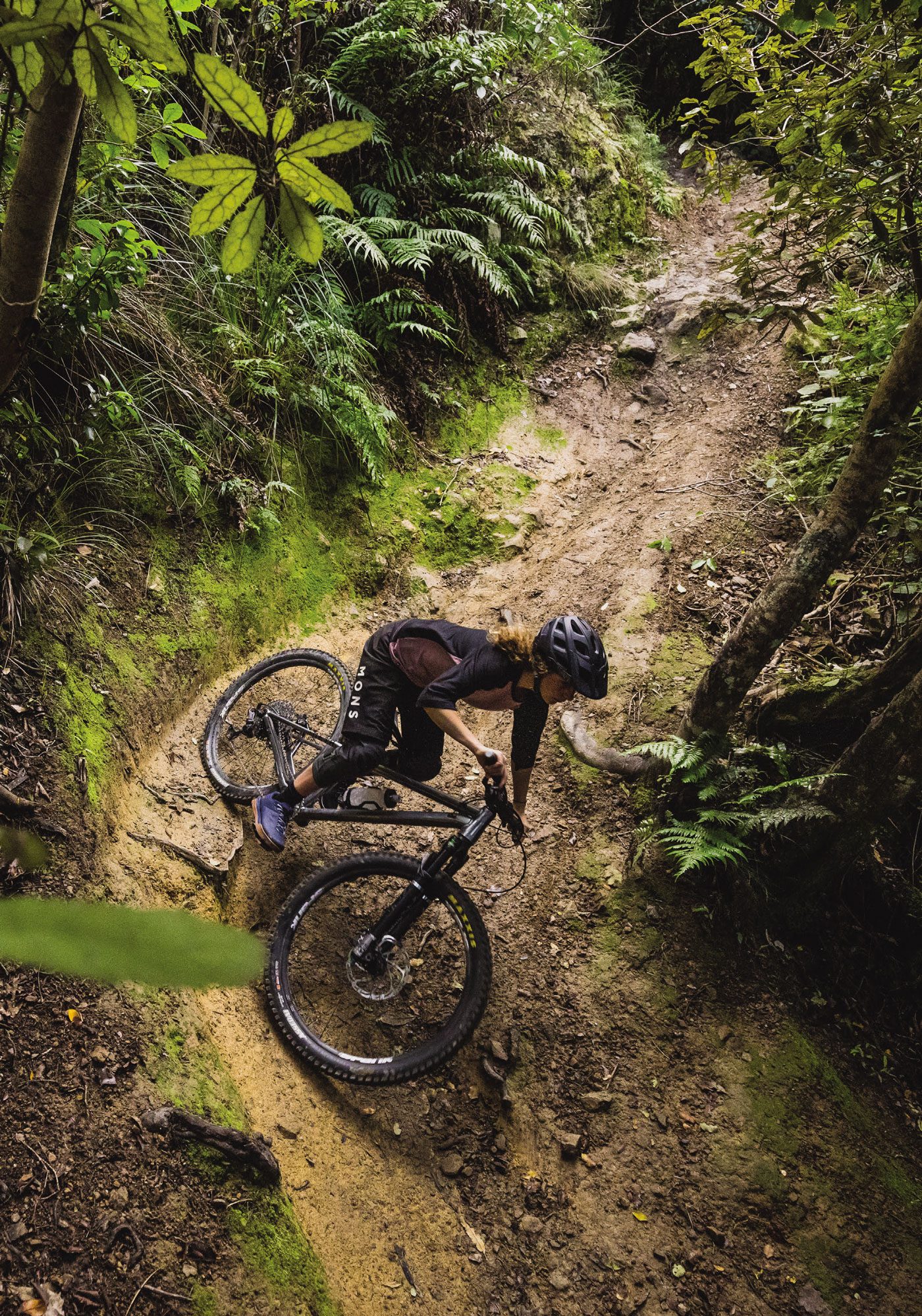
Under the wing of Cécile Ravanel, no one doubted Erice would soon grace a world-level podium, but it was a surprise for it to come so soon. Erice’s 2023 season kicked off with a pair of EDR (Enduro) World Series rounds in Tasmania. First up was Maydena, where perfect conditions and varied terrain greeted riders. A tight battle ensued between Erice and Canada’s Emmy Lan. After Erice led through race day, Emmy stamped her authority on the last stage, bumping Erice into second place. Both riders were well over a minute ahead of Elly Hoskin, who rounded out the podium in third. Erice left Maydena surprised and stoked; she was at the EDR rounds as a test to gauge where she was at and was using the race as some training for the upcoming DH season.
“Erice’s bike skills, and her ability to just ride fast, are pretty impressive. The tracks don’t scare or worry her, and she just gets on with it. She’s not intimidated by much, it seems. So maybe with age that will change, but right now she’s just super impressive on gnarly tracks with gnarly features and just super confident on the jumps and everything.
“I THINK HER BIKE SKILLS AND ABILITY TO JUST SEE THINGS AND RIDE THEM AT THE SPEED THAT SHE WANTS IS PRETTY CRAZY.”
– CAMERON COLE, FORMER WORLD JUNIOR DH CHAMP AND GT FACTORY RACING TEAM MANAGER.
I guess it’s a bike skills thing, but maybe she’s also just riding the bike to get the best out of it. I think bikes have changed quite a lot and you can trust them so much more nowadays. So maybe there’s something in that as well.” – Cameron Cole, Former World Junior DH Champ and GT Factory Racing team manager.
Round 2 of the EDR took in the now-famous Derby trails, some old, some new. Practice day was wet, and by all accounts just getting through the course that day was a task in itself. Race day was hot and humid, and the trails were still wet from the previous day’s rain.
“On race day I was thinking, I’m actually kinda up there so why not go for it!” explains Erice. After putting in a huge effort across the first five stages, she experienced painful leg cramps on the liaison to stage 6, which saw her stop multiple times to stretch out.
“I was a bit scared then that I wouldn’t be able to finish the race, because of the pain.” Fortunately, Erice pushed on, continuing her domination, topping every stage and obliterating her U21 competition. Her overall time would have placed her 16th in the Pro Women’s class!
Finishing her Tassie time on a high, she set her sights on the main goal of her season: the World Cup Downhill series. Six weeks after her win in Derby, she lined up at the opening round of the French DH Series; another race, another win! With momentum building over the last few races, she was back in action a month later – this time at the World Cup season opener in Lenzerheide, Switzerland.
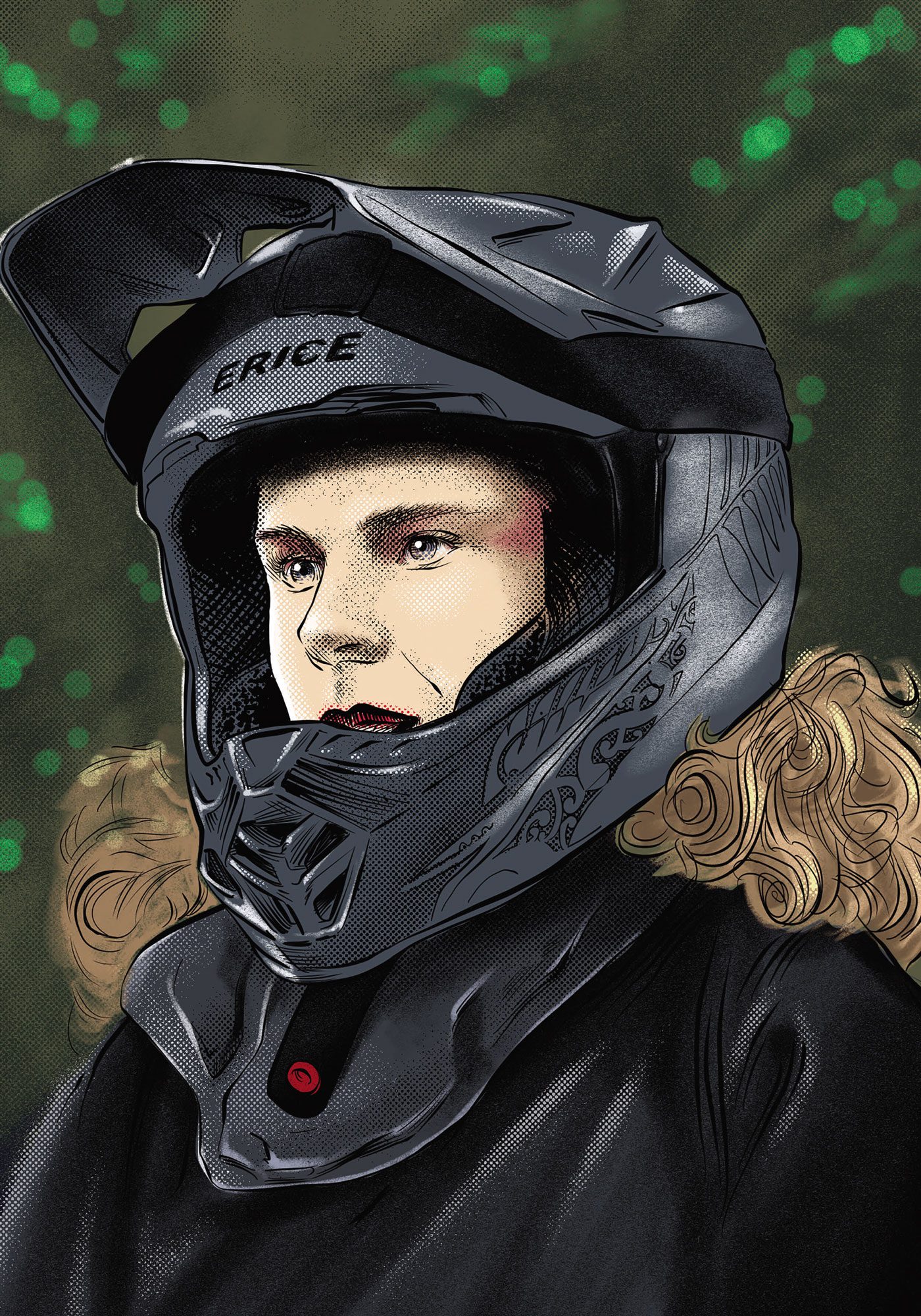
“The track in Lenzerheide was so sick, the sections just linked up real good,” says Erice. “It’s obviously a difficult track but it allows you to push quite hard for speed, which is cool. The top section on the off-camber grass and then onto the famous off-camber corner were the most difficult for me, it was still fun though. I just enjoyed the track heaps and that’s when you ride your best.”
For the first time in history, the Junior races were broadcast live and free on YouTube, allowing friends, family and fans from across the world to see the future stars of the sport laying the foundations for their careers. Watching the action unfold over the week, clips of Erice practising surfaced. What we saw was a confident, solid riding style which piqued onlookers’ interest and had com- mentators picking her as one to watch.
A crash in qualifying put her in second place. But, harnessing her nerves, she headed for the start hut to take on her final run, confident her pace was there. Minimising outside distractions, she visualised the track, focussed on the present and task at hand, rolled forward and broke the timing beam.
“As I was injured at Lenzerheide, I spent a fair chunk of time trackside and that included watching the always entertaining junior practice. I’d followed Erice online but hadn’t really seen or met her in real life, and from run one in Lenzerheide it was fairly obvious that she had something special going on.
NZ DH with Erice at the helm is in safe hands both on and off the track. Her skills are something else, but so is her infectious stoke for both the riding and the other girls she was racing against. Big grins and big wins seem to be the ticket here.” – Eddie Masters, Pivot Factory Racing pro.
Five sectors made up the track. Erice started slow, building across the first three splits, then demolished the final two to put her just over four seconds in the green. She’d just secured her first junior World Cup win!
“When I won my first World Cup, the feeling was insane!” explains Erice. “I was totally over the moon. Having my dad and one of my brothers there, and some family friends, made it extra special! Another highlight was getting to see family after two and a half months. It’s so, so cool being over in Europe racing, but it is hard not seeing the fam for a while.”
Riding the high of her win, everything was looking positive as the World Cup circus headed to Leogang, Austria. A win in the qualifier put her as the fastest seed coming into the finals.
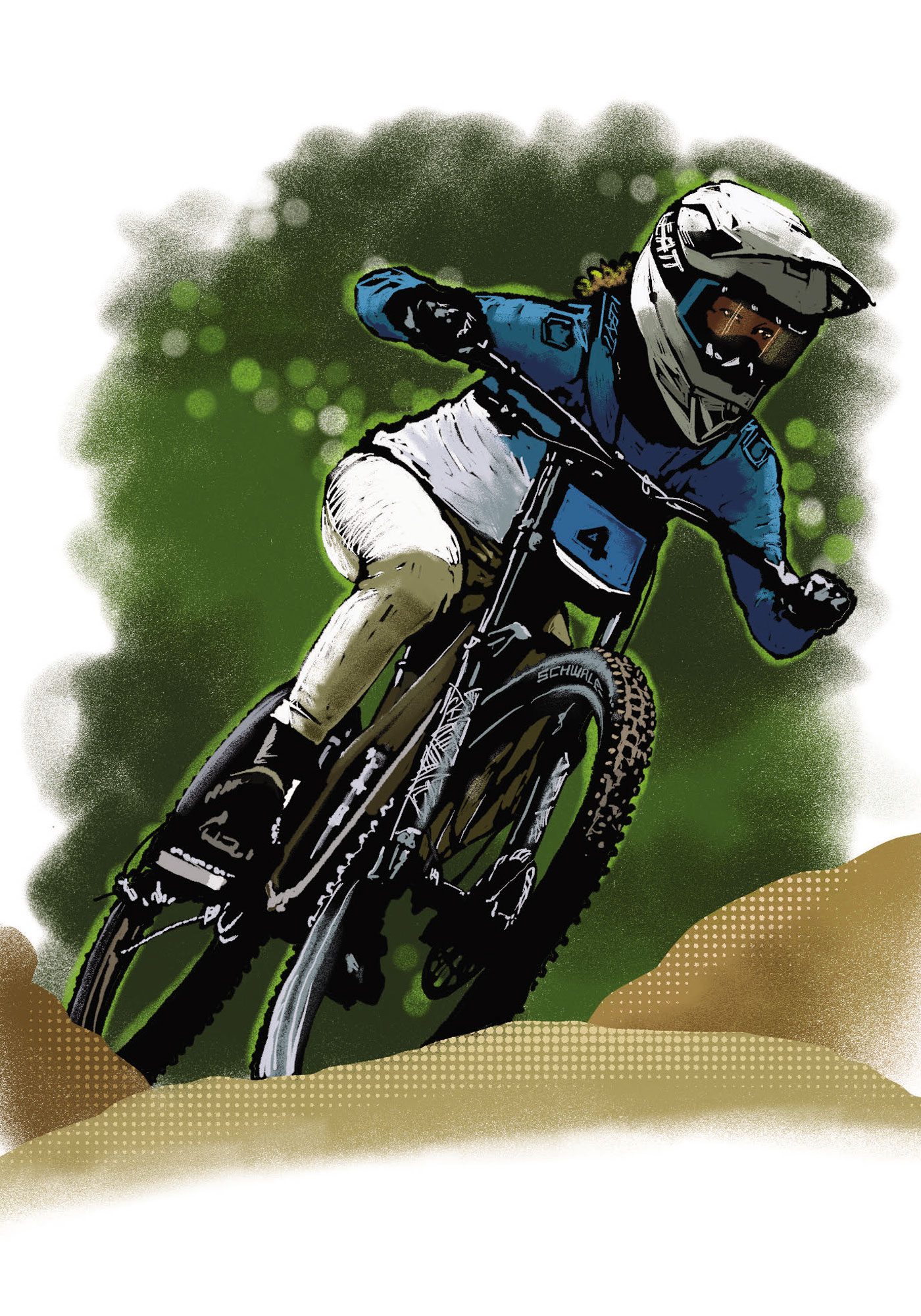
“In Leogang, I was feeling really mentally strong in my warmup at the top and on the rollers, but once I got into the start gate, the nerves hit me and I lost that composure, and that obviously didn’t work out great for me.”
Only a couple of corners into the track, Erice took a huge crash – over the bars, down a bank and onto a gravel road. A dead-stop hit that even the hardiest of rugby players wouldn’t have bounced up from.
“It was the scariest crash I’ve ever had,” recalls Erice. “I just fully body-slammed the ground and didn’t roll or anything to break my fall. Just hit it and stopped. I winded the crap out of myself so that was pretty scary because I couldn’t breathe for a bit. I can’t believe that I got away with two sore wrists and a sore torso! Nothing was broken, but I couldn’t finish the race. Looking on the positive side though, I’ve learned a lot of lessons. So, I’ll take that.”
A short two-week break between Leogang and the following round in Val Di Sole left minimal time to get her body back in shape after her crash; no downhill riding and just light road riding and gym work saw Erice nervous coming into round three. Getting back on the bike and straight into one of the most challenging tracks on the cir- cuit took all the resilience and determination she could muster.
Fellow Kiwi, Sacha Earnest, was also returning from injury at Val Di Sole, ready to take on the Junior Women’s field. Qualifying saw tight time splits between Erice and Sacha, the latter taking the number one points on the day. In finals, the cards stacked the same way, Sacha taking her first World Cup win, and Erice in second. Erice left the venue happy with her performance, and proud of how she’d bounced back after the crash in Leogang. Second was almost as good as a win!
Next up for the young star is the Downhill World Championships in Fort William, Scotland. But first, some training at team sponsor Les Orres’ bike park and a test event in Loudenvielle in the lead-up to the World Cup event there at the start of September. Erice’s calendar is chocka!
The World Cup continues throughout the year, culminating with the final round in Mont-Sainte-Anne, Canada, in early October. We’ll be watching Erice and compatriot Sacha closely as the rounds tick off. Fingers crossed we’ll have two Kiwis atop the overall World Cup podium come the end of the season – which order they’ll be in is anyone’s guess.

Out of Office
Words: Lester Perry
Photography: Cameron Mackenzie
Taking a line down the centre of the upper south, I’m gliding over the Nelson lakes, checking out the snowcapped mountains around Lake Rotoiti, spotting trails in the surrounds and beginning to wonder what conditions in Christchurch will be like. Continuing south in clear skies, I’m live-routing trails through the hills, debating to myself if humans have even set foot on those peaks, let alone a knobbly tyre. Oh look, a high alpine lake.
Soon the pilot announces we’re about to start our descent into Christchurch, and within minutes we go from a ‘barely a cloud in the sky’ scenario to a “heck, we’re fully socked in the cloud! How the heck do the pilots see where they’re going?!” situation, with all faith put in the altimeter.
What were mental images of fanging down dusty trails, basking under crisp blue skies are now nervous butterflies in the pit of my stomach – was this a mistake? The unknown almost consumes me as I nibble the last of my bite-sized cookie and sip the dregs of my inflight coffee. Conditions now appear to be somewhat unpredictable.
“I’ve got 48 hours off from the world, man. I’m gonna blow steam out my head like a screaming kettle, I’m gonna talk cod sh*t to strangers all night, I’m gonna lose the plot on the dancefloor. The free radicals inside me are freakin’, man!” Jip, Human Traffic, 1999.
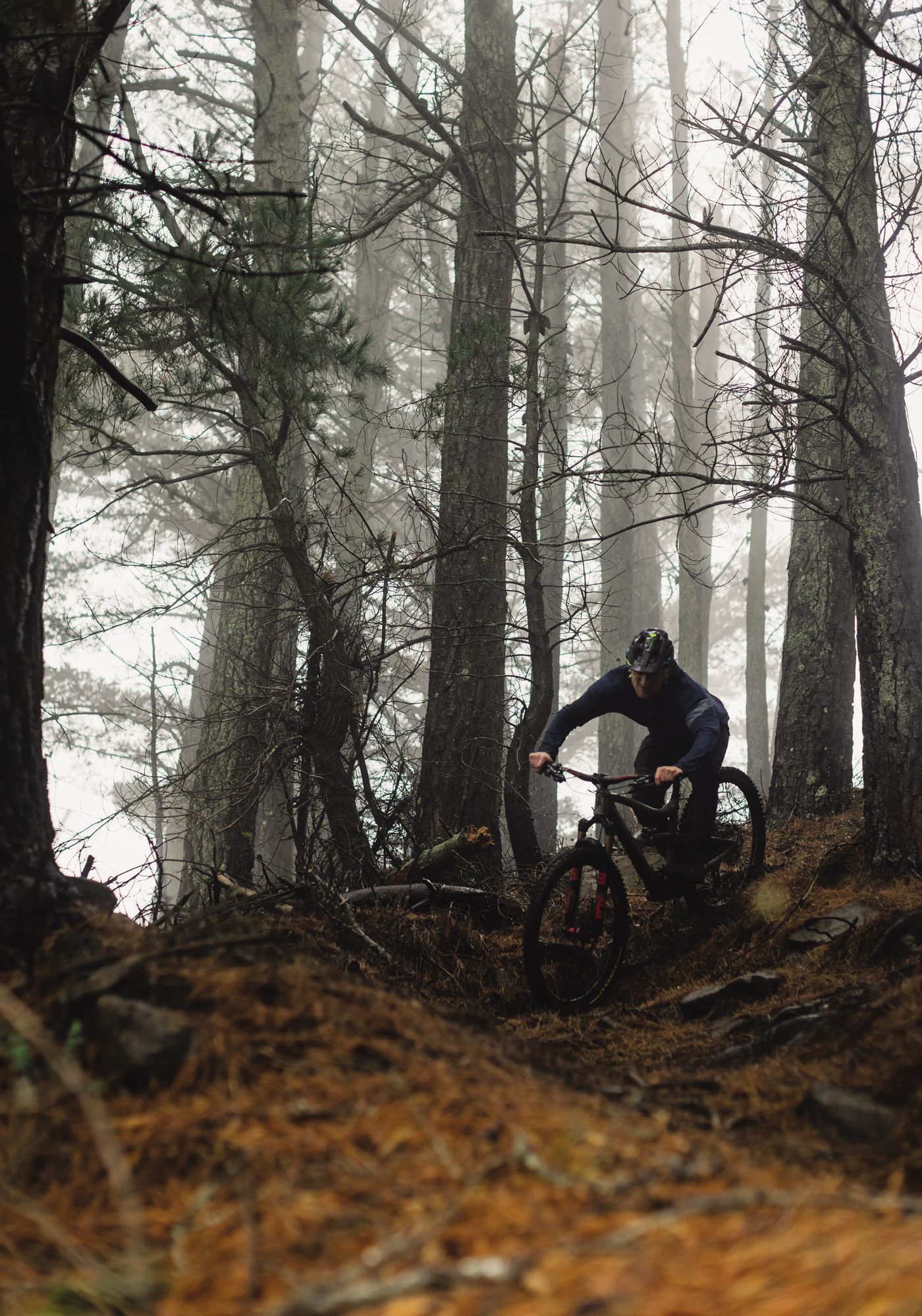
My trip south won’t be as hedonistic as the lads from Human Traffic would have had, but Jip’s comment portrays the vibe perfectly, as I await my arrival into Christchurch. I’m headed south for a bit of a pre-season ride camp – although maybe it’s post-season, seeing as it’s closer to the end of summer than the start. An opportunity to try some new things, test some new gear (see our Pirelli tyre review in this issue), take a quick break from the daily grind and hang out with mates on bikes – that’s what it’s all about, isn’t it? I’m here for a good time, not a long time. It’s not Whistler, but time away from the daily grind is what I need.
When it comes to getting the right weather, trip planning in winter is always a roll of the dice. At the end of the day you just have to commit and deal with the fallout, should you have to. In this case, we’re dealing with low cloud, drizzle and temperatures lower than ideal for this central North Islander – although surely nothing a Christchurch local doesn’t deal with on the regular. And anyway, there’s no such thing as bad weather, just bad gear – right?
I’ve been riding and racing mountain bikes for almost 30 years – yes, I’m that old – and the bikes have changed and evolved as much as my life has in that time. I’ve never been one for testing or trying anything too different from the norm; my bikes sit pretty much stock as they come out of the box. After a couple of seasons of feeling a bit stale on the bike, it was time to mix things up and try some new stuff. After all, if you keep doing the same thing you get the same result. Even if you’re not racing, we all want to be the best we can be on our bikes. Even the act of trying new things, finding out they’re not for you, and reverting back to the status quo can help elevate your game; a renewed sense of freshness, or the confirmation that what you’ve been doing is in fact the right thing to do.
After a quick bike build and mounting up the fresh Pirelli Scorpion aboard my, as yet unridden, mullet setup (27.5 rear, 29” front), it was off to Christchurch Park for some laps and to get acquainted with the trails. Low cloud clung to the houses heading up Dyers Pass road, and my stomach sank right into my Merino socks; conditions were not ideal. Buck up buttercup, there’s work to be done and the opportunity to get away to the Mainland and ride doesn’t come frequently.
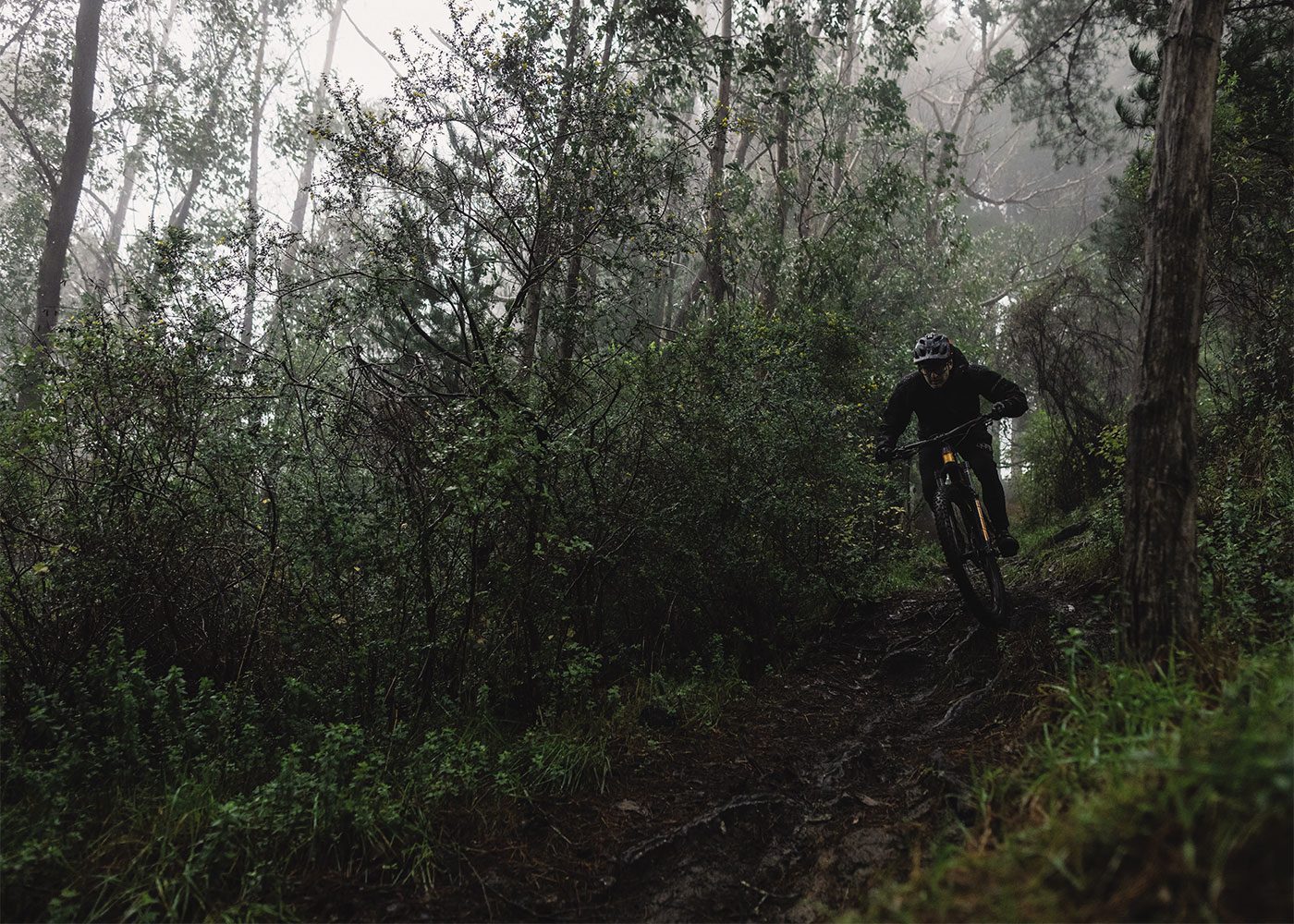
I’d met up with local trail hustler, Nathan Petrie, to show me around and get a local’s lay of the land. I had limited hours on the ground so there wasn’t time for the admin needed to figure out where I was heading, or waste time on trails that weren’t what I was chasing.
We did a lap down ‘The GC’ DH track to throw the tyres down precisely what they’re designed for – it’s a good mix of rocks, steeps, plus some speed and even bike-park style sections. Right from the get go we were on slippery hardpack – not conditions for inferior tyres! The fresh Pirelli’s hooked up well and gave us the confidence to push on down the trail. A couple more laps, then the sun dipped, the shadows grew long and we called it a day.
A catch up with Christchurch-based family over dinner, solving the problems of the world, followed by a night well slept at the Novotel, and I was set for day two on the trails. This would be another opportunity to put the Pirelli’s to use on slightly different terrain than the previous day. A Supreme breakfast, a long black, and an oat flat white – yes, a trip like this tends to revolve around food – we were hyped for the day.
I’ve not done a tonne of riding around Victoria Park, but every time I visit I’m astounded by just how many trails are crammed onto that hill – there always seems to be something new. Maybe it’s the out-of-towner in me seeing everything anew?
We took a couple of laps down who knows what trails – I was merely following the wheel in front, trying to keep it upright as we slithered through multiple rock-strewn chutes, caught by the trustworthy berms at the bottom. Although the conditions weren’t ideal, sharing the experience with mates made it all worthwhile regardless, and the trails, although wet, were plenty manageable and safe provided we kept a lid on our speed. The change from my usual mid-North Island conditions was rewarding and reminded me why trips like this help keep things fresh and exciting.
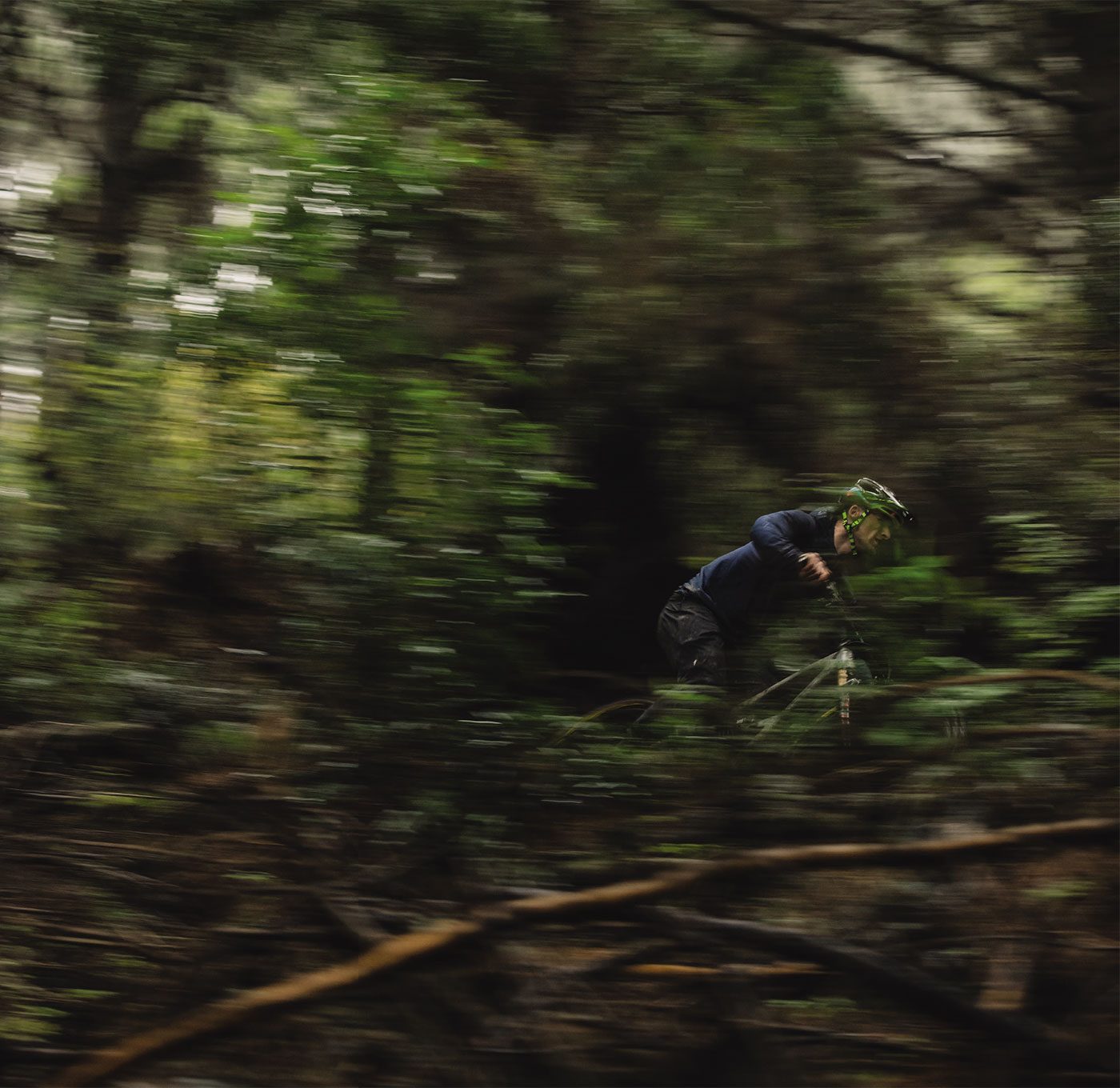
A few tweaks to my setup, a few extra PSI here, a few less there – things were looking up, until we realised we’d not had lunch and the day was drawing on. A detour over to the Sign of the Kiwi Cafe had us nervously tiptoeing inside, attempting not to leave a wet, muddy trail on the floor behind us. Our hosts weren’t concerned, beckoning us to take a seat by the heater, but we knew our place so headed outside to the deck. After devouring coffee, cake and a piping hot sausage roll the diameter of my arm, we headed over to the crowd favourite, Gnarly Nun.
A few post lunch laps through the upper rock slabs gave me the opportunity to get a feel for my new setup on unpredictable but solid terrain. Luckily, after the tweaks made to my setup – and the Pirelli’s rubber compound – everything felt surefooted and Nathan and I confidently rode a few laps through the sections – unscathed regardless of the dismal conditions.
An out-of-towner visiting gives the perfect excuse to show off your favourite spots to eat, and each time I’ve visited Christchurch on a riding trip I’ve been treated to some of the best IYKYK spots. This time around, Cassells Brewery was the dinner spot. Our small crew dined like kings. I took on the chicken burger (highly recommend), while sampling a freshly brewed Tropicana Hazy IPA… old habits die hard. I must have missed a trick though – the rest of the team went with a perfect winter option in the Double Cream Milk Stout, which seemed like a meal in itself!
Before the sun was up, my trip was over. An airport coffee and buttery croissant ease the pain of heading back to normality; knowing I’d had a good 48 hours living the dream. Just a few hours later I was sat back at the desk of my day job, reliving the lines ridden over the previous couple of days, and excited to put some of my new found freshness to work on local trails.
Christchurch was a good time. I didn’t talk “cod shit to strangers” nor “lose the plot on the dance floor”, but the Free Radicals in me were “freakin” for sure.
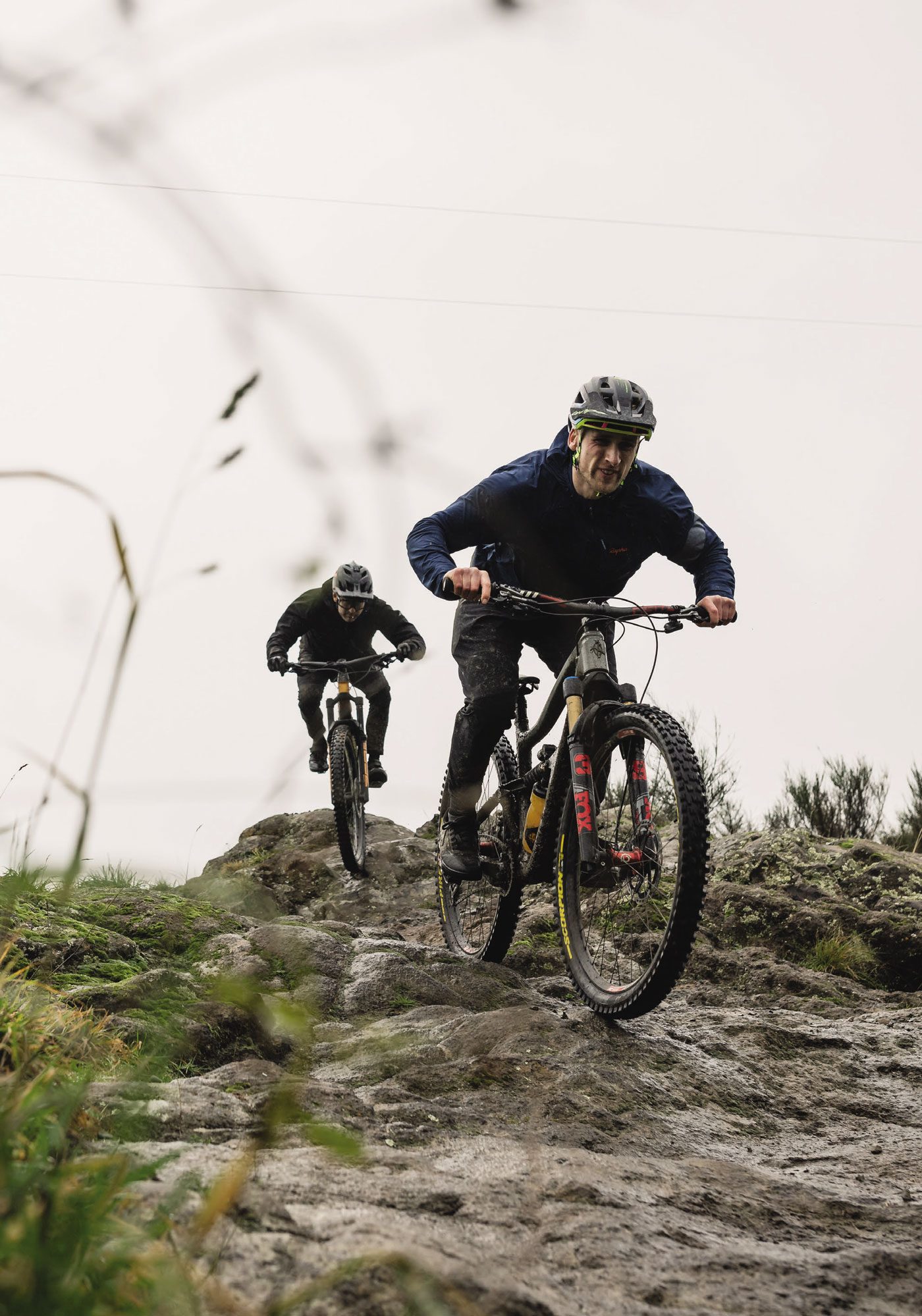

Cairns by eBike: A cranking good time
Words: Alex Stevens
Photography: Cameron Mackenzie
On site at Crankworx Cairns, back in May, photographer and writer Cam Mackenzie was keen to snatch a few hours away from work and enjoy riding one of his favourite mountain biking destinations. With good mate and pro rider, Sam Blenkinsop, also in Cairns to compete, it seemed like the perfect opportunity to introduce him to another good friend – local and pro rider, Berend Boer – to showcase what Cairns had to offer. Cam tells the story:
Over the years, I’ve been fortunate enough to travel to Cairns, for work, almost yearly since the Downhill World Champs was hosted there in 2017. Off the back of that trip, I fell in love with the area, its diverse trails, red dirt and grandeur, but was also fortunate to meet my now-close friend, Berend Boer. In the years since, I’ve been back and forth for various different tourism projects, showcasing mountain biking in the far north in what I hope has been an engaging and relatable kind of way.
With Crankworx and major events coming back to Tropical North Queensland, and Cairns in par- ticular, it dawned on me that we come and go so quickly within these regions, and often we just don’t get the time to ride and enjoy all the fun trails I’ve come to know through the local riders over the years. So, this year, going back to Cairns for Crankworx, I saw a really cool opportunity to introduce two great mates and go for a really awesome explore through the rainforest, show- casing Cairns to Blenki. Although he was fizzing to compete – and had a hectic race schedule, as he pointed out – what’s the point of coming to these places if you don’t get to see them for what they are?
Blenki and I were both travelling from New Zealand and knew we would have quite a limited amount of time on the ground. With an already busy event schedule subject to inevitable changes due to the weather in the tropics, we had quite a small window of opportunity to get off site and into the jungle. Luckily, Blenki had his new Bosch- powered Crestline, which he was able to bring with him, and Berend and I were able to pinch a couple of Mondraker Crafty Rs, also sporting the latest smart system kit from Bosch, from the guys at Mondraker Australia. Without the eBikes, we wouldn’t have been able to check out even half the spots we did, nor would we have been able to maximise our short windows of opportunity.
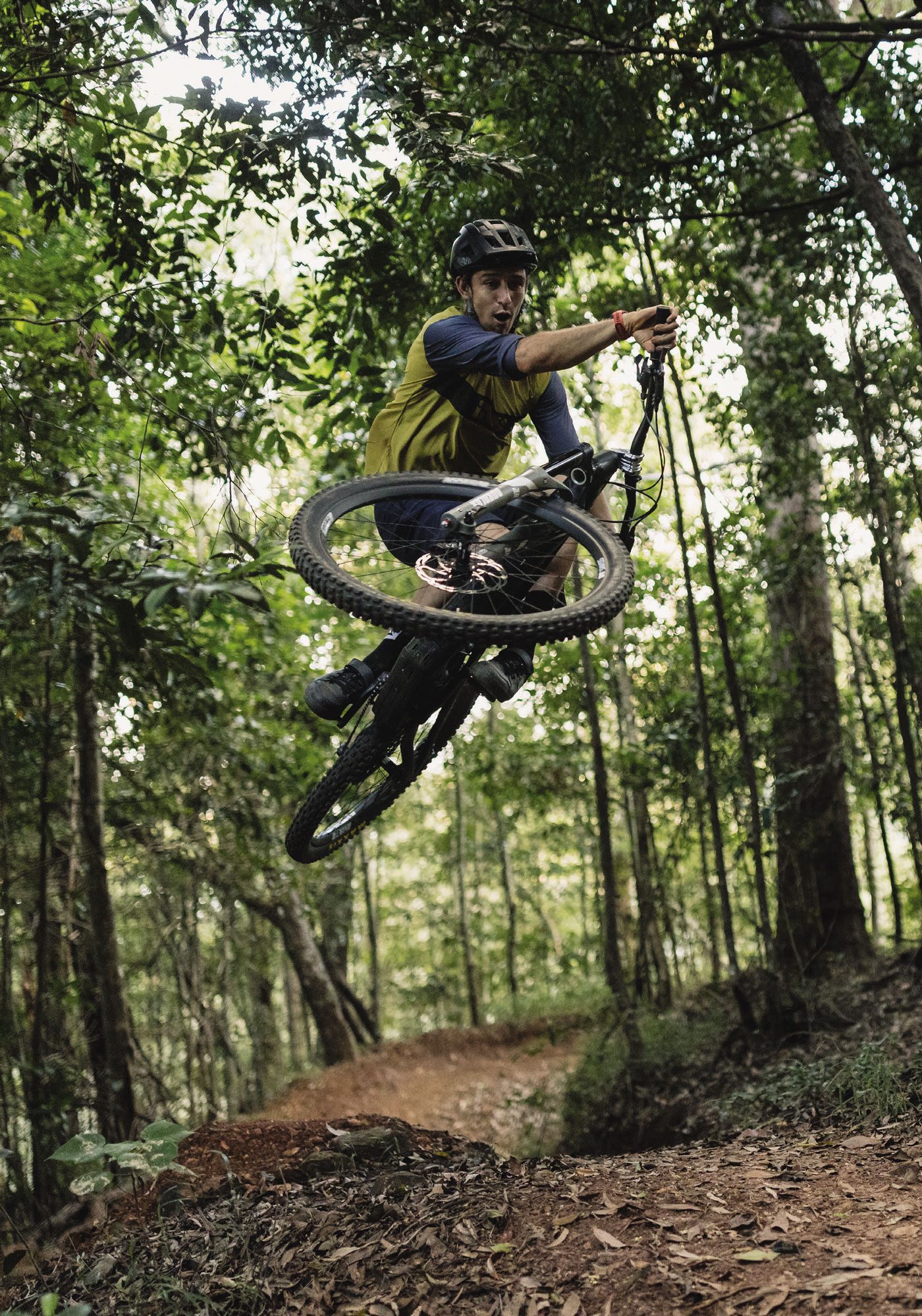
Mountain biking in Cairns goes back several decades, when influential and pioneering locals like Glen Jacobs first recognised its potential, in the 1980s. You can tie back points in time to key developments of mountain biking in the region, with the Cairns Mountain Bike Club hosting its first nationals in the early 1990s, and World Cup events following soon afterwards in 1994 and 1995, then the UCI World Champs in 1996. A fuse had been lit and, since then, mountain biking has continued to grow in the region.
Whether it was dedicated locals looking to build more trails for themselves to ride, or trying to bolster the region’s offerings, these different trails and parks have combined to create a strong, diverse network that stretches all the way along the coast and deep into the tablelands.
Hidden in the hills behind the James Cook University campus, 20 minutes north of the city, Smithfield Mountain Bike Park was where the first international race was held and has now become the epicentre for mountain biking in Cairns. With Smithfield also being the venue for Crankworx Cairns, this seemed like the perfect place to begin our exploration.
The terrain in Smithfield is really steep in spots. You’ve got lower undulating grassland trails but also stuff that rises high and steep into the jungle canopy, which the eBikes were perfect for. The Nationals downhill track, for example, is so steep that the ride up is almost inaccessible on a traditional bike. On an eBike though, you can just blast up there like you would in a shuttle vehicle – but self-propelled. The trail is one of the steeper, longer, rocky trails in the park, which was exactly the kind of thing we were looking to ride and showcase. It’s a real staple of Cairns, and feeds into other parts of the park really well, linking a brake-burner descent into fast, flowy turns and lofty jumps like those found on the newly built trail, Bowhunters.
With a few laps under our belts, that soon wrapped up a quick taster for what Cairns had to offer on the first day. Had time allowed, we would also have ventured out to the Atherton Tablelands. Only an hour or so drive from Cairns and sitting around 1000m above sea level, Atherton is a beautiful, quaint country town, full of small-town pubs and really quiet, with a less humid climate. With Atherton sitting much higher than Cairns – and to some degree, sitting in the clouds – the bush cover is made up more of eucalyptus and gum than the dense tropical rainforest found lower down. The dirt is similar, a bit more rocky and gravelly, but the trails are built in such a way that they are quite different to those down on the coast in Cairns.
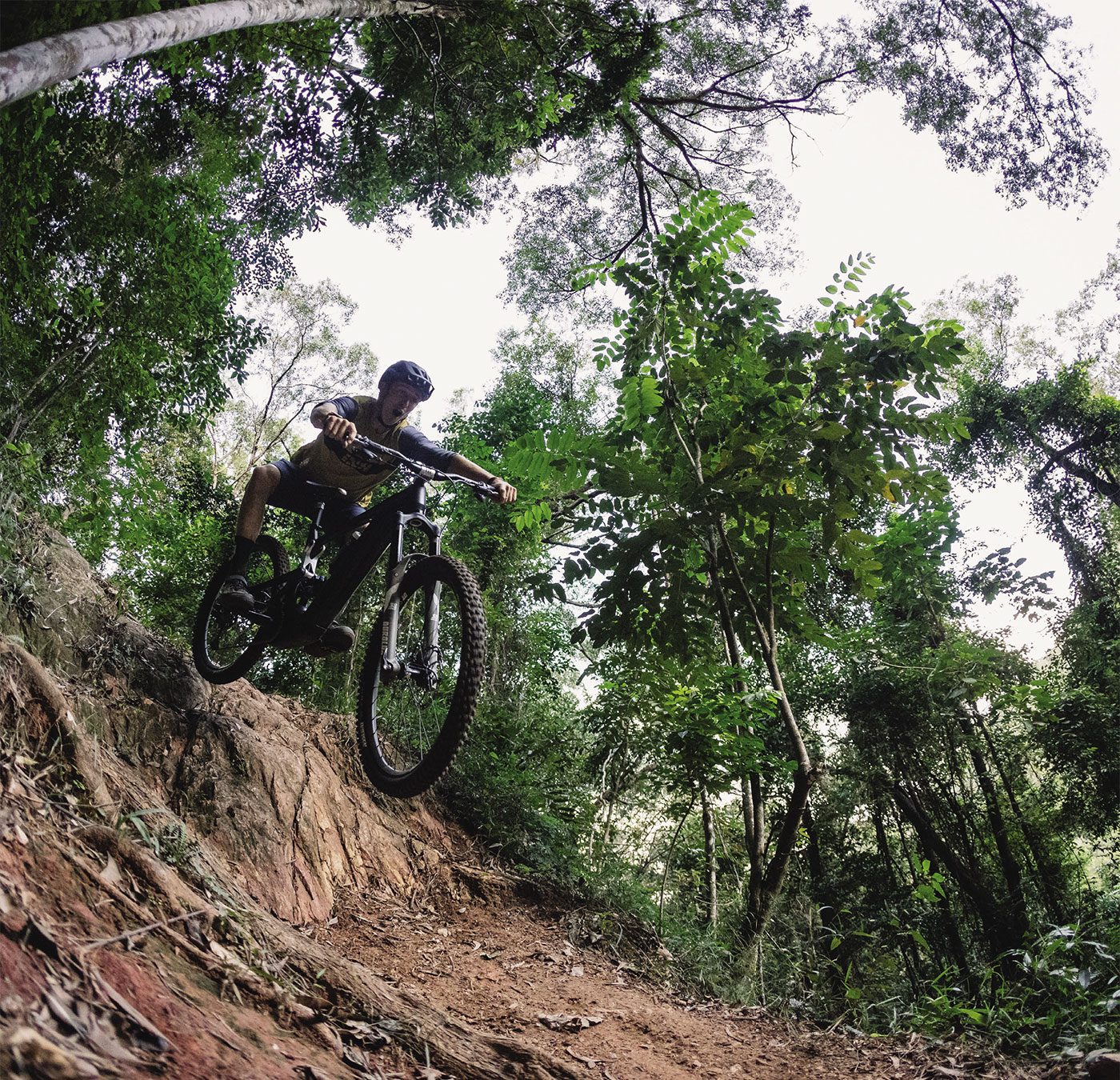
If you’re visiting the area and have a bit of time, I’d definitely recommend checking it out, especially on an eBike. The bike trails are all on one face, out the back of the township, with some big grunty climbs and lots of short descents running off everywhere – perfect for repeating cool little loops on an eBike. On the way home, be sure to stop off at Lake Tinaroo for a cool down before heading back into the hustle and bustle of Cairns.
The next evening, we decided to boost out after the event finished and make the most of the hour and a half of daylight we had remaining. Berend really wanted to show us some of the lesser-known trails in an area up near Copperlode Dam, to the west of the city. Just 15km away from Smithfield, this area offers a distinctly different riding experience, as well as climate. Sitting higher up into the bigger mountains, there are reservoirs and dams, and the terrain is quite raw and rugged. It’s definitely somewhere you need to go with a local, and we were stoked to have Berend guiding us in this unique area, particularly with the weather turning stormy and the light all but non-existent. It was definitely too dark to shoot any photos, so this one will just have to stay etched in our memories!
It turned into a pretty hilarious scene: the three of us all of varying skill level from pro (Blenki and Berend) to not-pro (me), trying to keep up with each other riding some of the steepest trails in Cairns, in near on dark. Add in the fact that we were also in one of the most dangerous parts of Australia, where if you fall you’ll not only rip your clothes to shreds, you’ll also be waiting a while for a rescue, or a snake could come across the trail at any moment. Somehow, this all just added to the hilarity of the situation.
Cairns is really unique in its topography; you have these crazy, steep, rugged hills clad in UNESCO World Heritage rainforest rising out from the sea. It’s an insane juxtaposition between one natural wonder of the world, the Great Barrier Reef, sitting right next to the Daintree rainforest which extends across the coastline as far as the eye can see. Our mission for the next morning was to head out early to experience the stunning views across the city, and the reef at sunrise, before blasting some fun trails back down to a great coffee, whilst beating the heat and getting a run in before another day of events.

We opted to head up to Kuranda, one of the original tracks in Cairns, which runs off the side of the Kuranda Range Road and through to the famous Kuranda village and railway, sitting deep in the ranges behind the city. We had the option of either riding up on the eBikes quickly, or shuttling up like you would on a traditional bike, opting for the latter due to the early start. The main start point for the Kuranda trails is a beautiful lookout and, from there, we had the pick of some of Cairns’ oldest trails or the option to ride the newer community-built trails that Berend himself works on, rides and loves. We opted for the tried and true option that morning, showing Blenki what Cairns is so well known for in the downhill space: the Kuranda Downhill Trail.
No matter where you go and explore in Cairns, you can find the most incredibly diverse ecosystems within the forest, changing from one location to the next. That morning, up on Kuranda, we got super lucky: we were ripping along and, on our way out at the bottom, we stumbled upon a grove of butterflies which Berend, who was leading us out, disturbed. As Blenki and I arrived, Berend was screaming in excitement at the scene that lay before us. It was like riding into a butterfly sanctuary.
There were thousands of butterflies floating in the air underneath the canopy. You just don’t get stuff like that anywhere else in the world. By the time we’d gotten to the bottom, we were giddy. We’d just ridden this super fun trail with beautiful, big, flowing berms into steep rooty goodness – whatever you wanted it was there; flow, steep stuff – then, all of a sudden, you come across these butterflies. All before eight in the morning.
The wildlife is definitely one of the highlights of riding in this beautiful, unique area. As well as the butterflies on our early morning ride we saw plenty of other little critters out on the trails. It’s nice to know that there are also safe swimming spots where you can cool down without the fear of crocodiles, jellyfish, snakes, spiders or whatever else might be lurking. Luckily, Cairns has lots of these little hidden gems. Wherever you ride, you’re never more than ten minutes from neat little waterfalls, beautiful running streams or watering holes right in the middle of nowhere, amidst the incredible ancient rainforest.
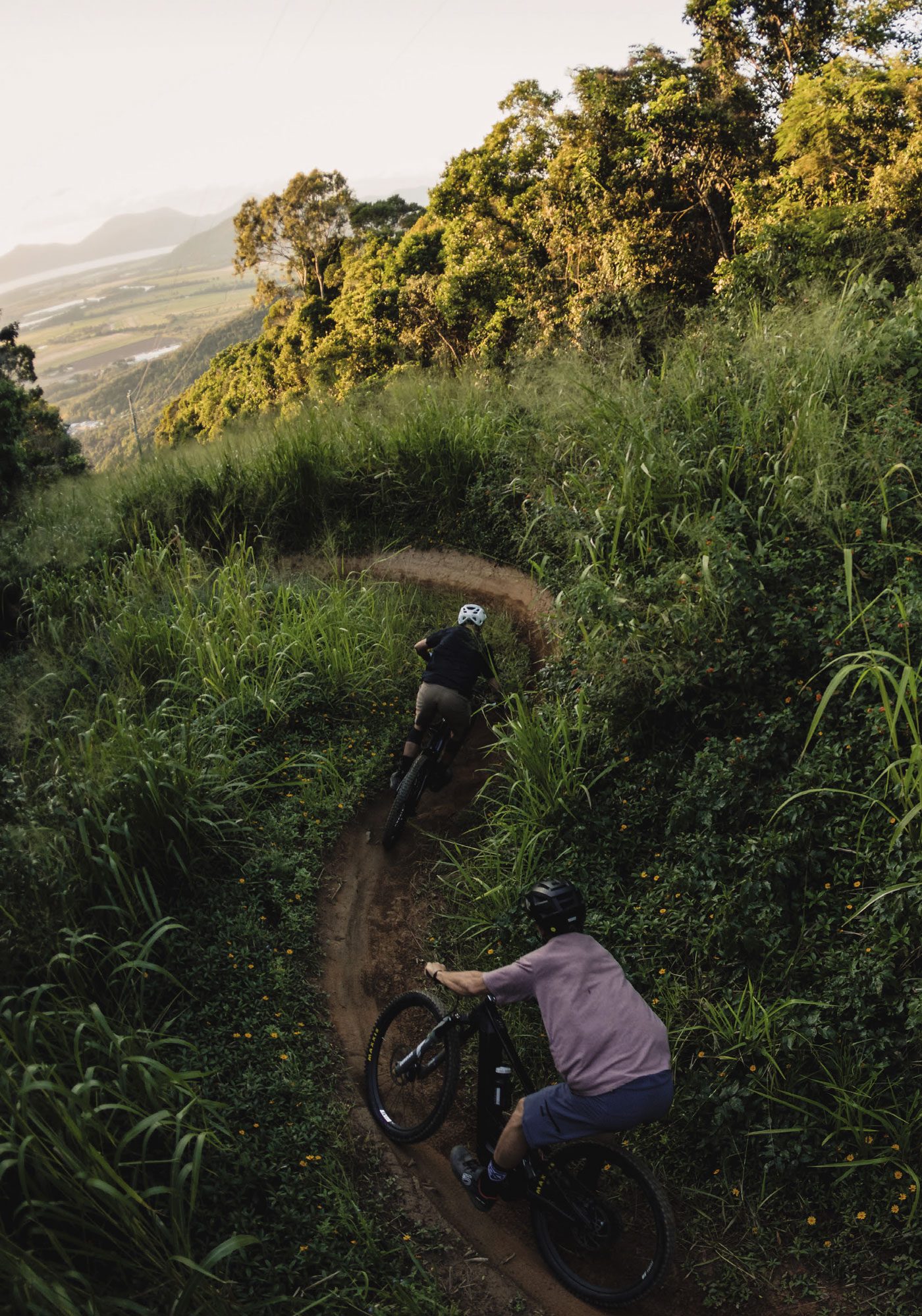
It’s also easy to use your time in Cairns to unwind. For every hill you climb, the descent nearly always drops you straight back at the beach so you can ride to coffee – or a beer. Although we were there for work, stealing moments in the early mornings – or in the very limited windows after events had finished for the day – and fitting it all in around Blenki’s schedule for competing and resting, it still felt like we were on holiday.
Finishing up our last ride of the trip with a caffeine fix at Palm Cove’s infamous NuNu’s I, set underneath the palm trees, I asked Blenki what he thought about experiencing Cairns by eBike.
“It was a good way to see a lot of trails a lot quicker than you could do on a normal bike, without all the pushing around or climbing, and spending a lot more time getting up and down,” he said. “I felt like we did a lot of stuff in only a few hours and that’s the good part about it, you can get so much more ground in less time.”
And when it comes to exploring tropical paradise, that’s exactly what you want, right?
With that said, it was time for us to farewell the Tropical North and catch a plane back to Aotearoa.
Until next time…
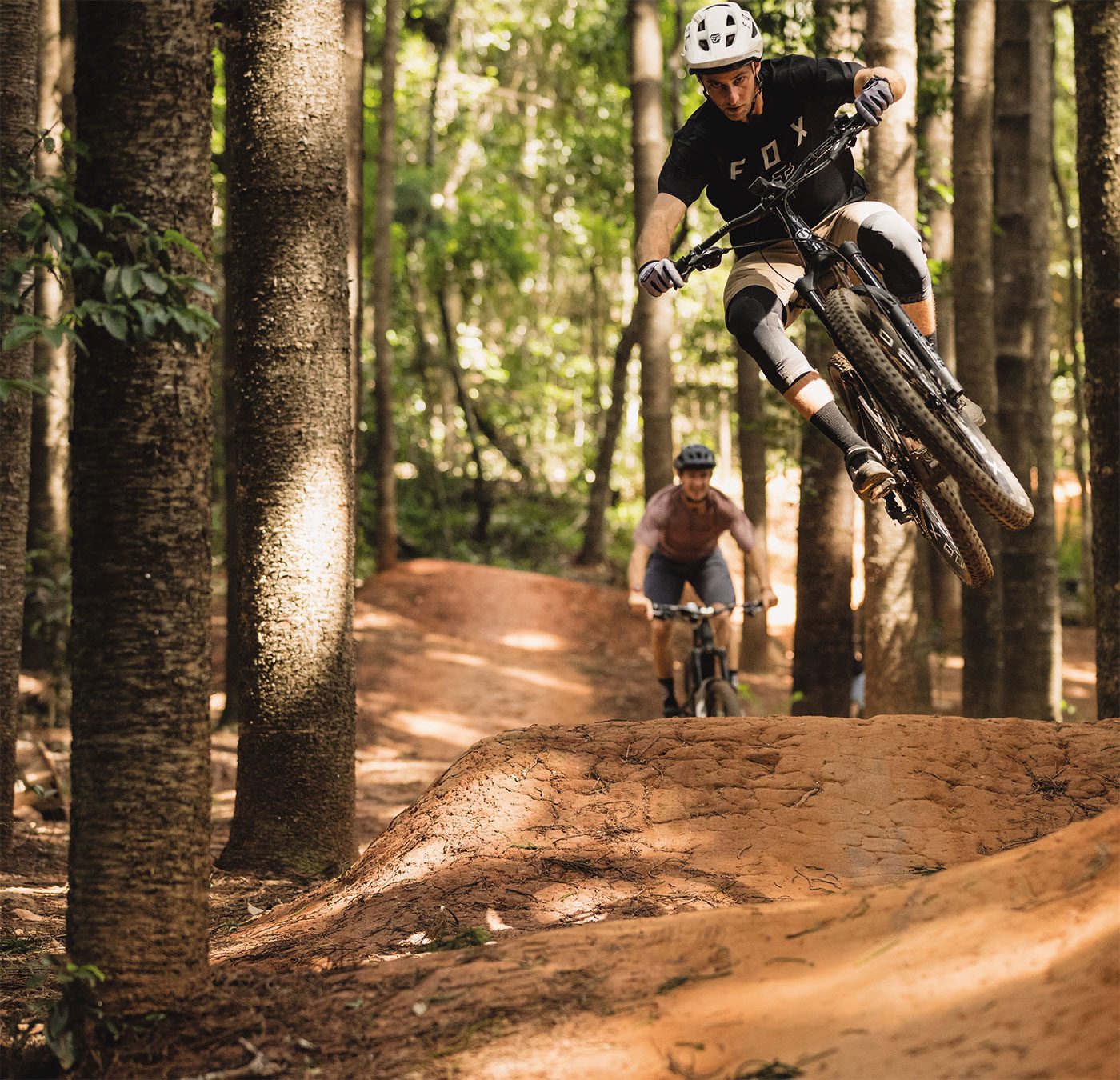

Keep on pushing: The Volcanic Epic 2023
Words: Lester Perry
Photography: Chris Chase
The Volcanic Epic is NZ’s newest and longest multi-day cross-country MTB event. After a storied journey to the start, the inaugural edition kicked off on 23 March 2023. Riders competed as individuals or two-person teams, across either two or four-day options.
Every rider came to the Volcanic Epic start line with their own story. For some, it was overcoming cancer or mental health struggles just to be there on the line, the event being the culmination of hard work and persistence, putting a cap on their recovery and proving they could overcome seemingly insurmountable challenges just to be there. For others, it was an opportunity to get away from ‘normal’ life and simply ‘Ride, Relax and Repeat’ (the tagline of the event), a twisted holiday of sorts.
It wasn’t just the competitors who’d climbed metaphorical mountains to be there – the event organisers, Nduro Events, headed by Tim and Belinda Farmer, had to tackle equally as large challenges just to make the event happen.
Winding the clock back to 2019, Tim was headed to the Port-to-Port stage race in Australia. Training in the bank, he was eager for the experience. Early in the first stage, a rider wiped out Tim’s front wheel, taking him down and in the process smashing up his shoulder. Whilst laid up in the hospital, a seed was planted.
“Why can’t we have more stage racing like this back home in the North Island?” Tim pondered. The Pioneer (at the time NZ’s only MTB stage race) was touted to be heading north from its home in the south, so Tim parked the idea of creating one himself.
Covid-19 took a scythe to events – literally overnight it completely shredded almost every event promoter’s plans. The owners of the Pioneer didn’t just postpone their event, but completely shelved it, opening the door for Tim and his crew to create their own stage race.
“There were people who wanted to do stage racing and couldn’t because Pioneer was gone,” explains Tim. “We wanted to fill that gap.”
The ‘Epic’ name came about whilst scouting for event venues. Every site visit culminated with the narrative, “this is going to be epic”. The phrase stuck and, when combined with the volcanic nature of the areas the stages would visit, the ‘Volcanic Epic’ name was coined.
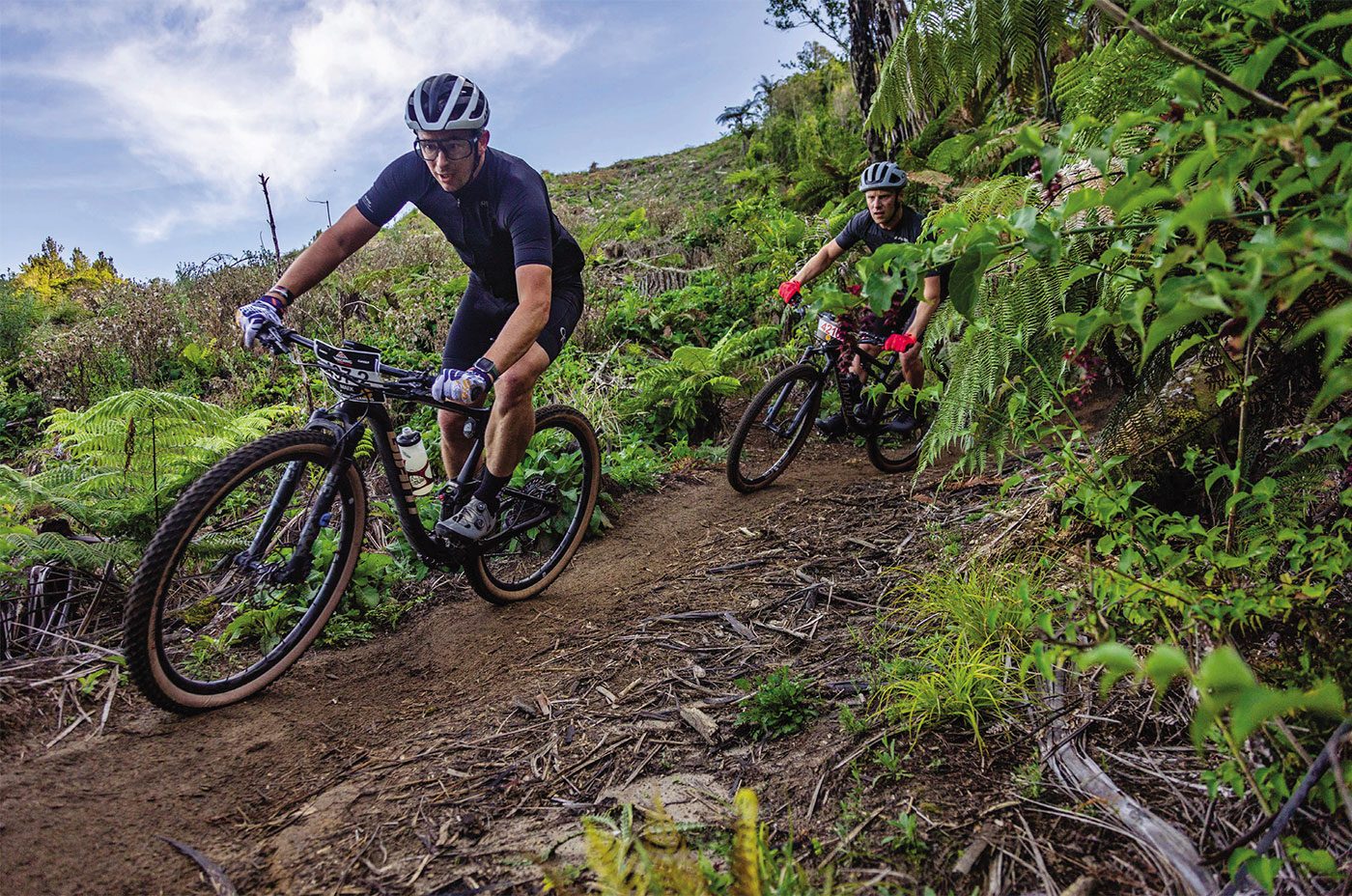
Covid’s grasp on the community loosened in late 2021, and events slowly returned to the calendar (albeit under hefty restrictions). Spirits were high heading towards a rescheduled late January 2022 date for Nduro’s premier sin- gle-day event, the Whaka 100. Unfortunately, numerous pandemic-related issues brought a last-minute cancellation, leaving the upcoming Volcanic Epic as the organisation’s final – and only – event for the summer. Again, Covid drew its sword. A fresh spike in COVID numbers, and a change in government regulations, meant they wouldn’t be able to deliver the event anywhere near the level they needed to, and the difficult decision was made to push the event out to the following year.
Reflecting on the postponement, Tim explains: “We were passengers in the whole process, but we were committed. When you enter, forty percent of your entry fees are instantly committed to an event, so there was no option to pull out.” Belinda adds, “We were still 100% committed to running the event after we got through the Covid period, to do it for the participants.”
With the commitment to go forward, new staff were hired, and a full crew was assembled. “There are six full-time staff in the team now, and we had 28 to deliver the event. We originally had 31, but we had people get Covid just before the event started, and family bereavements and emergencies and all sorts of stuff. Volcanic Epic had 28 paid staff on it, with six full-time in the end.”
The 2023 date was locked in and the entire Nduro Events team set to work preparing to finally deliver their first Volcanic Epic.
Everything was rolling towards the event as planned, and it looked like the major hurdles had been overcome and wrinkles ironed out. The weather gods didn’t want it to be that easy though, and a month out from Stage 1, Cyclone Gabrielle flexed its destructive muscle, felling a huge block of pines and closing the trails in the Craters MTB Park (Taupo), where Stage 3 was to take place. Yet another hurdle the team would have to overcome to deliver their event.
Fast forward a month and over 500 hardy souls lined up at Te Puia, in Rotorua, ready to kick off the first of four stages. It wasn’t just locals boarding the Volcanic Epic train though – post Covid, international riders were once again lining up for NZ events.
“They came from Seattle, Mexico, Canada. We had people from England, Scotland, New Caledonia, Australia. A guy from France. We’d almost forgotten about our international community since borders had been closed, but it’s fantastic to see their return,” says Tim.
The opening day was set in the hallowed lands of the Whakarewarewa trails, covering many fan favourites and setting the tone for the days to come. After a briefing and welcome, newly crowned National XC Champ, Matt Wilson, alongside a host of Australasia’s top endurance racers, accepted a Wero (Maori challenge) and it was game on. Riders headed out past the Pōhutu geyser to do battle on the trails.
“Especially in Rotorua, the cultural narrative should always be part of mountain biking. It’s not a public forest – we’re actually riding on private land that belongs to a collective of central North Island Iwi. It’s important we honour that.”
Although the event was in play, the logistical challenges continued to come. Arriving in Tokoroa after Rotorua’s opening stage, the event team dis- covered all the course markings for the following morning’s race had not only been tampered with, but the steel waratahs used to secure course arrows and marking tape had been stolen, effectively destroying their entire course. Once again, the Nduro team swung into action. Taking advice from local police, and with help from the Tokoroa MTB Club, a revised course was quickly put in place, ready for action the following morning.
“And so that’s one of the cool things with the event… we can expose a whole new group of riders to the hard work the trail organisations do. I think the benefit of this event, for Tokoroa, is we’re just going to get more bikes on their dirt, which will be better for their trails and the area in general.
“I think the biggest thing for the riders, and the biggest bit of feedback, is that Tokoroa is a revelation – they didn’t even know it existed!”
After Gabrielle had turned day three on its head, Tim’s team swung into action once again and, in a tight time frame, pivoted to a ‘Plan B’ option. The rejigged day would now see riders take on a section of Taupo’s Great Lake Trail, including two laps of the Otaketake, Orakau and K2K loop, beginning and ending in Kinloch, right on the stony shores of Lake Taupo. Post-ride swims, and ice creams from the dairy across the road, topped off a stunner of a day. Riders were pleasantly surprised that Nduro’s ‘Plan B’ ended up being an ‘A’ choice!
The fourth and final day saw riders return to the pumice-based soils of Rotorua. Rising steam and a crisp, clear morning greeted riders at the entrance to the Whakarewarewa Living Maori Village, where they assembled for their final departure. A local cultural group kicked things off, performing for the entire field as they left the start line.
“That was a farewell from their lands, and sort of a departure and cultural performance in one. That’s part of the whole experience. It’s really hard for them to go on for 40 minutes, so they did well to try and get most of the riders through a cultural experience as they embarked on their final stage.”
The Volcanic Epic uncovered new ground for many participants; be it simply getting to ride new areas, ticking off a bucket list item, or riding with a mate each day. Four days, four stages, and a lifetime of memories not only for the riders but the event team too.

The engine inside: Redefining the impact of bicycles
WORDS: DAISY MADDINSON
PHOTOGRAPHY: DAVE MACKISON
Narrated by the legendary voice of cycling, Phill Liggett, The Engine Inside is a captivating feature-length documentary that weaves together the extraordinary stories of six everyday people. Through their experiences, the film unveils the remarkable power of the bicycle to promote profound change in our lives and communities. One of the documentary’s writers, Daisy Maddinson, shares how the film hopes to spark a feel-good revolution on two wheels.
Beyond the traditional portrayal of cycling as a sport or recreational activity, we don’t often give the bicycle much thought. Some might use it to get from A to B or commute to the office, but have you ever seriously considered the deeper impact of swinging a leg over?
The Engine Inside goes deeper, exploring the often-overlooked potential of this 200-year-old machine. Through the stories of six everyday people using the bicycle as a tool, the documentary delves into the significance of cycling in helping solve various global issues, including physical and mental well-being, socioeconomic inequality and climate change.
As writers, we wanted to go beyond the surface of cycling and showcase the true essence of the bicycle and its transformative power. In the development stage, every story we uncovered touched us deeply. We met people who faced daunting personal and systemic challenges head-on—from generational trauma and economic barriers to women’s equity and motor vehicle collisions—who have all found hope in the simple act of riding a bike. Their determination to overcome adversity through cycling left us humbled and even more inspired to use storytelling to spread the “bike gospel”.
By sharing the journeys of these everyday people from all walks of life, the film challenges anyone who watches it to reevaluate their own perspective on the transformative power of the bicycle.
The world can feel big and ugly sometimes. With so many converging social and environmental problems, the weight of the world can be overwhelming. We think, how can we as individuals change anything? And what use is one small action when the problems are so large? After watching The Engine Inside, we wanted the audience to ask themselves: Can an act as ordinary as riding a bike truly unlock strength and resilience within us all?
The documentary urges us to see the bicycle as more than just a means of transportation or a way to enjoy the great outdoors. It shows us how riding can act as a catalyst for change. It shows us that small actions do make a difference.
Our hope is that The Engine Inside will prompt anyone who sees it to change their view of cycling and embrace the transformative power of the bicycle and the engine inside us all. We can build a better world, one pedal stroke at a time.
Film release coming late 2023.

Ride Camp: SRAM Eagle Transmission
Words and Photography: Jake Hood
Where do you even start with this? Is it by talking about the radically new and different transmission system SRAM has just come out with? Or should I start by saying just how much of an all-star crew we had for this trip? How about the epic riding Queenstown provided? Or should we just talk about how good the food was at Atlas? Well, I guess I’ll cover it all below.
I’m a bit of a super tech bike nerd. I love trolling through the Vital MTB forums, looking at all the new and interesting stuff people dig up and find out there on the World Wide Web. How they find what they do I will never know.
They even manage to find stuff that is meant to be hidden from the public, months before it’s due to be released. It must be a nightmare for brands trying to keep things hush-hush, but it helps builds mystery and a lust for the things we can’t have yet. One of the very things I saw on this forum was SRAM’s new AXS drive chains. They weren’t really hiding it from the public, though, as it was already on a few of the pro’s bikes in the latter half of the EWS and XC season last year. The derailleur, cassette and chain were different; instead of being mounted to a hanger, the derailleur is mounted directly to the frame. I saw it and thought to myself, ‘that’s really cool, I like what they’re doing there’, then sort of left it. I didn’t really think about it all that much after that. I was sure it was going to be as good as any other AXS derailleur when it came out. Boy, was I wrong.
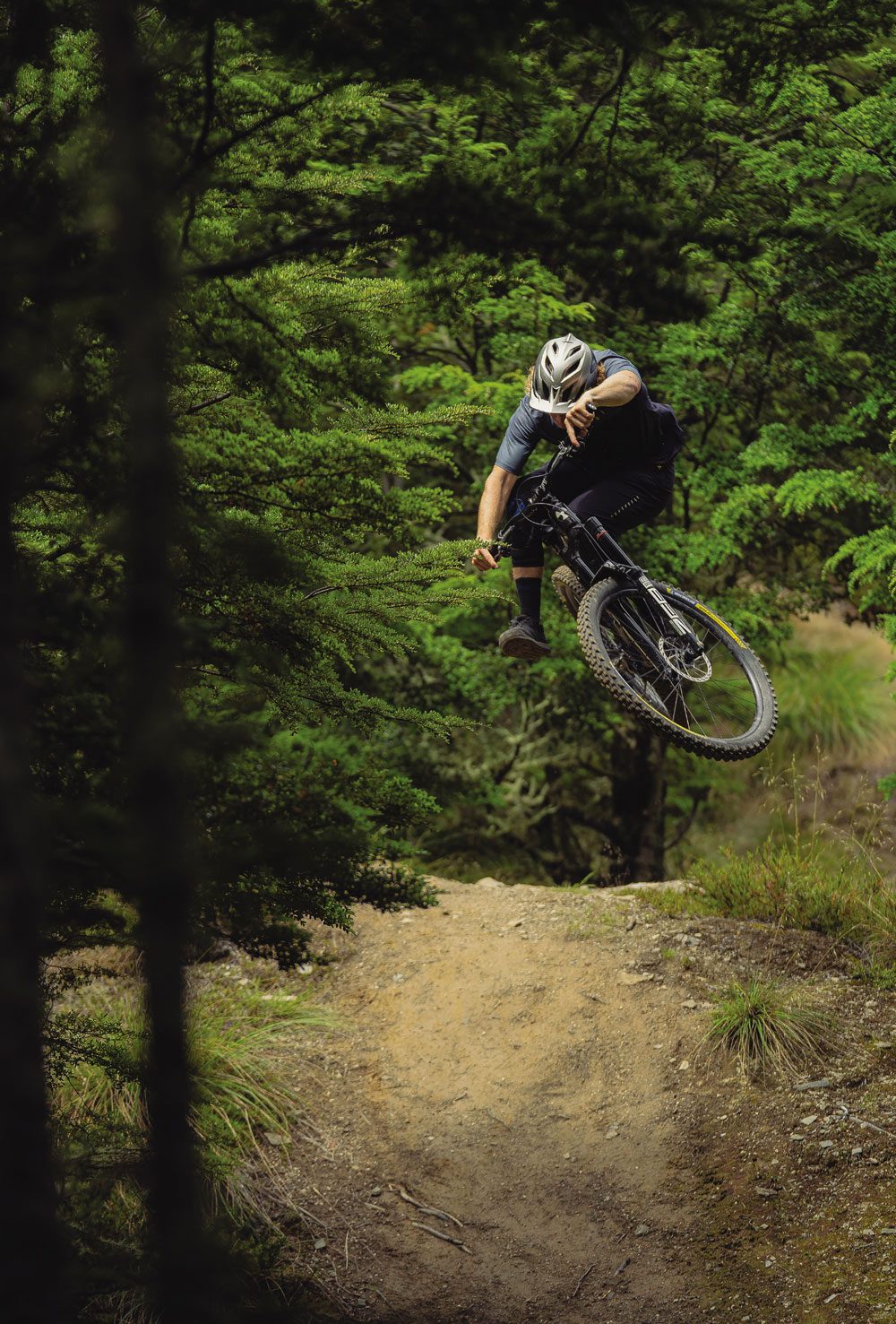
When Liam called about this trip, I was flipping stoked. Not just because we would get to ride the new product, but mostly because Chris Mandell from SRAM was coming over to talk us through the product and ride with us. I originally met Chris in Whistler, way back in the day when I lived there. I got to do a few laps of the bike park with him and boy oh boy, can he ride a bike well! I think I first read about Chris in Dirt magazine; it was a short piece about him, his BMX background and the Kona Entourage. Chris has done many things in the industry, he’s a man who’s worn many caps, including working at Kona, designing the original process line of bikes (technical Gen 2 processes) – that you could argue really started the longer, lower slacker trend – and working at Rock Shox as rear shock product manager. The latest Super Deluxe Air is his baby and that shock rips. And now he’s working for SRAM. I’d say I’m a little bit of a Chris Mandell superfan, so I was stoked to get to ride with him again and show him around Queenstown.
My original plan for the few days we had, was to start with a sunrise shoot at Ben Lomond saddle. It would have been a 4am grind up to the saddle to get the sun just poking over the Remarkables. For the five weeks prior, in Queenstown, we had really lucked out on the weather. There hadn’t been a drop of rain and no clouds to be seen, but the weather forecast was predicting rain for the days we wanted to ride and shoot. Typical. Liam and I caught up with Chris the night before the shoot/ride days started. We headed to Atlas for food, beer, planning and shooting the shit. Chris was stoked on the idea of a super-early-start sunrise mission, so we hummed and hawed about the idea. Rechecking all the weather apps suggested rain in the morning and not clearing until later in the day, so the 4am idea got sacked off. The new plan was for everyone to meet at a cafe in the morning and go from there – a bit more of a leisurely time.
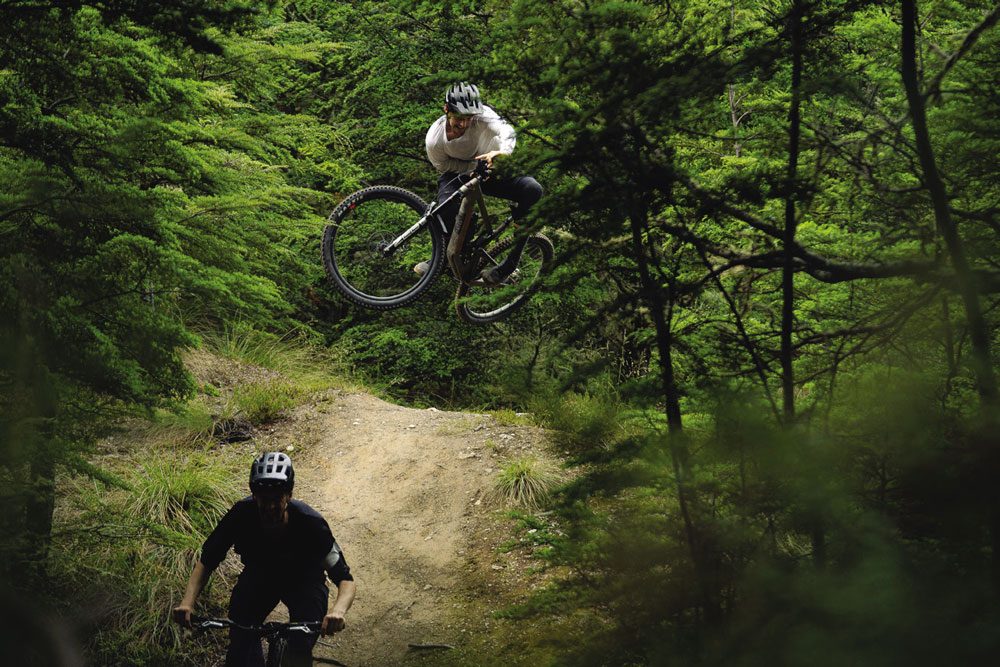
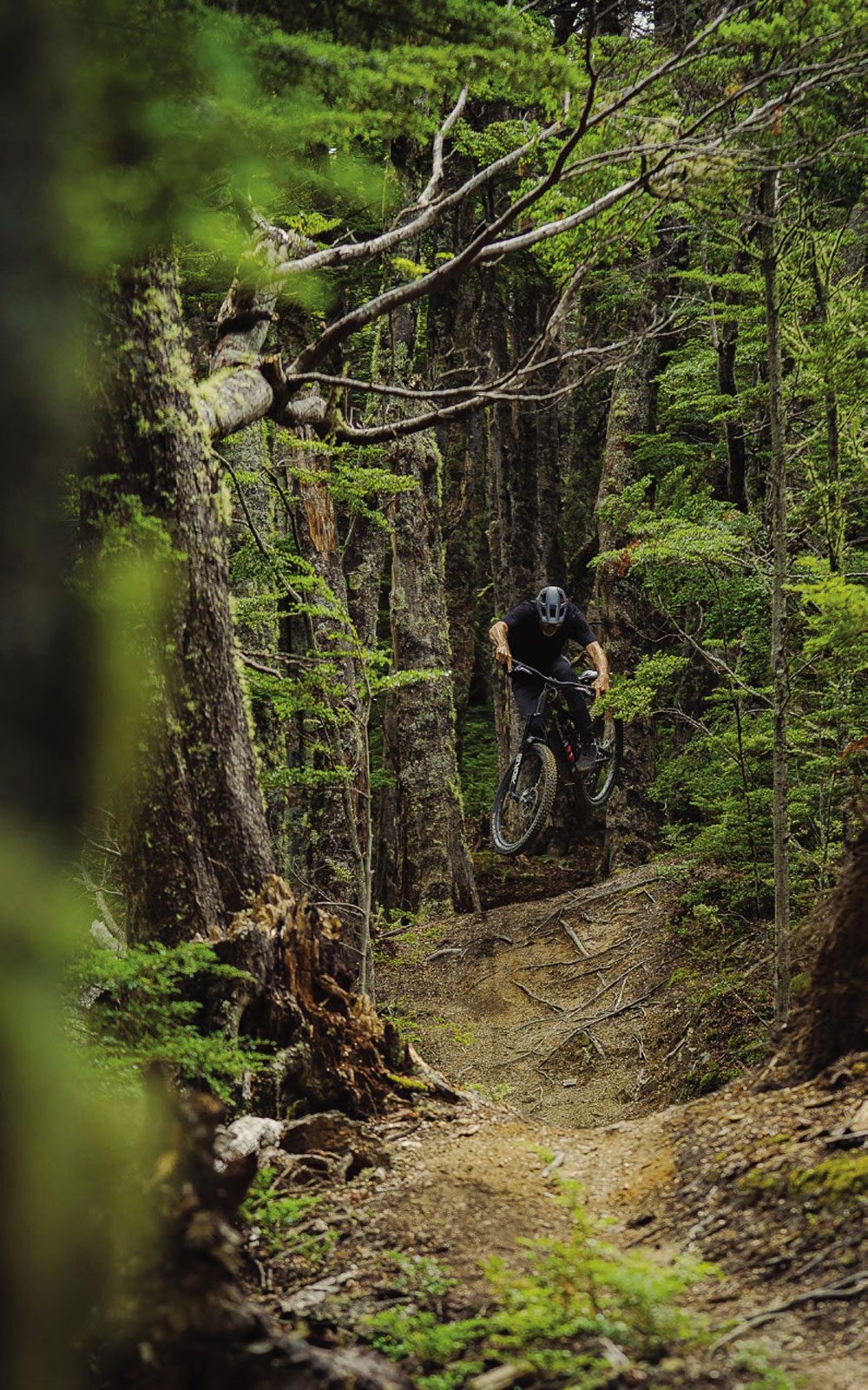
IN THE MORNING WE MET UP WITH THE REST OF THE CREW. A BUNCH OF HEAVY HITTERS. LOW-KEY SAVAGES ON 2 WHEELS, ALL AS HUMBLE AS THEY COME.
That morning, we met up with the rest of the crew: a bunch of heavy hitters; low-key savages on two wheels – and all as humble as they come.
Ben Hildred, the Vertical Metre Eater.
This lanky, tea-drinking Englishman has probably climbed more metres than anyone else in New Zealand, from Everesting and Double Everesting to being the first to complete the Olympus Mons Challenge, doing K2 and climbing one million feet in 200 days. He just loves riding his bike – and all things related to bikes. With a previous history in BMX, he brings that culture to his riding – playing about with the trail, jibing and getting creative – even on the uphills. He treats his 29er trail bike like a BMX, using his long limbs to his advantage.
Dan Booker, the Mayor of Maydena.
A flat-pedal assassin that has more raw talent than many of the top pros. His bike skills and balance are incredible. Seriously, watch some of his manual videos. Silky smooth whilst being stupidly fast. I’d argue he will de-throne Sam Hill soon for the title of fastest flat-pedal rider. It wouldn’t surprise me if you see him nearing the top step in this year’s EWS season.
Last but not least, Andrew Clark.
Hailing from Scotland but now residing in New Zealand, Andrew is the most low-key, chilled-out chap and is as humble as they come. He’s one of the best bike riders that no one knows about! He oozes style, with an ability to contort his bike and body into positions that the laws of physics shouldn’t allow. Take Newton’s laws of motion and throw them out the window when Andrew rides. It’s mind-bending to watch. All while having a massive smile on his face. I wanted Chris to meet him and see what he can do, because it really is something special to watch.
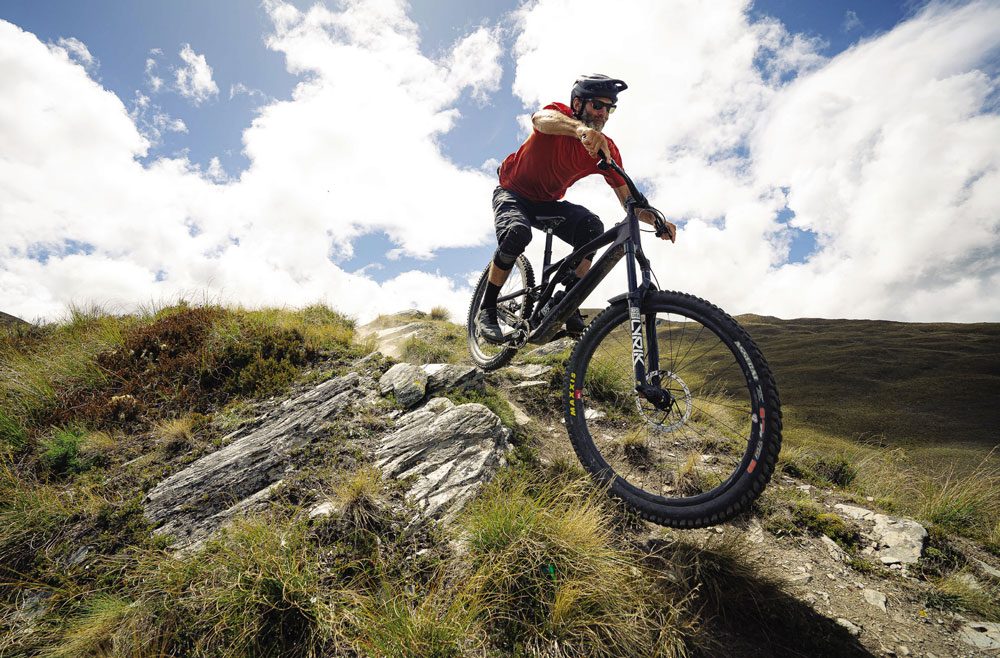
THE LEVERS NOW RUN PARALLEL WITH THE BARS. WHEN YOU SEE THEM YOU ARE LIKE “WHY HAVEN’T THEY DONE THIS BEFORE!” IT MAKES SO MUCH SENSE.
The rain was coming down as we inhaled our coffees the following morning. But, up the lake, you could see it starting to get brighter. We decided to make a move and go ride some bikes. We were heading to the beech forest anyway and like my mother used to say; “you’re not made of sugar”.
We parked at the bottom of the Skyline access road and, as we unloaded our bikes, I finally got to take a good look at the new stuff. It was quite the radical departure from your traditional mech. Mounted directly to the frame via a big clevis mount, the derailleur looked slick and futuristic. It had almost taken some of the cyberpunk aesthetic and feel that Hyundai is using in their cars with sharp lines throughout, highlighted by the brushed alloy metal on the black derailleur. It’s a solid unit of a mech – it looks like you could take this thing through the gates of hell, and it would come out unscathed. The new cassette was a work of art as well. As you look closer you realise SRAM have added X Sync to the cassette. Like, mind-blowing stuff. The new shifter – or pods as SRAM refer to them – have a more traditional, ergonomic design to them compared to the previous generation. It uses a two-button system, one placed above the other, with rubber paddles that require a push to make them feel like a shift versus a tap. The return spring built into the paddle gives you that positive, almost mechanical, feel. To me though, the pièce de résistance was the new XO cranks. They are gorgeous. A change from carbon to alloy, they are unlike anything else on the market (well, minus 5 Dev). They’re minimalist, cyberpunky and abstract. You can tell they used what they learned about their AI crank program and applied it to this. There’s a hole near the crank bolt, highlighted by the brushed metal accent that gives the look of a drawing compass. The bushed metal part has been placed in the part of the crank where you’re most likely to get foot rub, thus keeping the crank looking brand new for years for us chronic shoe crank pedal rubbers. The final piece that sets these apart, is the return of the bash guard. Why these ever fell out of fashion I don’t know, but I’m so glad to see them back. They mount on the chainring and can be removed if you see fit. I’m such a fan of these.
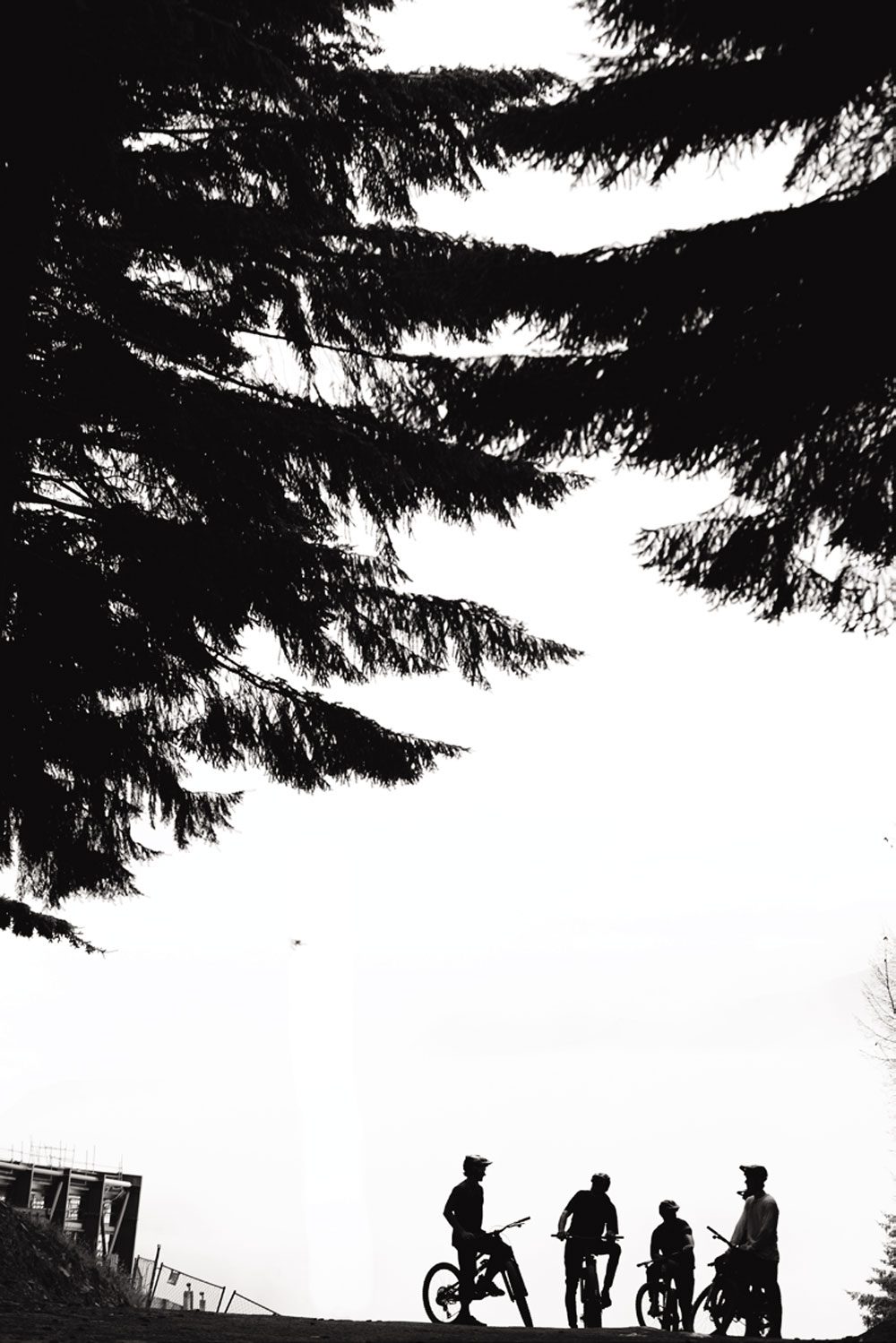
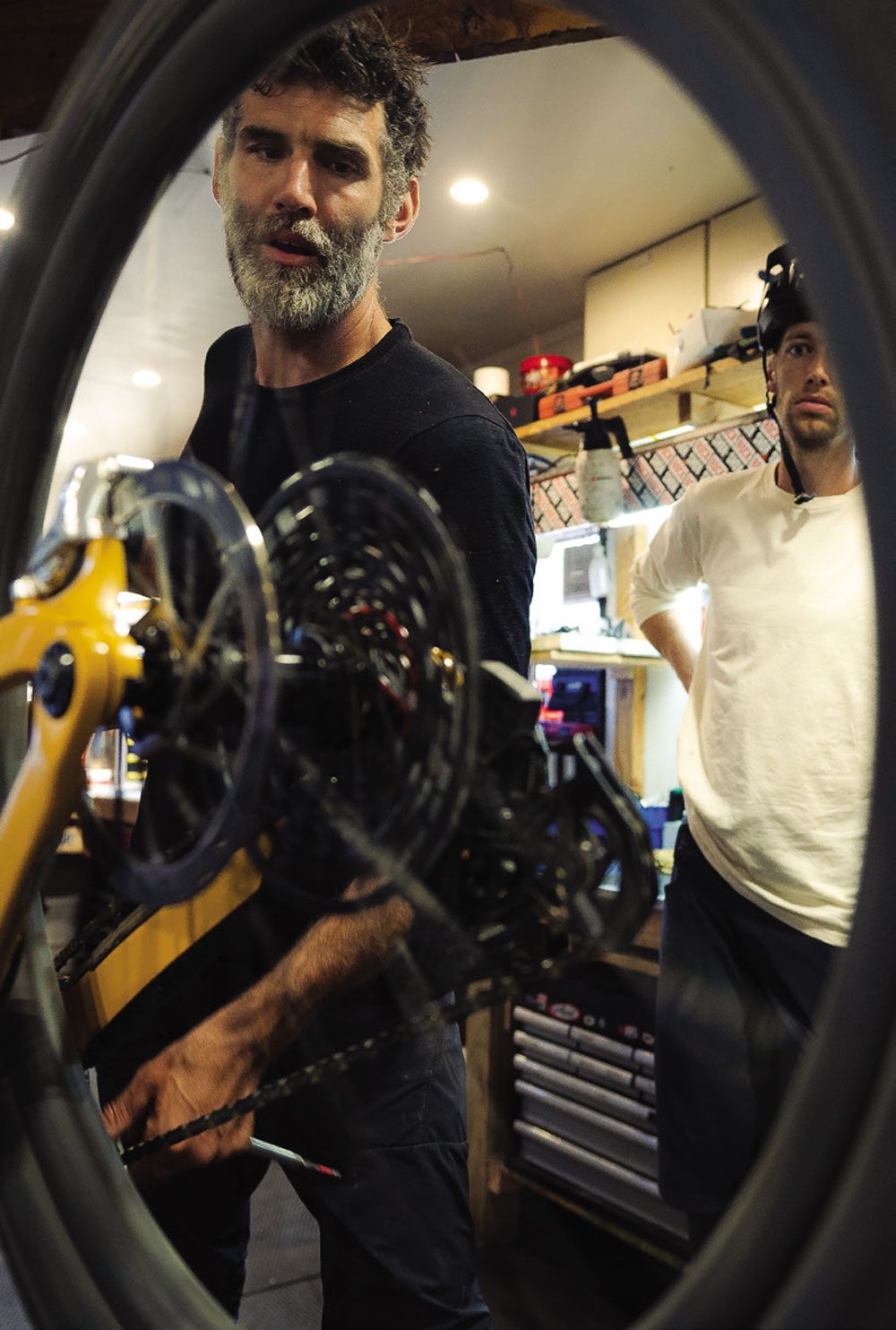
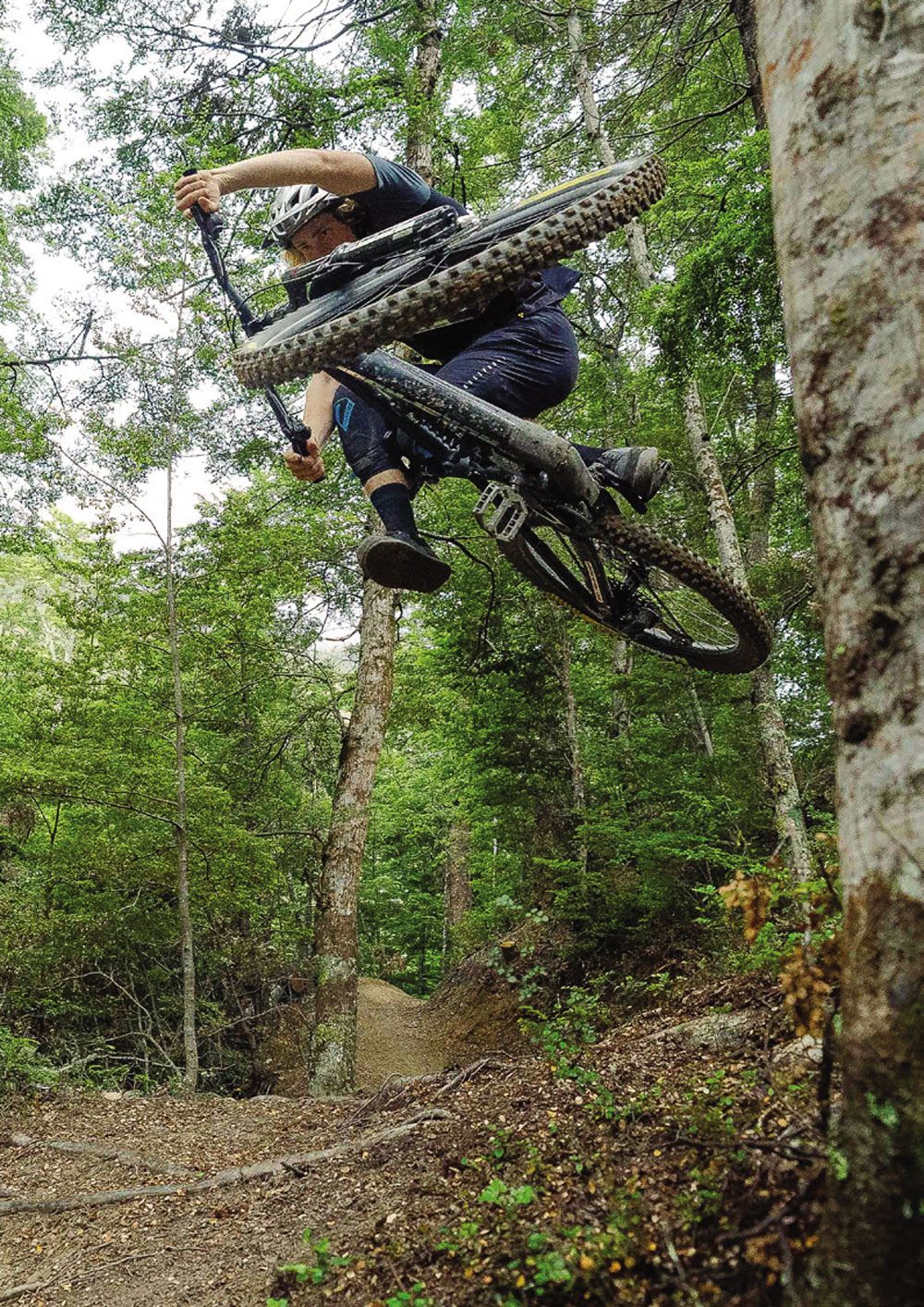
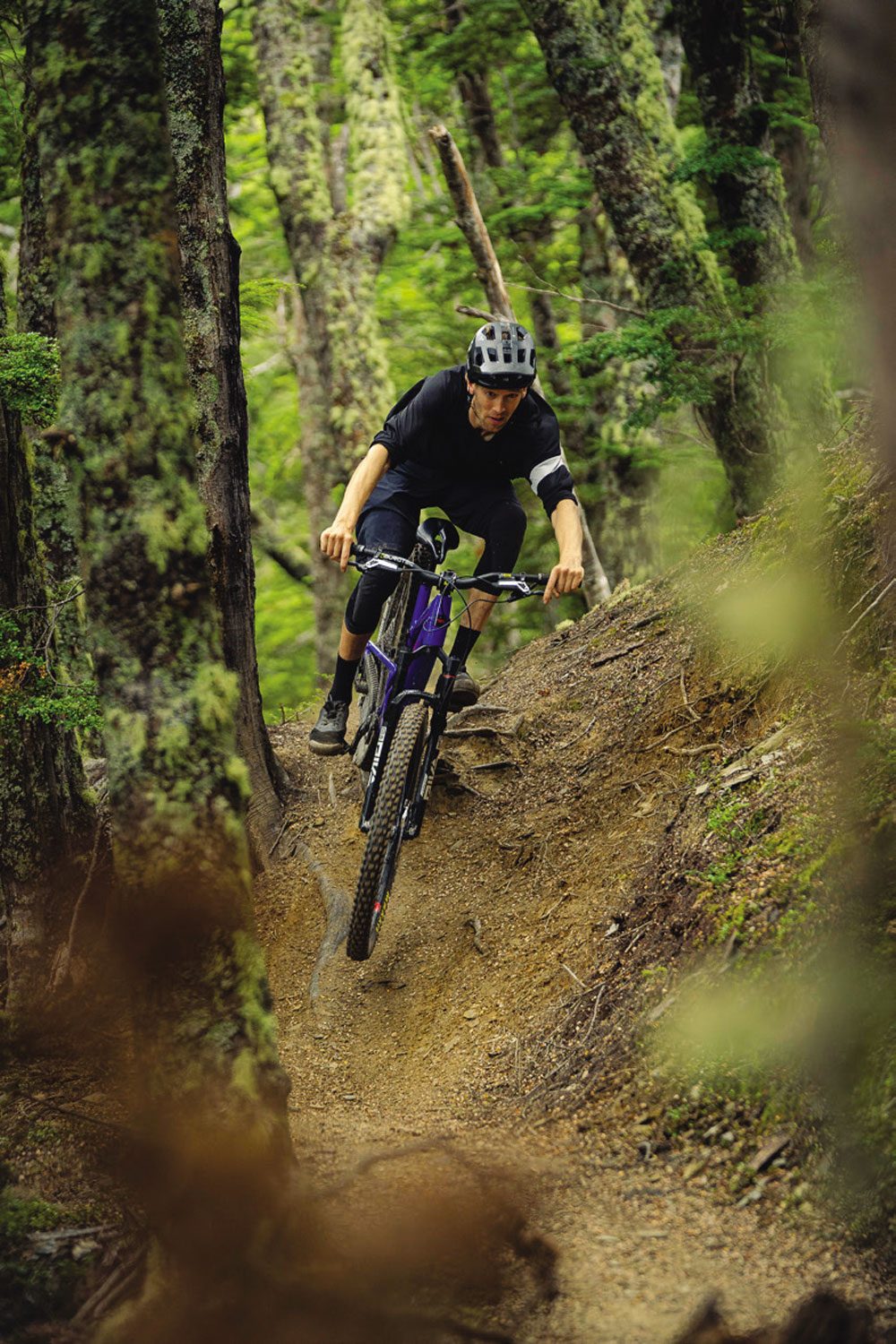
I was so distracted by the transmission that I didn’t even notice the new code brakes. The silver and black theme continued here. The polished calipers are a thing of beauty; these have stayed the same as the current codes, but where the changes have been made is in the lever. The levers now run parallel with the bars. When you see them, you’re like; “why haven’t they done this before?!”. It just makes so much sense. No more sticking out at 45-degrees, and the cables run much nicer. I feel like the 45-degree brake is just a hangover from V brake levers and no one ever thought, ‘hey, we could just make them run parallel with the bar, keep it nice and tidy’. From the first couple of pulls on the levers, you can tell there’s been some reworking for the internals. Lighter to pull than the previous code RSC. What I did think was weird, was that the new caliper – that had been seen on some of the World Cup racer’s bikes this last season – wasn’t there. Maybe SRAM is holding it back for another brake. I guess time will tell.
Chris explained that there are three tiers of these new AXS groupsets: X01, XX1 and XX1 SL.
We all jumped on our bikes and set off up Skyline access road in search of trails in the beech forest just outside the bike park. It’s a steep grind of a road – anyone who has ridden it will know. Starting at its steepest for the first third, before mellowing off a bit. The clouds were spitting a light amount of rain which was a refreshing change from the previous weeks of blaring sun and no shade – you didn’t feel like you were about to melt into a puddle by the fourth steep switchback. The steep fire road was the perfect place to test the gears under load. The gradient means you have to put a lot of force through the transmission and, being a road, it let you concentrate on what the gears were doing when you shifted. I guess I was in the perfect place to shift like an idiot under load and test these new gears. From the first shift, you realise this is something special – it’s not just another groupset, another new drive chain, it’s more than that. It’s the crispest shifting I’ve ever experienced. It has such a positive feel to it. There is that reassuring ‘clunk’ as it moves into gear, almost mechanical but with the precision of electronics. Lightning fast; instant, precise. Even under load in the worst possible moment to shift, it was still absolutely light years ahead of everything else. Whatever you have learned about not shifting under load, you can now throw out the window. This new system does it with ease. I think a big factor is the added stiffness of the direct mount, and the X Sync teeth on the cassette, but SRAM have also made many tiny tweaks that have really optimised the system. We’ll discuss them later.
The pace was hot, with Ben leading the charge. I guess that’s what happens when you are riding with a bunch of absolute savages. The relentless access road mellowed slightly towards mid-way and gave me time to get my breath under control. We stopped at the mid-way point and Chris told us some stories about the adventures he’d been on. After a quick break, we set off again up the second part of the road. I’ve ridden this road so many times over the years and it never gets any easier. If you get fitter, you just end up going faster. It’s surprisingly addictive to pedal up the road – even though it shouldn’t be. As the trees start to thin out, you reach the Skyline top gondola. We continued heading up via Beeched As, then Ben Lomond walking track to Lower Missing Link – a favourite trail of mine. It’s a perfect balance of flowy beech forest mixed with a little bit of tech. It’s a fantastic trail that works for all abilities, and it was running great after recent maintenance work by the crew at Elevate Trails.
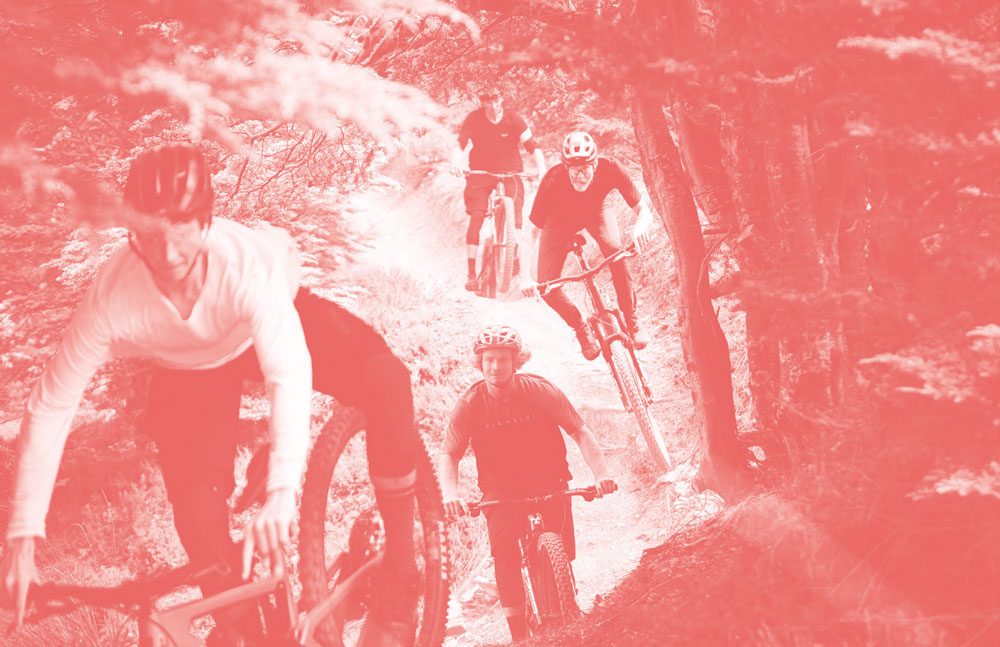
The trail starts off out in the open and winds its way down into the beech forest – this is where it really gets good. We stopped and sessioned bits on the trail while I shot photos. The first feature we stopped on was a bomb hole compression to a small jump. From the get-go, Andrew was blowing minds. He had literally just jumped on the SRAM-equipped Megatower that morning, without any time to get used to it, and rough settings. He came over the rise into the bomb hole, doing an inverted nose press over it, all tucked up in ways that shouldn’t be possible. Smooth as you like. Chris’s face lit up – “what the heck?!” From that point on, I knew we were in for a good day.
We worked our way down the trail, sessioning different parts. Everyone fed off the energy of each other. Dan would be throwing some huge shapes off the smallest mounds while also travelling at a ridiculous speed through the turns. You could feel the earth trembling as he passed. Andrew was doing Andrew things; bending the laws of physics and gapping into switchback turns that shouldn’t be gapped into. Both Dan and Andrew’s styles complement each other, making it so good to watch. Chris was the hype man of the day, throwing out hype and stoke every time something cool happened, genuinely so excited by what was going on. Throwing out ideas. It was infectious. Everyone was just going harder and harder. Chris and Ben were bringing their BMX background to the trail. Throwing down tweaks that are better than a lot of the pros, dancing their bikes down the trail in such a beautiful manner. Smooth and light, their long limbs smoothing out the compressions, they’re two great people to watch flow down a trail. Such a joy to watch. Fantastic.
After Missing Link we headed down Creaky Winders and shot some more photos. This is another absolute gem of a trail. It snakes off of Beeched As and is a perfect mix of tech and flow. It’s niggly and tight in some spots; weaving up and down. It keeps you on your feet with lots of little features, surrounded by beautiful beech forest. It’s tremendous. Everyone was just peaking on this trail; fizzing and pushing each other, over and over. We worked our way down the trail, checking off features as we went. Near the end of the trail, I could tell people were getting tired. Mistakes were happening. I called it a day on the shoot. It was time to head to town and refuel.
We followed the Fernhill Loop back to the bike park and down Squid Run in a train. The crew might have been tired but that wasn’t slowing anyone down. We weaved our way down trying to hold the wheel of Dan. It was another good test of the transmission, which was a lot quieter than my current GX AXS – less chain slap. The shift was more positive even on the way down. Some will say, “ah yeah, that’s just because it’s brand new!”. But the set I was riding wasn’t – it had been used for a few weeks, making how well it worked even more impressive. It was an absolute blast training down Squid Run at the pace we were going. Borderline dangerous with everyone feeling so tired. At the bottom, we all had huge grins on our faces.
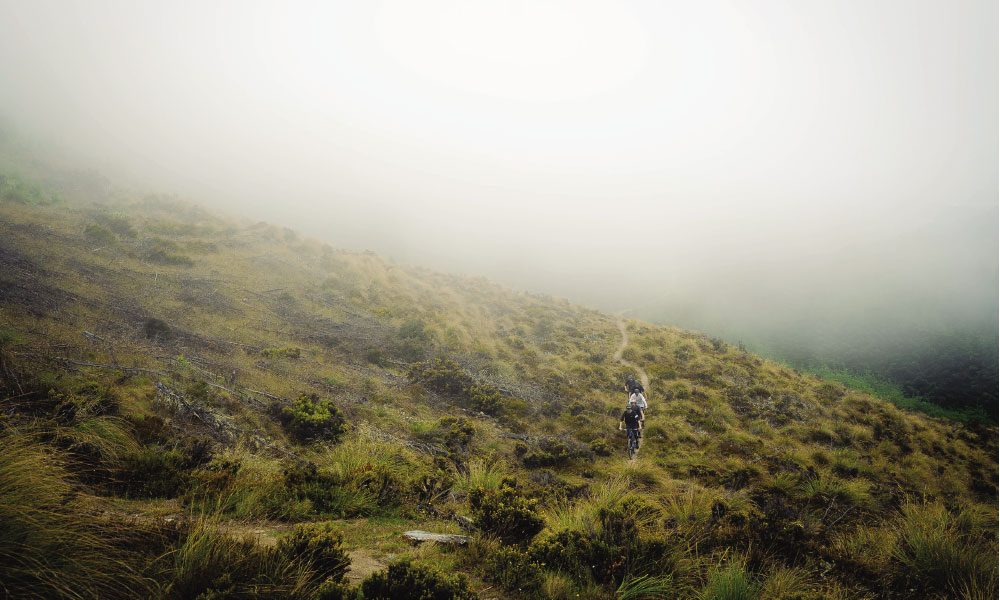
THE MORE I RODE THE PRODUCT THE MORE I LIKED USING IT. IT’S AN ABSOLUTE JOY TO USE.
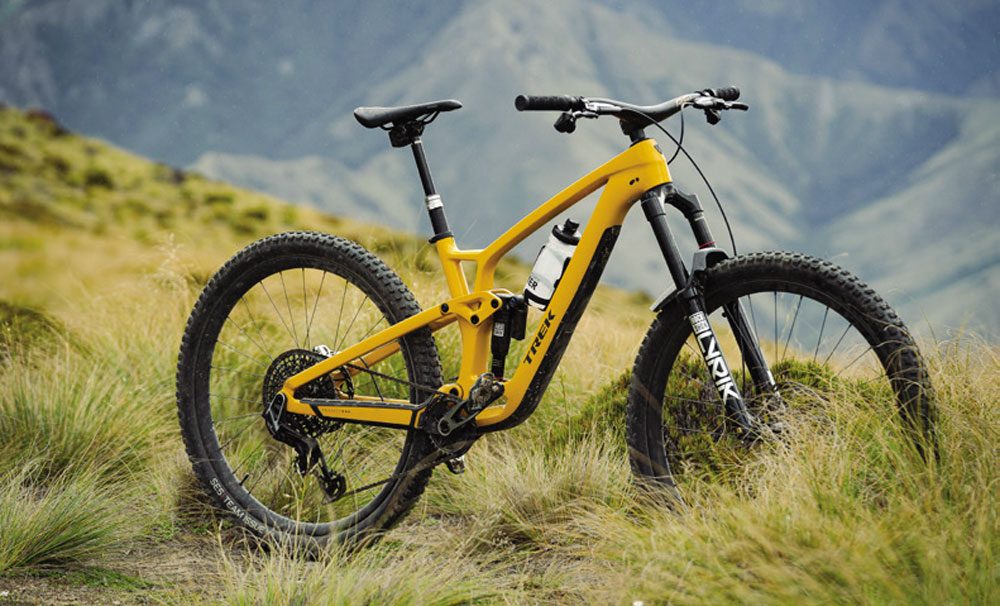
All good rides finish with a beer, right?
We rolled back down to the local watering hole to refuel – there was only one place to go, and Atlas was that place. I’ve said it once and I’ll say it again: it’s the perfect after-ride spot, with great atmosphere, lovely staff, killer food and 22 taps of fantastic beverages to choose from. We fueled up on beer and burgers whilst chatting bikes and trails. Before the inevitable food coma set in, we headed out quickly for a little more time on the products. A few chilled laps in the Fernhill/ McGnarly area, with one lap down Skyripper and a McGnarly to finish the day’s riding. The more I rode the product, the more I liked using it. You just know that when you pull the button to shift, it will do it; there’s no need to worry about a little under-power half pedal to help it shift – just pedal as you would, and the chain will shift on the cog. It really does improve the enjoyment of climbing. The slightly altered rations in the cassette were also a welcome improvement. No more big jumps between the 42t to 52t; instead you 44-52 jump, which feels a lot nicer. It doesn’t sound like a lot, but it makes a difference – there’s less of a sudden change in ratio. It’s hard to put in words the feeling of the new transmission over the previous stuff, it’s just an overall feeling of a much nicer time while shifting. A good analogy would be to compare driving a car from 10 years ago to driving a brand new, modern car with all the bells and whistles. Both do the same thing, but the newer car is easier to drive, more relaxing, quieter, with more features to assist you. Overall it’s just a more enjoyable experience.
Both laps of the Fernhill area were a blast. The party train down McGnarly was ridiculous. Bikes were dancing left and right over the jumps. Berms were being blown up by Andrew, Dan, Ben and Chris. Dust explosions everywhere. It was flipping awesome. Too much fun. Then things started falling apart on Skyripper. The long day had taken its toll, everyone was tired and mistakes started happening. I set off first, only to hear carnage behind me. Dan had blown off take on the steepest part. I think Andrew also had a wee washout. Everyone’s concentration had gone. It was time to call it a day on the riding.
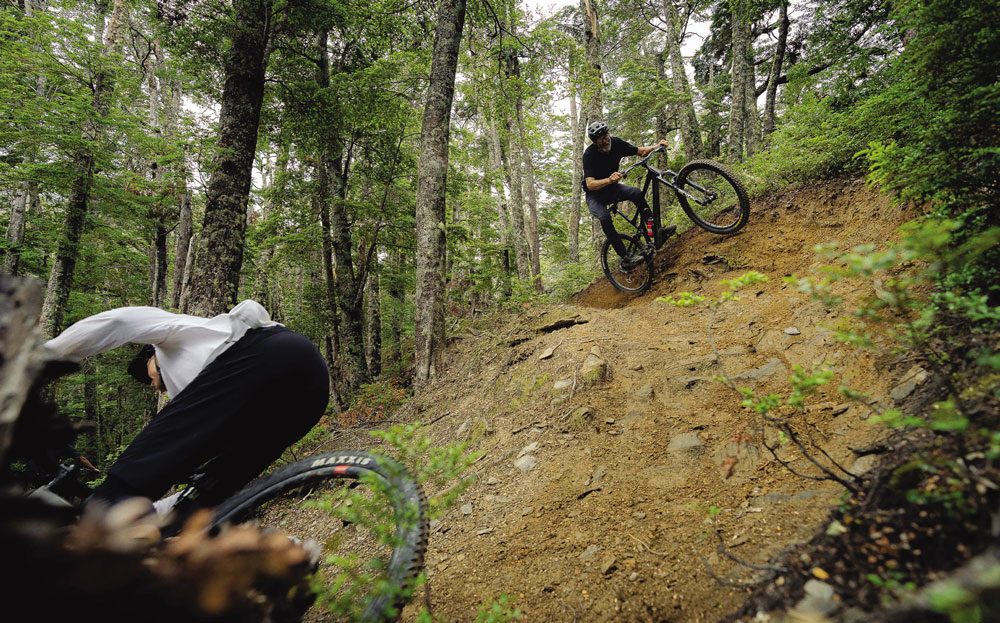
“THAT’S ALL VERY WELL A GOOD BUT WHAT HAPPENS IF I CRASH AND ABSOLUTELY SMASH IT INTO A ROCK OR SOMETHING AND MANAGE TO BEND IT?”. WELL YES. SHIT DOES HAPPEN.
We rode back to town and into Vertigo Bikes for Chris to give us the full tech run down on the product and how it works. The new system is designed to work on bikes that use a SRAM UDH hanger interface. A couple of years ago, SRAM brought out the UDH (universe derailleur hanger). The purpose of that was to create a better derailleur hanger that bike brands could adopt. It was a standard that made sense and, slowly, more and more bike brands have been getting on board with the standard. It was a solid move forward for the bike industry. This new AXS system builds on top of that: the hanger is replaced by a direct mount clevis system to the frame. In doing this, you massively increase the stiffness and strength of the derailleur. It’s not just held by a single bolt to the hanger, instead, it mounts both sides of the frame.
When you induce the hub, frame and axle, it creates an interface that is incredibly stiff and really strong, so much so that you can put your bike on the ground, stand on the derailleur on one foot and get back on your bike, ride away and the shifting will still be perfect. That’s not possible on a normal hanger set-up – something will bend. I had my doubts about it until Chris showed us. It was super impressive.
The derailleur keeps the override clutch system that allows the mech to move out of the way when it’s stuck by an object. It’s fantastic, and something that seems to get used regularly on my current GX AXS. It has saved my hanger from getting bent so many times and I’ve never needing to straighten it like I would have with a normal cable set up. The clevis mount combined with the override clutch ensures you have a system that should, in theory, be very hard to put out of tune. It’s just a more reliable system; more pierce gear shifting, and a better experience on the trail.
SRAM has introduced other technology to these groupsets: flat-top chains that come from their road bike groupset. These increase efficiency and durability while looking flipping awesome. X Sync can now be seen on the cassette, improving the shifting and chain reaction. It really lets you shift under load without the worry of skipping gears. I’d imagine it also helps the durability of the cassette. The recent SRAM x Dome cassettes have an incredible lifespan if you replace the chain regularly. I think these new ones will blow them out of the water as long as you keep up-to-date on replacing the chain when it’s worn.

The smart engineers at SRAM Germany really went to town on this. They have gone over everything with a fine-tooth comb. Chris said that they looked at all the warranty data collected over the past 10 years, and tried to eliminate as many of the issues as they could.
The way they did was by redesigning the whole system and imagining a new way of doing things. The clevis mount gave the ability to produce a far superior product and gave the engineers more ability to optimise every last bit. There are so many little things they have done that just make it a joy to use, such as the slight bend in the derailleur cage. It looks like it has been bent on the trail but, in actual fact, it’s meant to be like that. It helps keep the pulley chain interface better aligned when in the extreme ends of the cassette. There are two different modes to set the cage to, depending on the chainstay length. The new magic jockey wheel, that features on the XX1 and XX1sl models, ensures it will still spin even if an object gets stuck in there.
As well as all of this, set up has become easier than ever before. I’m not going to go into the whole way you go about it – the SRAM technical manuals have that all dialed and are a great source of information. “We gave this product out to some of our racers this year, on the EWS, and the mechanics keep overthinking the setting up of the system,” explains Chris. “It can’t be this easy, they keep telling me.” Easier set-up leads to fewer problems and fewer tuning errors from the get-go.
Now, I imagine that you’re thinking, ‘that’s all well and good, but what happens if I crash and absolutely smash it into a rock and manage to bend it?’. Well, shit does happen and, in that case, on a normal hanger mech situation, both of them would probably be a full write-off and due for the bin. In the case of this new system, however, I’d be very surprised if you could bend the clevis. It is really that strong and stiff. The good news is that the rest of the derailleurs are rebuildable. If you do damage a part, it will most likely be replaceable. You can remove the cage without using any tools. A simple little tap while unscrewing the cage will loosen it up. The tension spring and clutch are now built into the cage.
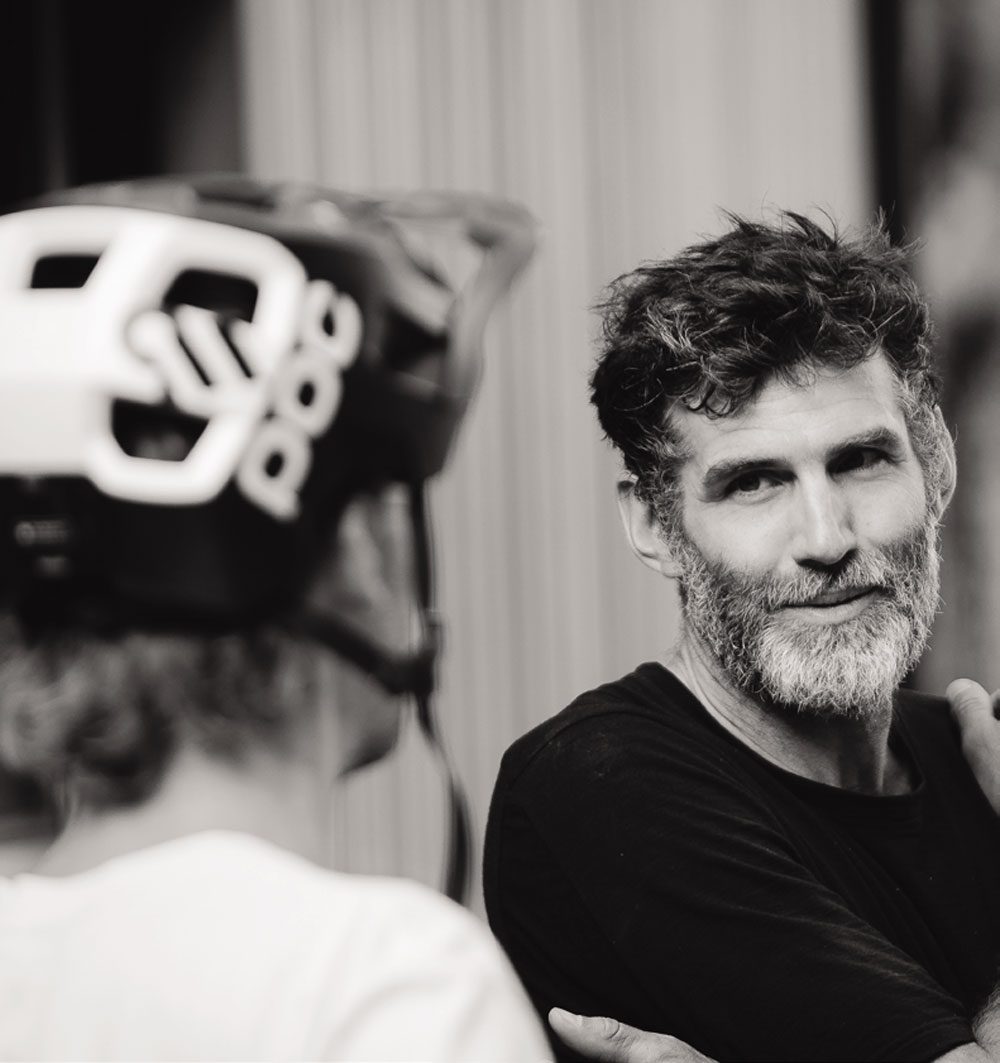
Servicing and cleaning these parts is super easy and something that can be done in no time at all. The protection covers on the B-knuckle and outer link ensures they are fully replaceable, or upgradeable to the XX skid plate. Is your mech looking a bit scratched up and tired after a year of use and abuse? Simply slap some new ones on and it will look brand new. I’m really behind this, I love it when brands make their products rebuildable and serviceable – products they want to see being used for years and years, products you can fix rather than just replace. It’s the way our industry should be heading instead of adding to a throwaway society just because one tiny part breaks or wears out that’s not replaceable.
The next day we were up and out, bright and early again. Straight back up Skyline access road then straight up the Ben Lomond walking track. Now, this is a walking track, but there must have been something in the crew coffee that morning because they pedaled up the whole thing. I’ll say it again: absolute savages this lot. It’s pretty relentless the whole way, just a hard going grind, but it rewards you with breathtaking views once you reach the Ben Lomond saddle. There was now 1000m of vertical descent ahead of us, back down to Queenstown. What a treat to be had. We hopped onto Upper Missing Link and stopped at the rock feature near the top. There, I had this idea for a photo I wanted to shoot. Everyone had a run-through, wall riding on the rock, and I got what I wanted. Chris pushed back up to hit it again. He came into the rock at a weird angle, going straight into it; next thing he extended his bike up over vertical and foot planted on the rock. Everyone was freaking out. It was so unreal! There had been a lot of BMX chat on the way up and I guess Chris was feeling inspired. I didn’t think a foot plant on that rock was possible. Next, Dan and Andrew started giving it a go. Popping up high before planting the foot, with the bike basically upside down. It was mind-bending. If they got the foot placement wrong, it would have been a good fall down the other side. Dan and Andrew just shut the rock down. Amazing stuff.
We continued down Upper Missing Link, weaving and dancing our way along the ridgeline, the narrow singletrack snaking through rocks and tussocks. From there, we headed down what you could argue is one of the best trails in New Zealand. I’m not going to tell you where it is or what it’s called – if you know, you know. It’s an absolute gem of a trail. A true mix of everything. Three trails in one – flowing, flat-out beech forest and dark turny pines to Val de Sol-like rock gardens. It’s got it all. As you hammer along the beech forest section, you’re treated to huge compression and little gaps. Flat out straights into tight turns. Cornflakes cover the track and hide the roots below. The new brakes really started to show their improvement over the old ones. The power seemed to have increased, the lighter lever feel was a welcome addition, easing the arm pump on this long run. The classic SRAM modulation was still there, offering heaps of control.
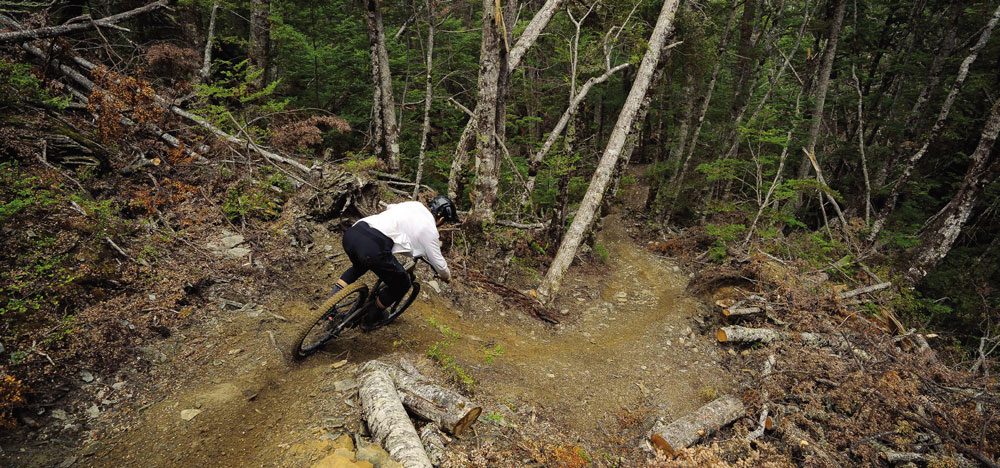
Once you finish the beech part of this trail, you hit the dark pine at what feels like warp speed. Your eyes don’t have long to adjust to the light conditions; turns come up fast, a couple of lefts and rights before coming into a rock roll feature. From there, you head through a small slither of Sycamores, lighting the place up in green haze. The dirt in this section is treacherous in the wet, almost like riding on ice. Finally, you end up with what I imagine a fresh, slightly tamer version of Val de Sol would feel like: deep loam and lots of rocks. I was barreling through this section and smoked the derailleur into something. The sound was horrendous. In my head, I was thinking, ‘ahh, well that’s fucked then’. I didn’t stop though, and continued on to the bottom of the trail. To my absolute amazement, it was fine. Although it sure looked like it had been hit – there were scratches, a big chunk of material missing and rock debris – the shifting was still absolutely perfect. If this was any other system, this would not have been the case. Really impressive.
You know where this ends. It’s the end of the ride, we’re hungry and thirsty. Only one place to go then – back to Atlas. We cheers-ed to a fantastic weekend of riding over some cold crisp pints. What a weekend. What amazing trails. What a tremendous crew. And – what a fantastic transmission! The new benchmark has been set.
SRAM has really knocked it out of the park on this. It’s hard to think how you can improve on what they have delivered here. It’s truly fantastic. It’s robust, designed from the ground up for mountain biking, and finally moving on from the hanger system that came from road bikes so many years ago. I’m a massive fan of the ability to be able to rebuild and replace parts on the derailleur. The shifting is light years ahead of the others. Will this groupset make you faster? You could argue that it will, but I don’t think that’s the right question to ask. Will this groupset enhance the experience of your ride? 100% it will – it’s an absolute joy to use; it makes you want to shift more and it’s easy to set up. It’s built to last; is robust and strong – you don’t really have to worry about it. Going off the reliability of the previous AXS stuff – which was in my opinion the best out there – this should be able to last an apocalypse. I’m not normally the sort of person to fork out for an expensive drive chain, instead, I normally run the cheapest I can get away with. Gen 1 of AXS changed my mind about that a bit, but this new stuff has 100% flipped my view. It’s something that’s worth saving up for and putting on your next bike. It’s something worth investing in. You won’t regret it.
Hat’s off to you SRAM. Well done.
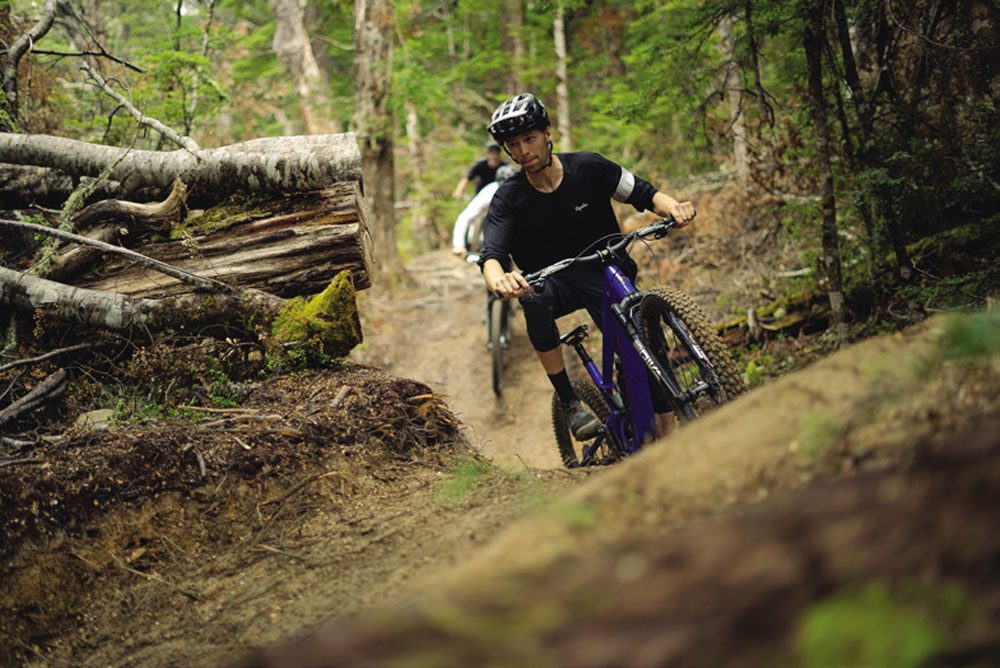
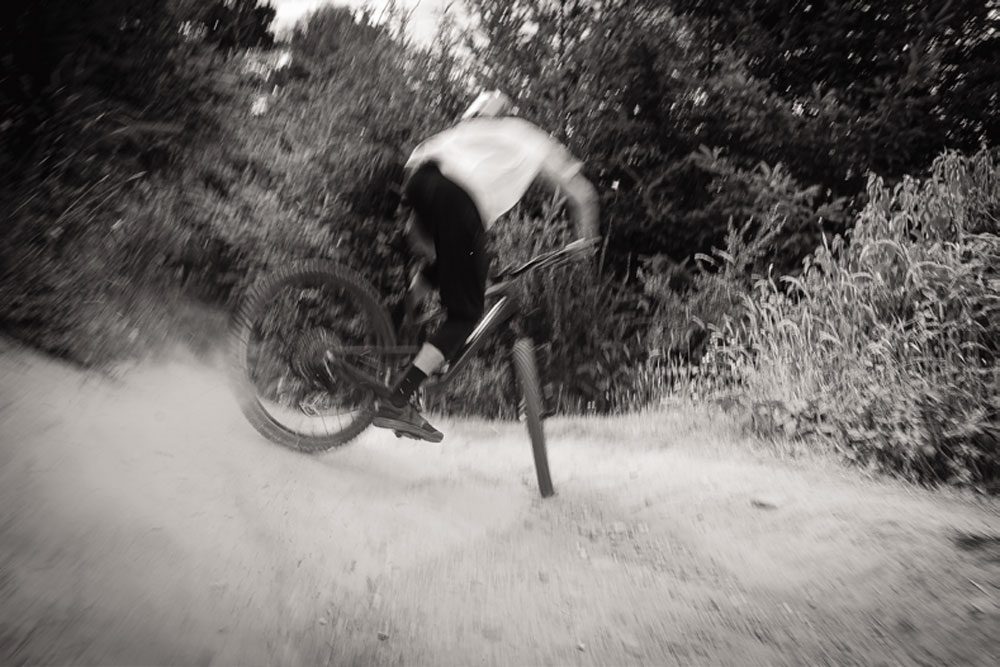

Double Everest
Words: Ben Hildred
Photography: Callum Wood
On February 26 this year, I set out to ride a double Everest: 17,698 vertical metres in a single bike ride, off-road, using a loop that incorporated a series of my favourite mountain bike trails in Queenstown. Double Everesting has been done before on road bikes, so I knew it was possible, but I wanted to know how it felt, where it would take me, and what it would be like scaling a mountain on-trail, and descending technical singletrack, time after time.
My lap started at the lake front and climbed up to the access road on Queenstown bike park. I’d then pedal the full access road, onto the ‘Beeched As’ singletrack, then follow the walking track up to Ben Lomond Saddle. Once at the saddle, I could descend, first on ‘Upper Missing Link’ – an alpine, rocky, tech singletrack – then on ‘Lower Missing Link’, a flowing, open trail that met the beech forest half way down before hooking onto ‘Creaky Winders’ which is more blue/black tech winding through the forest. When the trail met the creek, I’d turn left onto the Fernhill Loop trail until reaching ‘Hammys’, a flow trail to get to the midway clearing of the bike park. At midway I’d drop into ‘Thundergoat’ before taking ‘KY’, a steeper chute line, finishing off with ‘Trouser Snake’ – everyone’s favourite black tech pinch to meet the road and the bottom of the bike park.
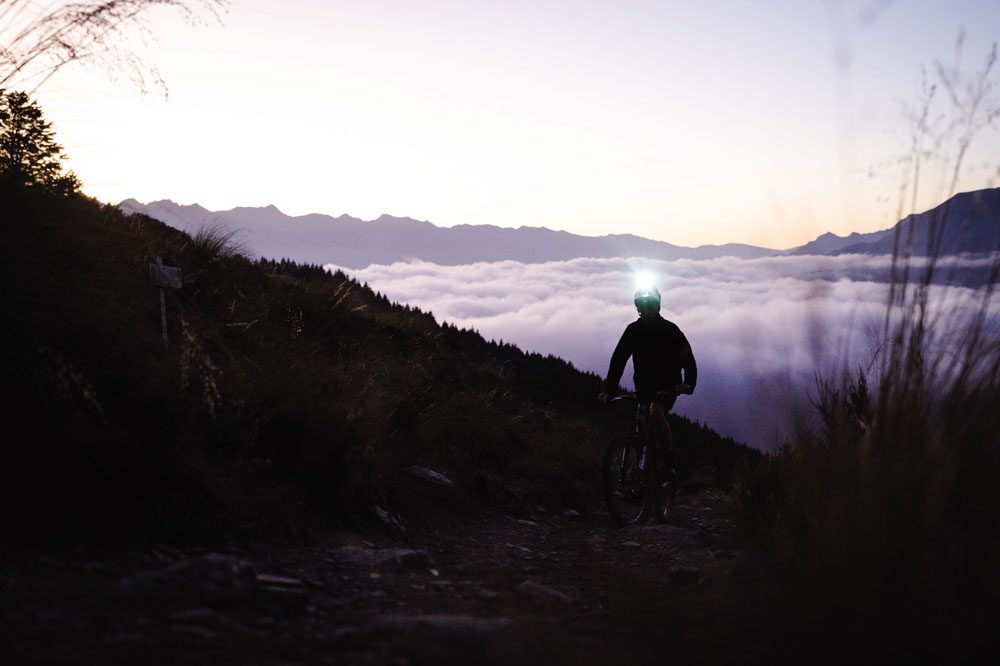

After sixty plus hours of sleep deprived pedal of sleep deprived pedal turning, events felt a turning, events felt a little less cohesive and little less cohesive and the world nonuniform.
After sixty plus hours of sleep deprived pedal turning, events felt a little less cohesive and the world nonuniform; laps were completely forgotten, time didn’t pass the same, my bike moved differently beneath me, and body parts became numb, cold, and alien. Walking was novel and eating was the only chore that hindered the new norm – making circles with my feet.
12:00am, February 26th. Wakatipu lake front; a navy sky diluted by street lights. Calm. About to pedal more than I ever have. Bike ride begins.
1:10am. First ascent complete, Ben Lomond saddle. The distant constellation of Queenstown feels incandescent, a familiar glow in comparison to the Milky Way, floating and exposed above. Some 1000 metres of elevation every lap. First lap far too fast, overly excited. Headlight exposes the descent; black singletrack snakes a dark bottomless ridge-line, insisting pensive focus.
6:58am. Daylight emerges over the silhouetted Remarkables, the solid black gate generously sur- rendering first light to Queenstown. Far enough into lap four to be above the cloud, an inversion making the repetition of pedalling feel accomplished so early on. First three laps a sub two hour loop, productive yet unsustainable, remembering to eat little and often. Positive, full and eager.
1:10AM The distant constellation of Queenstown feels incandescent.
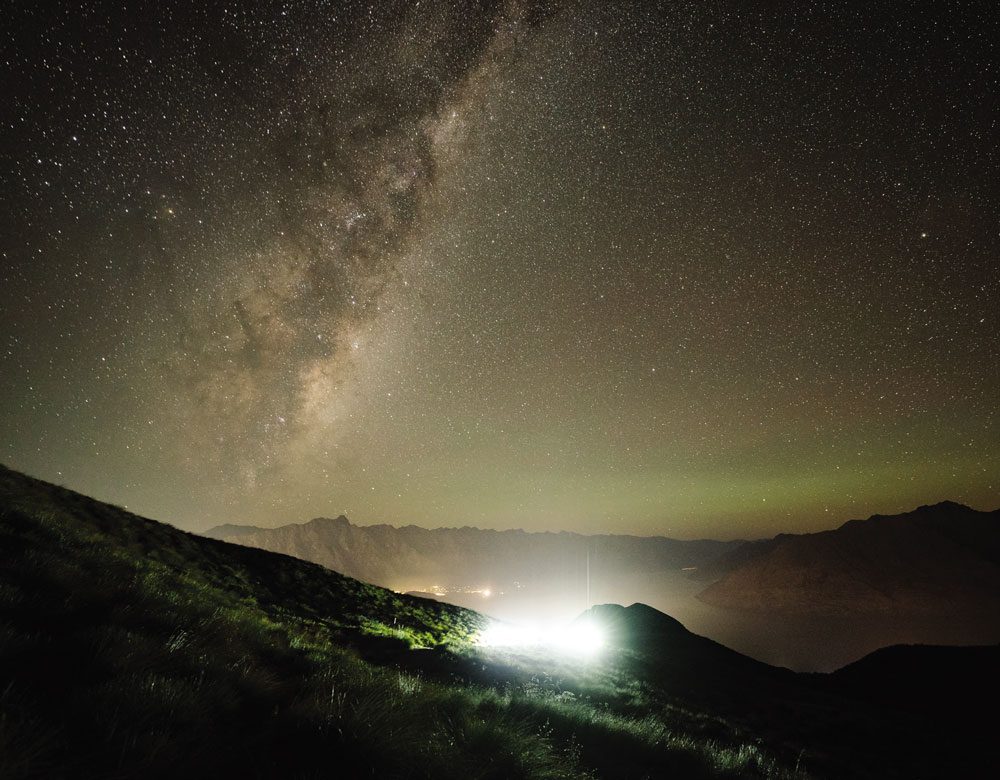
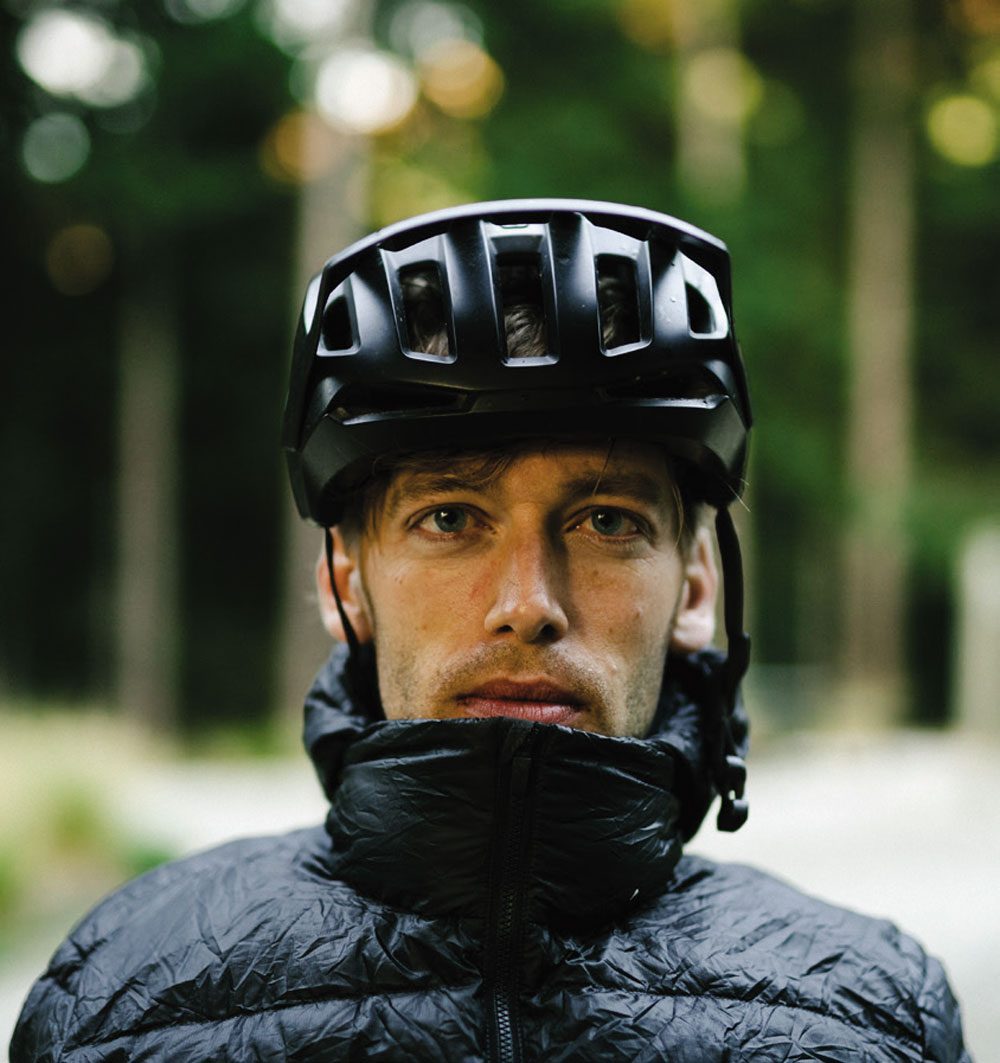
1:37pm. Midday. Progress has settled down to a comfortable churn of familiar and trusting trail. I’m 6100m elevation in. Tried eating one of my pre- made marmite, peanut butter and spinach wraps – swallowing that cocktail of stodge the hardest task so far. Still, onwards and upwards. Grateful for the necessary lathering of suncream needed for the hour of alpine exposure coming up, beautiful weather. Thoughtful and focused.
5:11pm. Soon to tick over 8000 metres. Stopping in the last patch of beech forest before the now relentless exposure of the loops summit, Ben Lomond saddle. Looking for my hidden backpack stashed in the bush, vital for the last push and descent. Chocker with food, water, smoothie and essen- tials. It had been taken. Later found to be a good Samaritan naively handing in lost property. Visibly, mildly distressed I was approached by a young family with a backpack baby, insisting wildly generous help. Lap fuelled by wildberry baby food. Thankful and persistent.
7:36pm. Top of lap nine, a big crew of good sorts see me over the first Everest, savouring the energy, anticipating looming darkness. The shadow of Ben Lomond slowly swallowing up my trail. Hasty to avoid the chill, we descended straight away in a train of hoots and hollers, harnessing everyone’s stoke to get me up here another eight times. Grateful and brimming. Onto new, untrod territory.
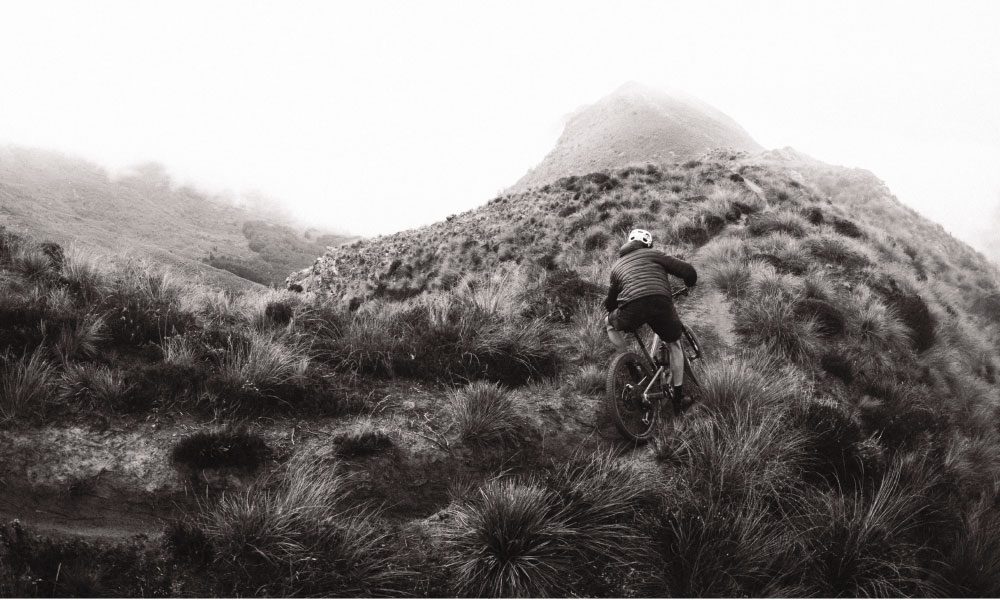
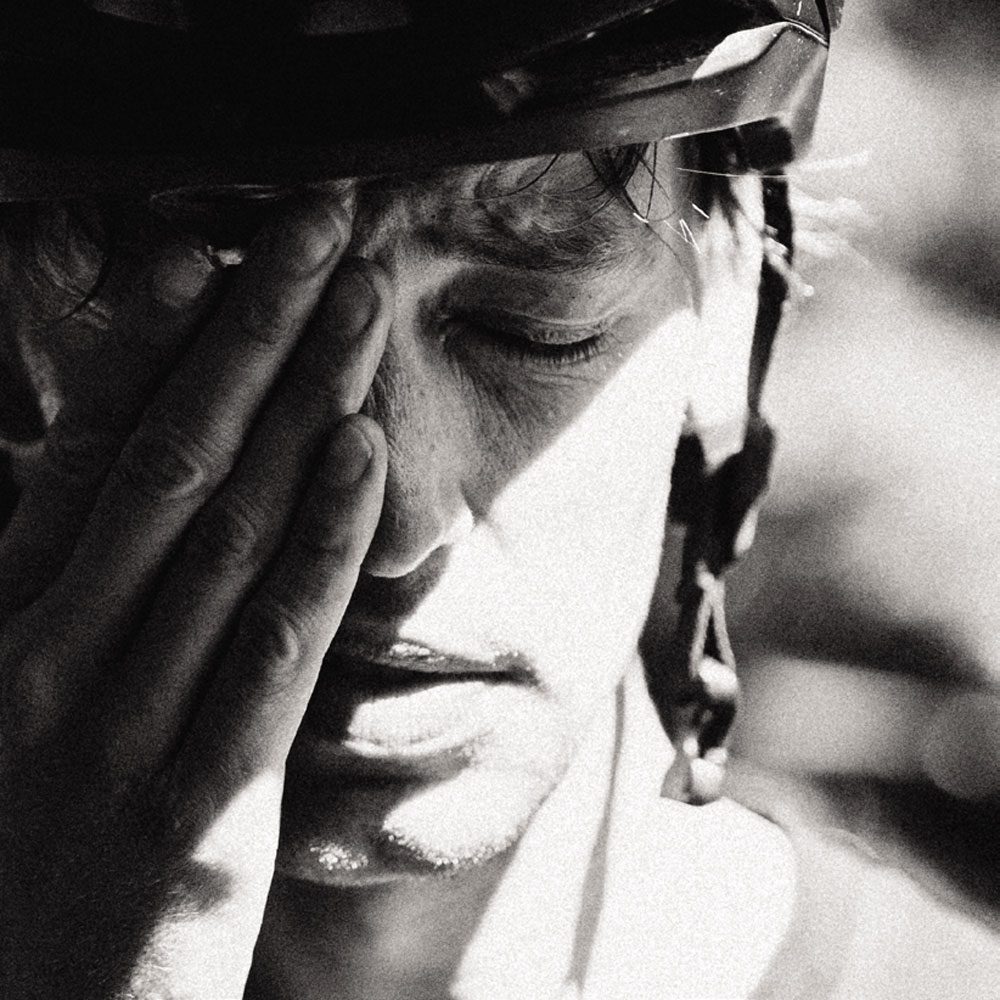
Distance: 277.56 km
Moving Time: 41:28:53
Avg Speed: 8.3 km/h
Elevation Gain: 17,925 m
Avg Power: 198 W
Calories: 26,531 Cal
Bike: Santa Cruz Tallboy
1:10am. The second night. Soon to turn over 10,000 vertical metres, willing myself to carry on. The short sighted dark compounded with a distinct and concerning drop in temperature, battling the natural circadian urge to sleep. First attempt to have a nap, I set an alarm for fifteen minutes. It went off instantly. With phone still in my hand, unsure whether I’d slept, whether my thoughts had been dreams. I’d push to the top in great company, words were few and far between, all energy used to go forward. The mountains now sleeping, shadows framing another feast of stars. Numb, though now very invested.
Two, three, four? Maybe five? The next couple of laps I cannot recollect, somehow I’d chalked up another two thousand metres with two full loops. The only thing I remember was being laid in dry, dead pine off the side of the trail where I’d fallen. Somehow, on the climb, I’d taken a tumble. Still unsure whether it was a handlebar nap or poor coordination. Thankfully unscathed, and pulled back up to safety, we carried on. I’m indebted to Jamie and Annie and their company that entire night; their selfless, duty-bound help got me through.
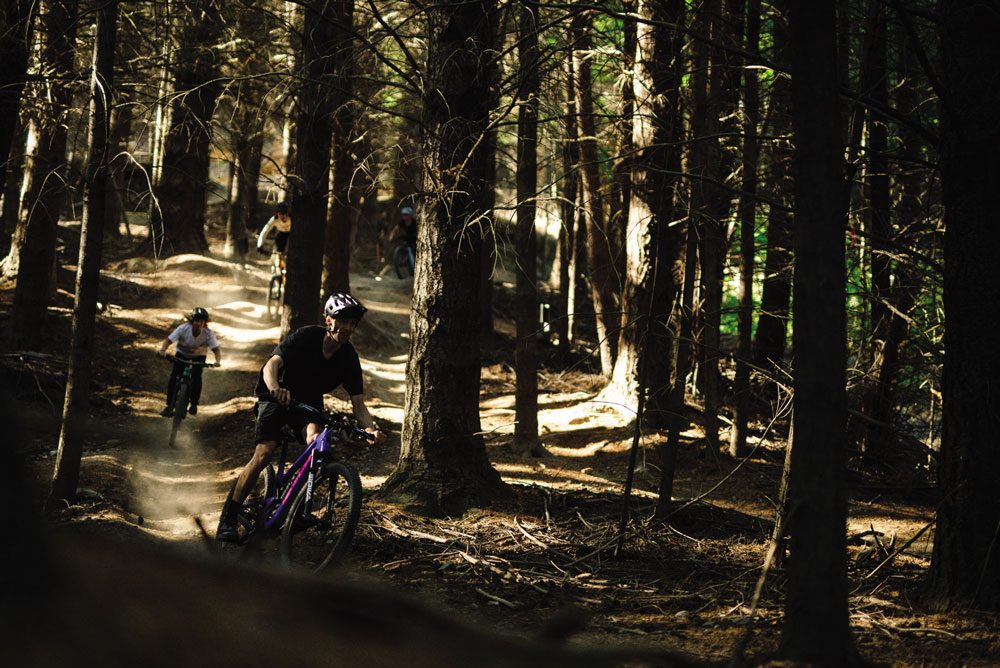
5:11PM Thankful and persistent.
After that minor ordeal, roughly five in the morning, we were gifted something so superlative it got me brimming with joy. Our mate, Steve, met us halfway up a mountain. Still dark, his head torch illuminated the steam rising from three ready-made Yorkshire teas, sat trailside. The sun was on its way, the metres were disappearing, my body was waking up and it tasted like victory. Relieved and excited for first light.
7:30am. Not out the woods yet. I would say I know the Skyline access road better than anyone, but, majorly sleep deprived, this well-trod road threw a few curve balls. In the early hours of light, just before mid-way and in the nick of time, I spotted a deep, clear water moat, impassable and flowing over the road. I was hallucinating.
Grabbing a handful of brake, I almost came to a stop before it disappeared. I made a more considered effort to keep my head high and look ahead, setting small goals to pedal towards and keep my mind occupied and focused. Luckily, I had my head held up, as no sooner had the moat disappeared a series of unevenly placed wooden door frames jumped out at me. With my peripheral vision absent, it took my upmost attention to swerve and weave through them. The oddest experience and the last of that carry on for the remainder of the ride. Confused and bemused we rode on.
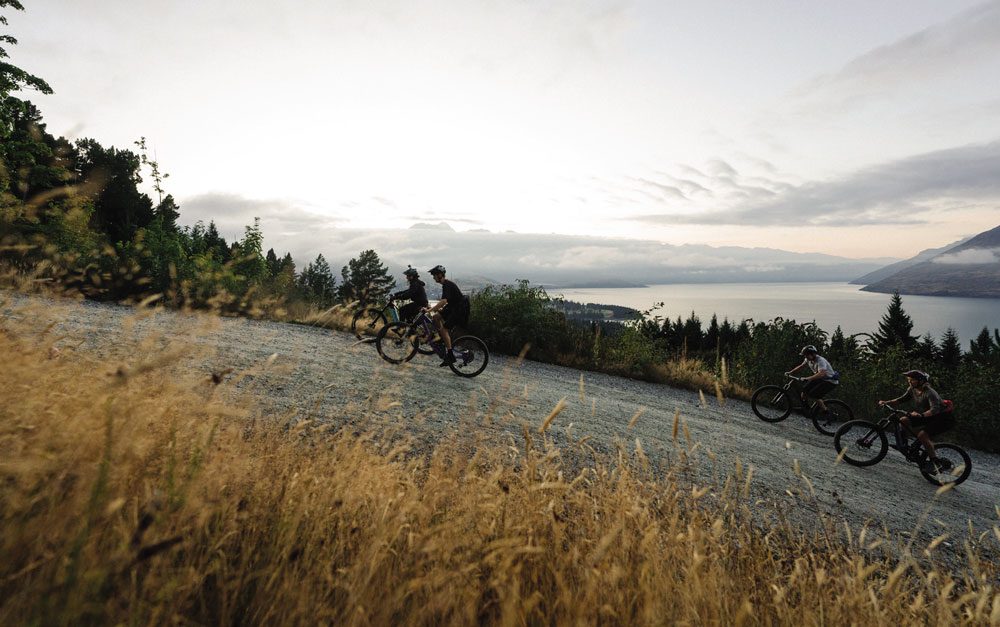
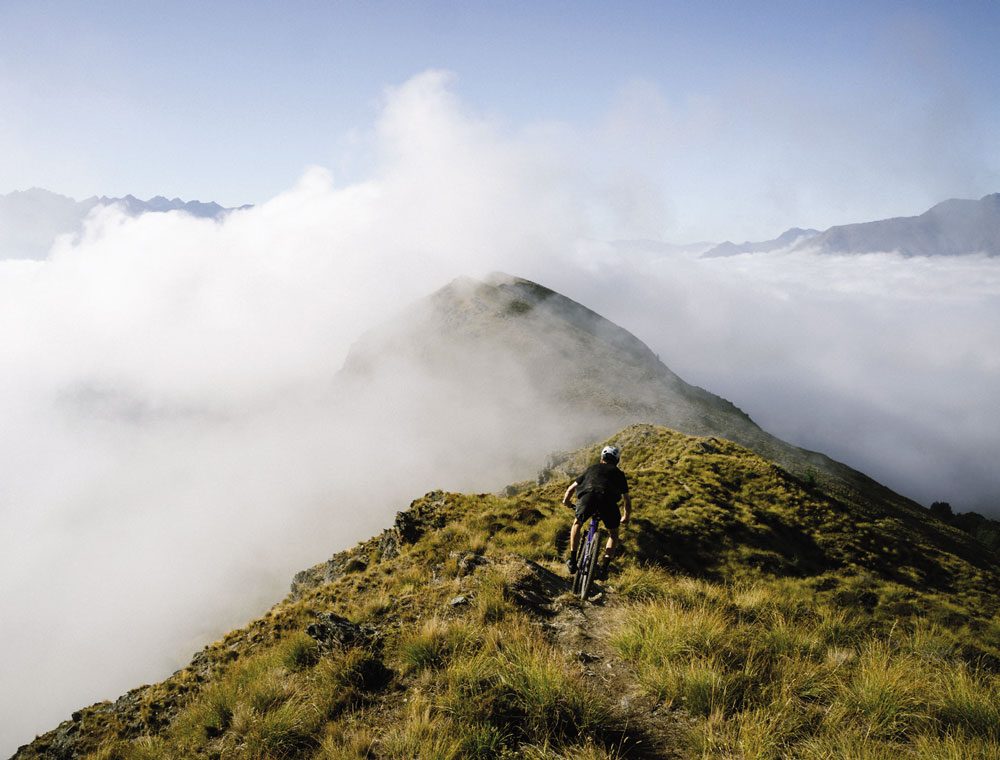
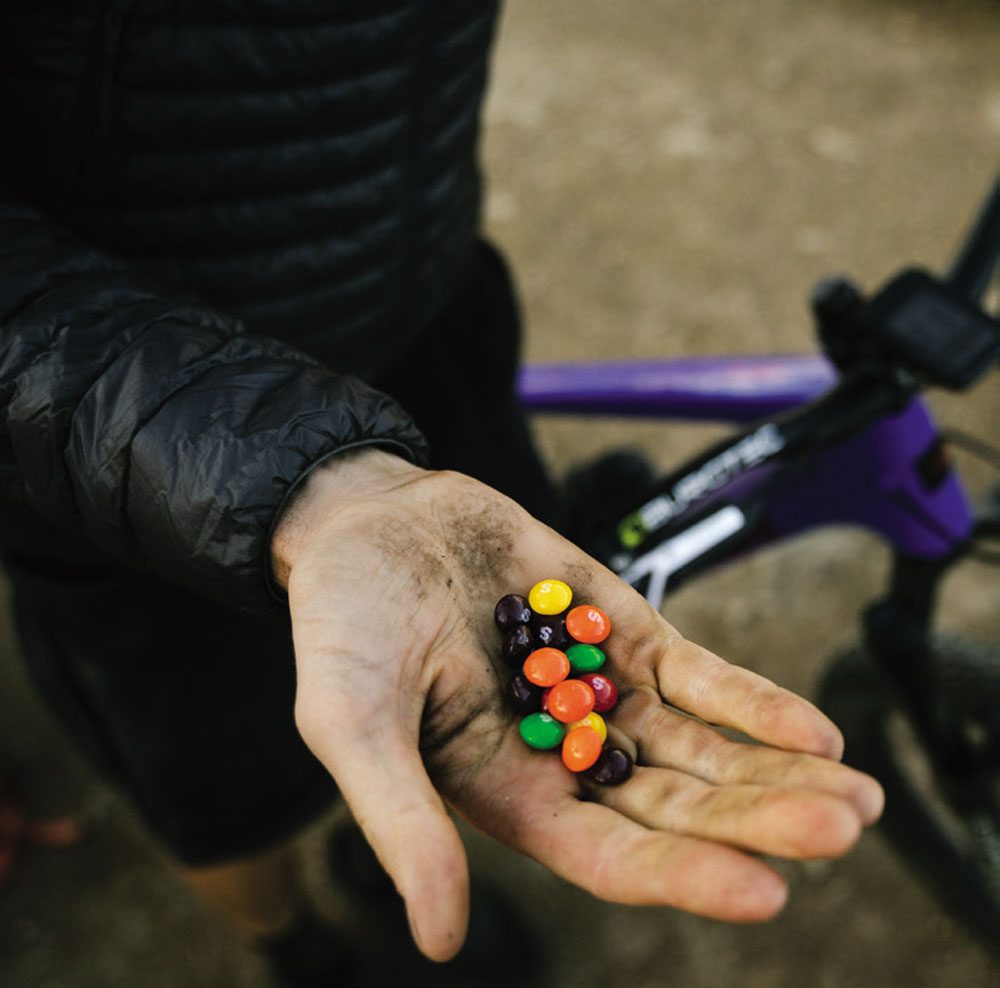
Visibly, mildly distressed I was approached by aI was approached by a young family with ayoung family with a backpack baby, insistingbackpack baby, insisting wildly generous help.
2:11pm. After first light’s free spirited bohemian lap, the morning felt rather uneventful; chugging along the tracks of my route like a steady and conservative diesel engine. Time soon passed, as did the metres. Almost 14,000 metres in, I got to midway, where I’d allow myself a rest and recoup. It was on this lap an uncomfortable and grounding pain made me feel very human and quite frail. Familiar with the occasional heart murmur, I knew this thud in my chest and erratic, offbeat rhythm should be okay, although it always makes you acutely and presently aware of your mortality. Conscious this could be an issue, I had a small Bluetooth device with me that takes ECG recordings. Held tight between my thumbs it came back with ‘atrial fibrillation’. I chose to rest a bit longer that lap before carrying on, back on task – some would say foolishly.
4:15pm. In charge of photography, and one of my consistent good sorts keeping company for this pedal, Callum noted I’d run out of water high up the climb and, without hesitation, slogged a 10 litre barrel of water up the mountain in his camera bag. What a champ, The sun was still blinding and aggressive. I’d been awake without any proper sleep for around 55 hours now, climbed over 15,000 metres and descended over 100km of mountain bike trails. I felt completely hollow, the bottom of the barrel had been scraped dry. It became very easy to distinguish between my physical, mental and emotional energy. In rhythm, I’d scoop into each energy source one at a time while the others did their best to recover. You could switch easily from a mindset of body, concentrating on making circles with your feet and pushing down past the ground, to a mindset of determination, trust and belief, always mindful to eject that energy reserve for another before any wavering internal apathy kicks in. It became a fragile juggling act – anyone who tried to help or support me during that period was met with someone quite silent and vacant, a shell of the person they had planned to see, but understanding – I hoped – that as grateful as I was, I didn’t want to see anyone for a short period as I couldn’t give them the gratitude and thanks they deserved for helping me out. Burnt out and dry, so close.
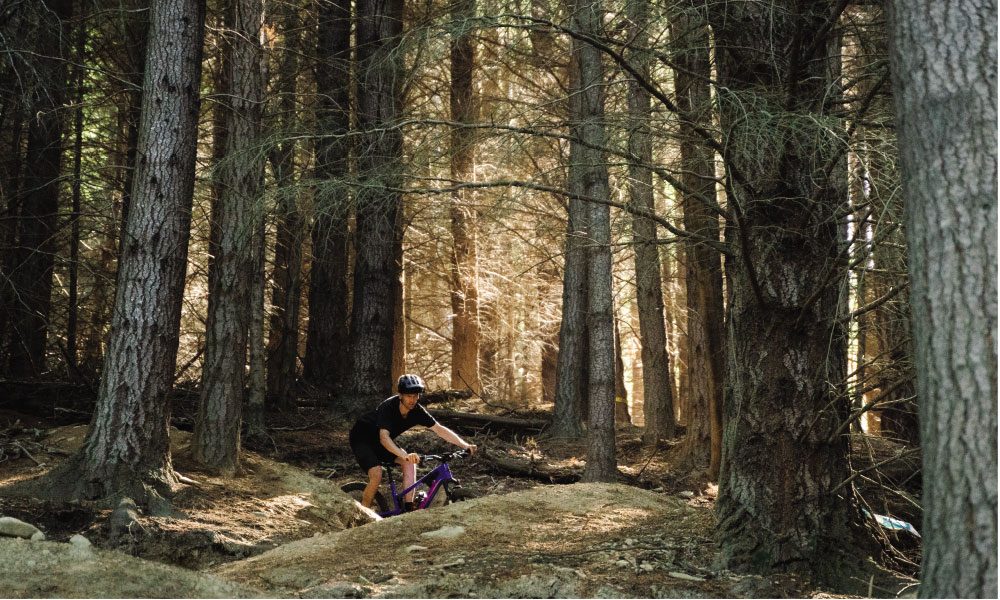
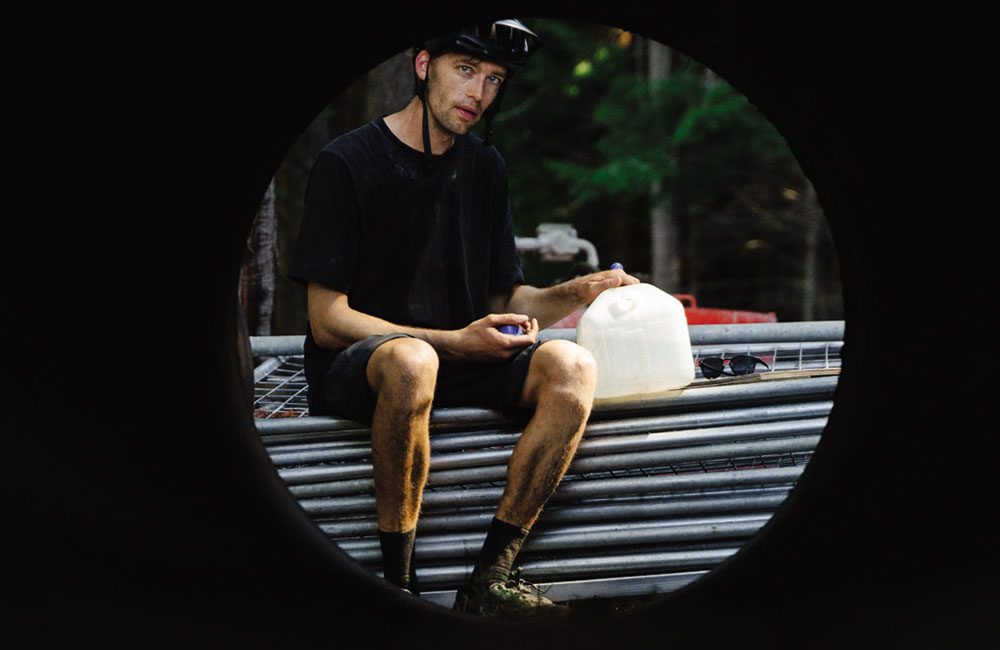
Grabbing a handful of brake, I almost came to a stop before it disappeared. I made a more considered effort to keep my head high and look ahead, setting small goals to pedal towards and keep my mind occupied and focused. Luckily, I had my head held up, as no sooner had the moat disappeared a series of unevenly placed wooden door frames jumped out at me. With my peripheral vision absent, it took my upmost attention to swerve and weave through them. The oddest experience and the last of that carry on for the remainder of the ride. Confused and bemused we rode on.
6:38pm. The bottom of the final full lap. A group of familiar, friendly faces greeted me there and the team grew as we climbed higher together. What a treat to have so much encouragement and help from the incredible community here in Queenstown. By the time we reached the summit, the Remarkables mountain range wore an red evening glow, and Ben Lomond above us sheltered the sun. Everything felt it was coming to an end. Sharing that last full climb with friends was extra special, many moments there are forever held in memory. I was 17,300 meters in and feeling my last ‘second’ wind as we all descended together. So grateful and appreciative.
9:10pm. The last push. I couldn’t close the loop off nice and neat at the top of the last full lap, so still had a few hundred metres to find. It was getting cold, fingers pained after that descent, determined not to go into a third night. Most of last lap’s crew were now invested and seeing it out until the end. Together we climbed, again. This time round, my focus was sharply squared at my cycling computer, watching the metres fall away, navigated by the sound of people talking around me, a comforting echolocation on a road I know all too well.
The last hundred metres never seemed to stop. By this time everyone wanted to know the score, nothing else made any sense.
Eventually, finally, at the end of the beech forest, I’d ticked over the double Everest. Pausing and uploading the ride data, I sat on a rock I’d used at a rest stop every lap. Unsure how to think or consider the bike ride, I felt underwhelmed and disappointed in my lack of enthusiasm or stoke, unable to show any joy or thanks to everyone who was there to share the moment, who made the effort to see it out. All I wanted to do was go home, shower and sleep. Maybe everyone was expecting an emotional spew of relief or elation, but all tanks were empty. It was done.
I’d like to thank Jonny Ashworth and Callum Wood for documenting the ride with video and photography, being there to help and witness it all. Annie Ford for being with me throughout and providing the upmost support – making sure I ate, drank and didn’t fall off – what a trooper. Jamie McKay, who always offers the most incredible company on the toughest days, unwavering, and went on to do an Everest of his own while riding with me, incredible! Thanks to everyone else who showed willing and came along for a pedal, it made the experience unforgettable. Thank you.
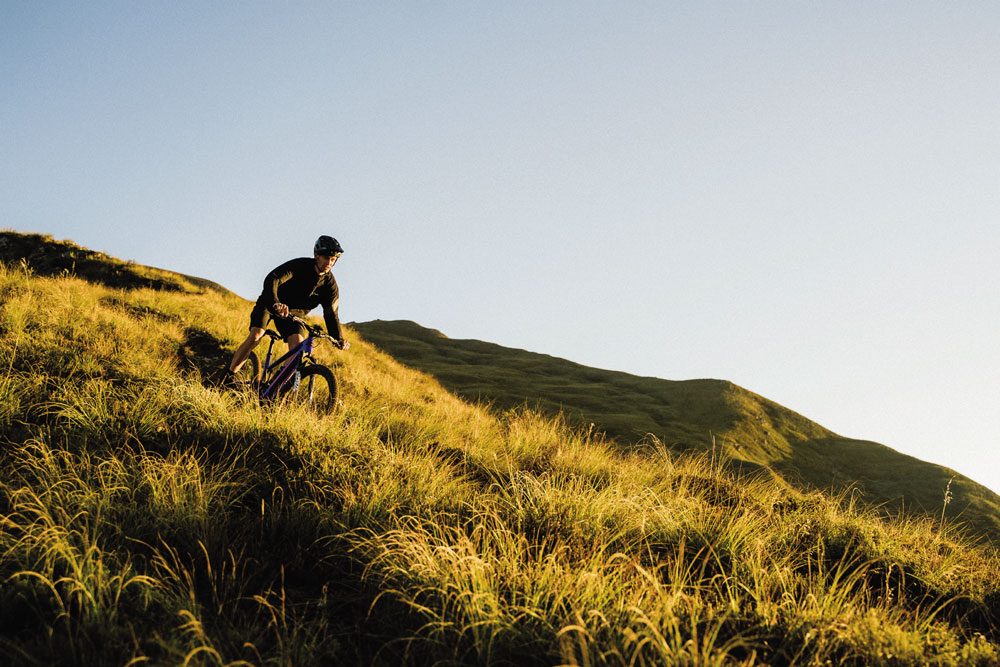
5:11PM It became very easy toIt became very easy to distinguish between my physical,distinguish between my physical, mental and emotional energy.mental and emotional energy.
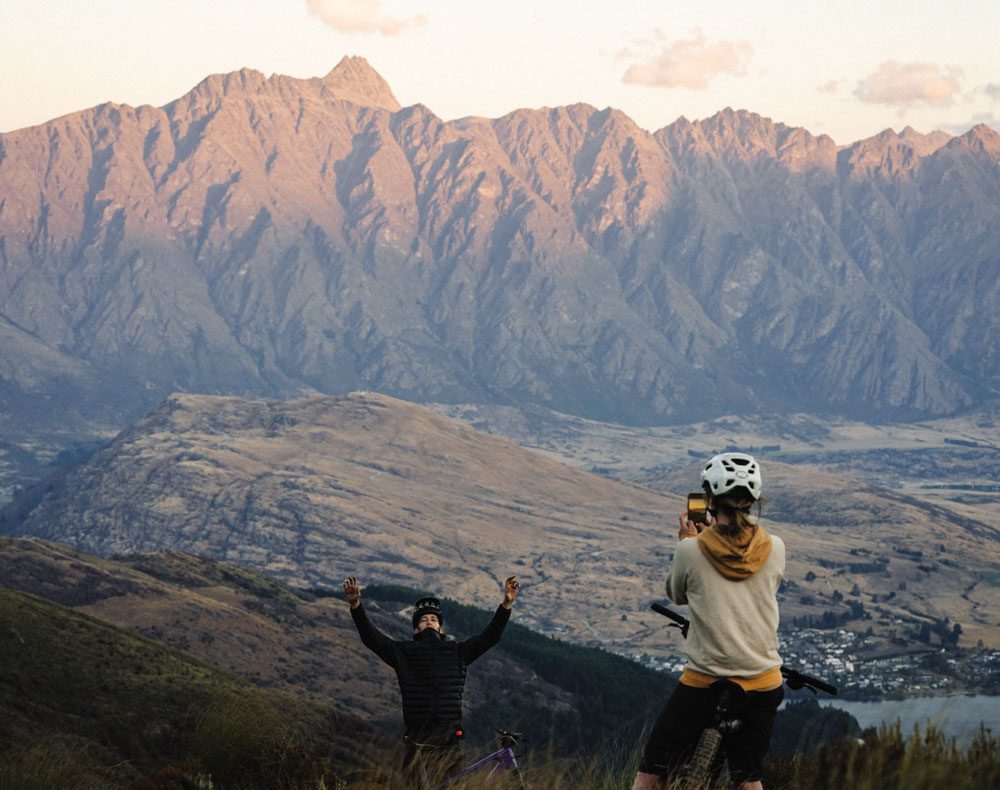
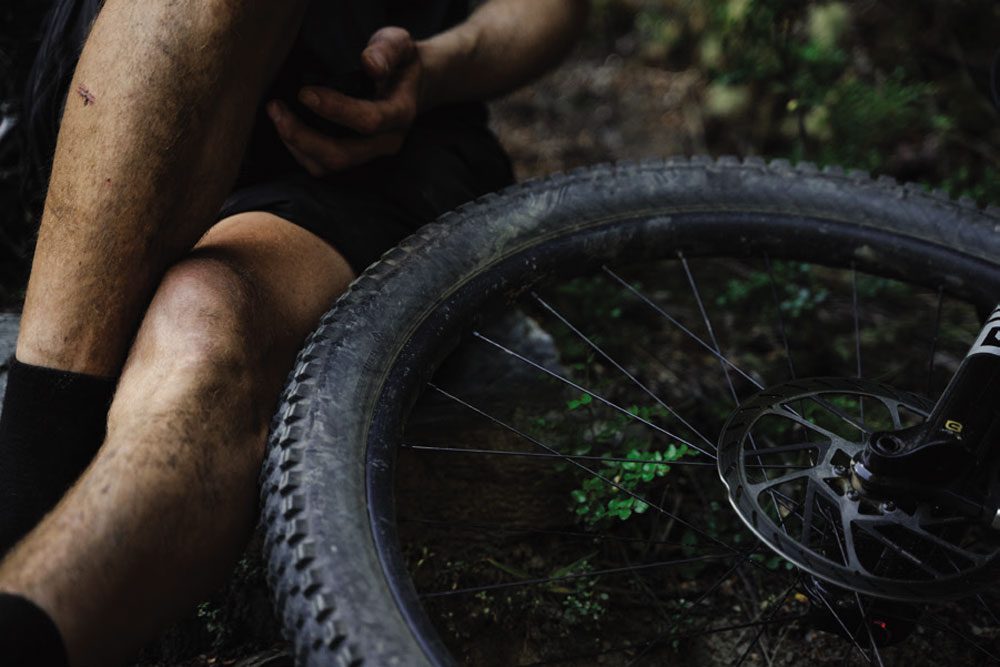
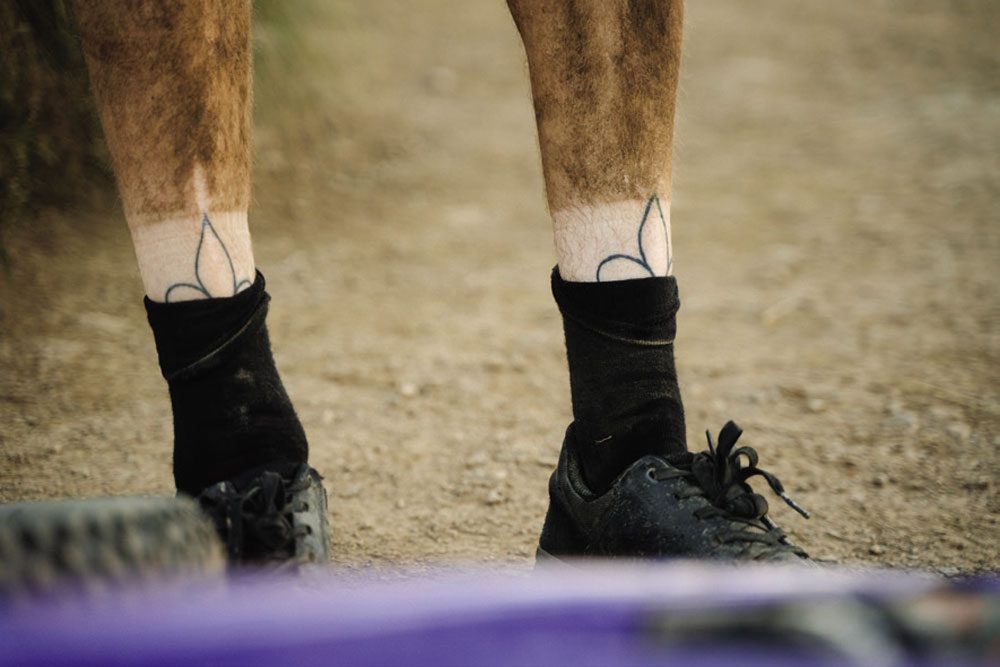
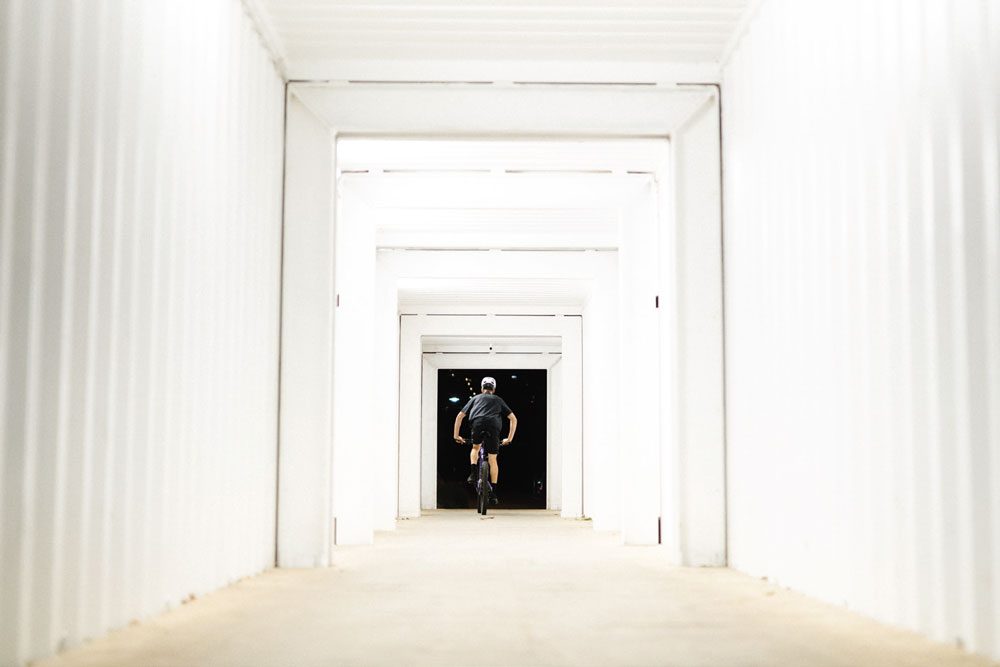
Thanks to everyone else who showed willing and came along for a pedal, it made the experience unforgettable. Thank you.
